- Analytics
- News and Tools
- Market News
CFD Markets News and Forecasts — 14-02-2022
- Gold bulls stampede towards critical resistance on the heightened risk of a Russian invasion of Ukraine.
- US Federal Reserve will aggressively hike rates in coming months.
The price of gold rallied to the highest level since November 16 on Monday on growing worries about Russia-Ukraine tensions despite the call from St. Louis Federal Reserve President James Bullard for faster US Federal Reserve interest rate hikes. XAU/USD reached $1,874 on Monday in afternoon trading in the New York session, extending its gains from last week's close.
The markets are on high alert as the tensions surrounding the Russian military build up on the border of Ukraine is raising the probabilities of an imminent attack. Ukraine President Volodymyr Zelenskiy urged Ukrainians to fly the country's flags from buildings and sing the national anthem in unison on Feb. 16, a date some Western media have cited as the possible start of a Russian invasion.
However, the comments were interpreted as if the president of Ukraine had been officially informed that Wednesday would be the day of the attack. This led to a bout of risk-off in markets but Ukrainian officials said Zelenskiy was not predicting an attack on that date, but instead responding with scepticism to foreign media reports. Washington had said Russia could invade Ukraine "any day now," and British Prime Minister Boris Johnson on Monday called the situation "very, very dangerous."
Meanwhile, United Nations Secretary-General Antonio Guterres said he was deeply worried about "increased speculation" about a military conflict and has urged world leaders to step up diplomacy to calm the situation.
Gold technical analysis
As per the pre-open forecast for the week ahead, Gold, The Chart of the Week: $1,880's are eyed as last defence for continued upside, the $1,880's are calling the bulls as follows:
Gold, daily chart, prior analysis
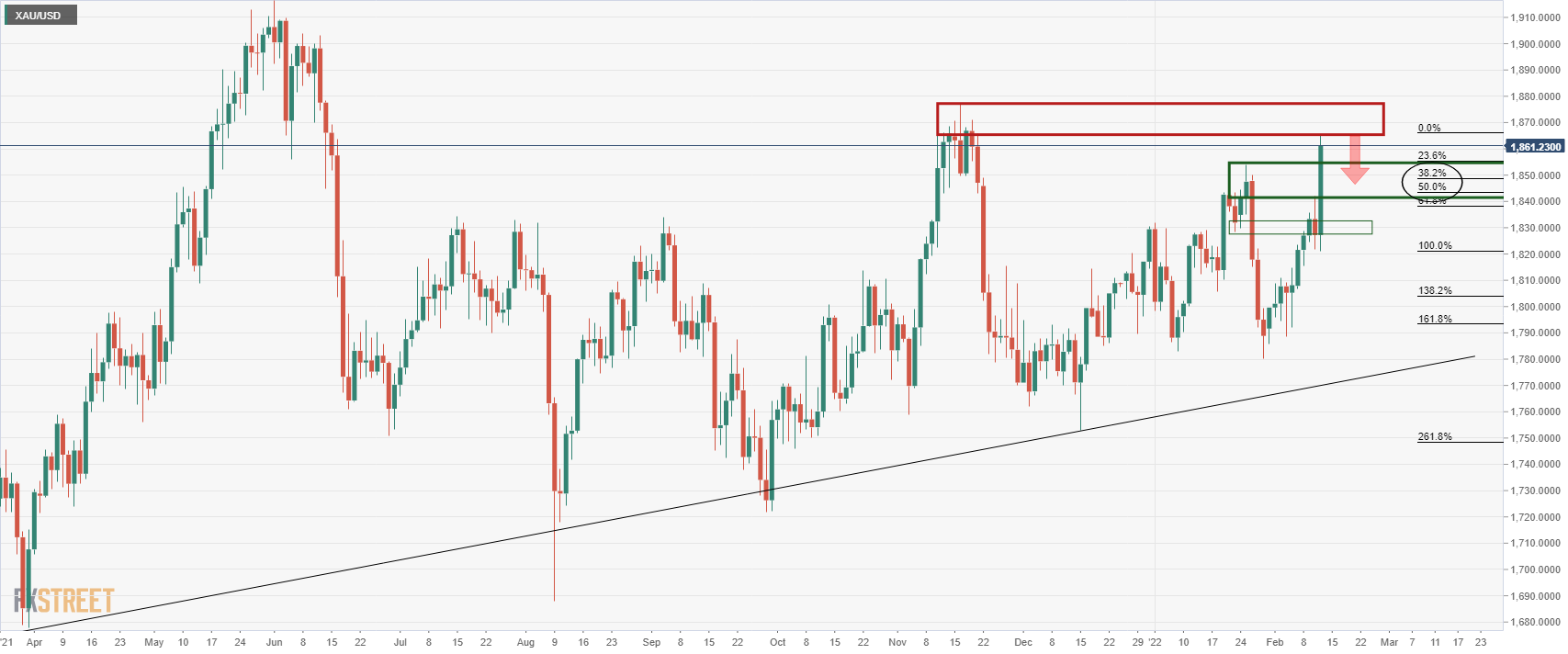
Gold, live market
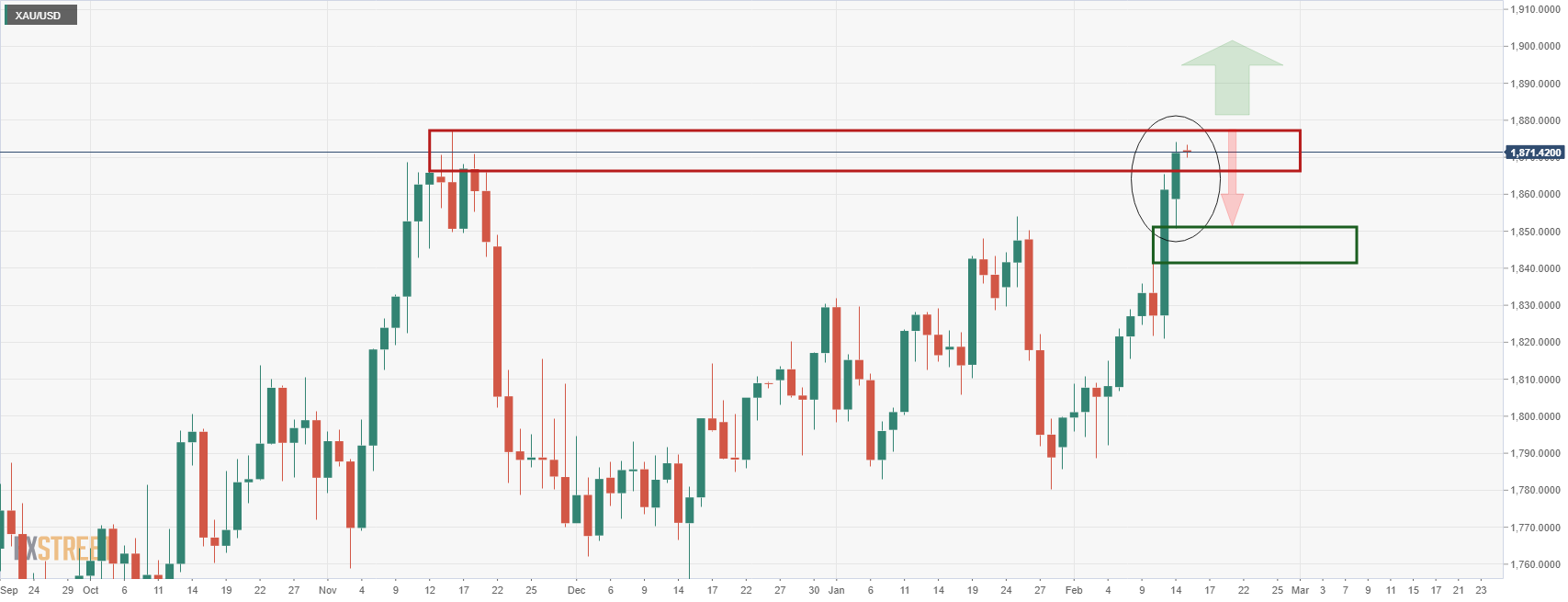
Typically, the price would be expected to correct at this juncture, but the ATR on the weekly chart is around $46.00 and it is early days in the week still. Gold has rallied $23.00 so far, so there is still room for higher.
- GBP/USD consolidates recent losses around one-week low, snaps two-day downtrend.
- UK trades more with US than France, Spain and Greece Combined in 2021 amid post-Brexit jitters.
- British Foreign Minister Truss warns over Russian invasion of Ukraine, UK reports 30% low covid infections in last seven days.
- UK jobs report, geopolitical and US PPI will entertain pair traders.
GBP/USD licks its wounds around 1.3530-35 with eyes on the key UK employment report during Tuesday’s Asian session. In doing so, the cable pair prints mild daily gains around a one-week low, after declining for the last two days.
The recent consolidation in the cable prices could be linked to the Brexit headlines and receding fears of an imminent war between Russia and Ukraine. However, inflation fears and Fed-rate-hike concerns join the indecision over the geopolitical issues to keep GBP/USD pressured.
The UK Express cites the latest trade numbers from the UK Office for National Statistics (ONS) to confirm that Britain did more trade with the US than France, Greece and Spain combined. The news adds to the British bargaining power while the Brexit talks are on. On a different page, British Foreign Minister Liz Truss warns Russia could launch Ukraine invasion ‘almost immediately’, per The Guardian.
On the same line, the Western leaders initially highlighted fears of Russia’s attack on Ukraine during this week before market chatters of February 16 to be the D-day. On the positive side were headlines covering Russian Foreign Minister Sergey Lavrov who told President Putin that the US had put forward concrete proposals on reducing military risks and that he could see a way to move forward with talks. Russia’s Lavrov also mentioned that EU and NATO responses have not been satisfactory, which in turn highlights risk-off mood despite easing fears.
Furthermore, a 30% reduction in the seven-day average infections and around 27.0% decline in the virus-led deaths highlight improving covid conditions in the UK and help GBP/USD buyers. However, British scientists keep flashing warnings over the virus variants.
Elsewhere, St. Louis Fed President James Bullard reiterated his call for 100 basis points (bps) in interest rate hikes by July 1 by citing the last four inflation reports which show broadening inflationary pressures.
Amid these plays, the US Treasury yields regained upside momentum after stepping back from a 2.5-year high on Friday whereas the Wall Street benchmark closed in the red, despite mildly positive week-start performance.
Moving on, UK employment figures will pave the way for the March rate hike by the Bank of England (BOE), making it important for the GBP/USD traders. That said, the headline Unemployment Rate is expected to remain unchanged at 4.1% whereas the Claimant Count Change needs to improve from -43.3K prior to keep the buyers hopeful.
Technical analysis
GBP/USD remains sidelined inside a 100-pip trading range between the 100-DMA and 1.3600. Given the recent rebound in the Momentum indicator, the pair buyers seem to flex muscles ahead of the key data/events.
- The New Zealand dollar falls on risk-off market mood against the safe-haven JPY.
- On Monday’s overnight session for North American traders dropped 100-pips.
- NZD/JPY is downward biased after failure at the 100-DMA, which spurred a fall of more than 150 pips.
The NZD/JPY slides for the second consecutive day courtesy of a risk-off market mood spurred by increasing geopolitical tensions between Russia and Ukraine, down 0.35%. At the time of writing, the NZD/JPY is trading at 76.40.
During the overnight session for North American traders, the NZD/JPY plunged close to 100-pips, towards 75.80, as the headline news of the Russian invasion of Ukraine, which dampened the market mood near last Friday’s close, caught Asian and European traders on the weekend. That said, the NZD/JPY reached a daily high at 76.86, followed by a fall towards 75.87.
NZD/JPY Price Forecast: Technical outlook
The NZD/JPY is downward biased from a technical perspective, sponsored by the daily moving averages (DMAs) residing above the spot price. That, alongside the failure of a daily close above the 100-DMA on February 10 at 78.37, exacerbated selling pressure on the NZD/JPY, threatening to push prices near August 2021 to swing low at 74.56.
Therefore, the NZD/JPY path of least resistance is tilted downwards. The cross-currency first support level would be the February 14 low at 75.87. Breach of the latter would expose February 3 daily low at 75.58, followed by January 28 pivot low at 75.23, and then the August 2021 swing low at 74.56.
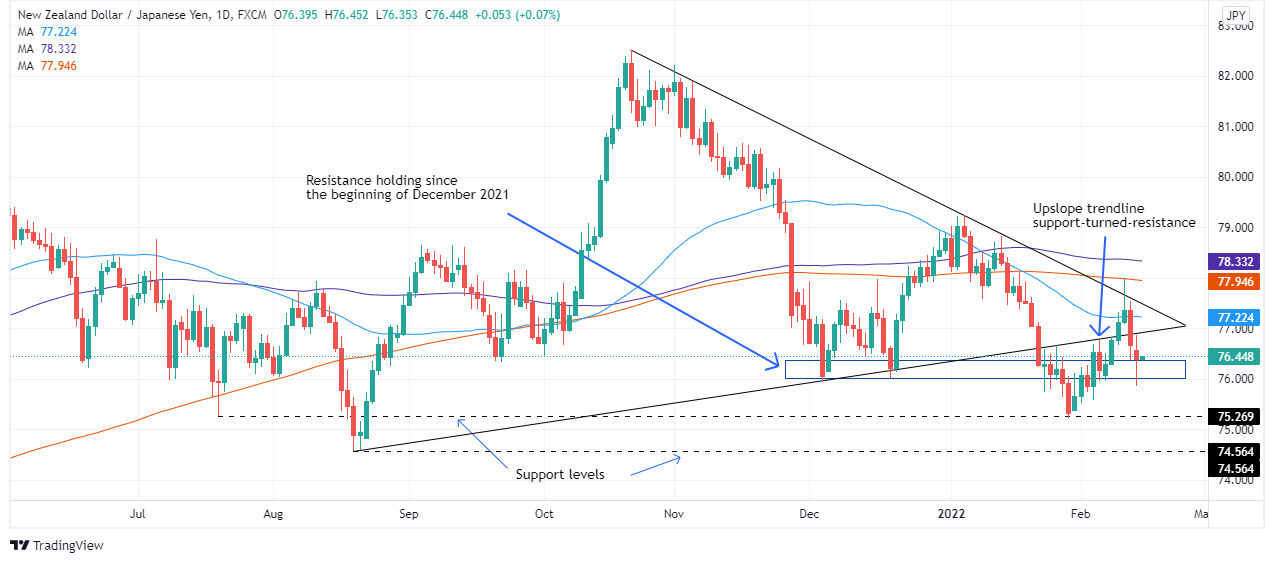
Given the risk-off mood and firmer US Treasury yields, analysts at the key banks reiterate their bullish bias for the USD/JPY prices.
Recently, Goldman Sachs (GS) reiterated their forecast for higher US rates to convey upside risks for the yen pair while saying, “We continue to expect USD/JPY to move higher in the near-term towards our 3-month forecast of 117.”GS also adds, “And may overshoot a bit if the Fed tightens more rapidly than currently priced.”
While rejecting the bearish bias, the investment bank mentioned, “That said, as the Yen weakens further, the odds of JPY-related policy guidance are likely to increase, and, therefore, we do not expect to see a sustained depreciation trend.”
It’s worth noting that the USD/JPY grinds around 115.50 ahead of the key preliminary Q4 GDP for Japan.
Read: USD/JPY is thrown around on interpretations of Ukraine's Feb 16 Russian invasion
US inflation expectations, as measured by the 10-year breakeven inflation rate per the St. Louis Federal Reserve (FRED) data, keep reflation fears on the table with its latest jump to the highest levels since January 12.
That said. inflation gauge rise to 2.48% at the latest while extending the slow grind to the north triggered since late January before flashing a three-month low.
It’s worth noting that St. Louis Fed President James Bullard reiterated his call for 100 basis points (bps) in interest rate hikes by July 1 by citing the last four inflation reports which show broadening inflationary pressures.
On the same line is the CME FedWatch Toll that suggests around 61% probabilities for a 50-75 basis points (bps) of a rate hike during the March meeting.
With this, today’s US Producer Price Index (PPI) for January, expected 9.1% YoY versus 9.7% prior, will be important for short-term market moves.
- Silver grinds higher around three-week top on looming bullish moving average cross.
- Upbeat MACD signals keep buyers hopeful, 23.6% Fibonacci retracement guards immediate upside.
- Sellers remain unconvinced beyond $23.00, January’s peak lure bulls.
Silver (XAG/USD) buyers take a breather around three-week high, taking rounds to $23.85-90 during the initial Asian session on Tuesday.
In doing so, the bright metal bulls attack 23.6% Fibonacci retracement (Fibo.) of December-January upside.
That said, the 50-SMA stays ready to pierce the 200-SMA, suggesting a bull cross, amid price-positive signals from the MACD.
Hence, XAG/USD buyers are waiting for the $24.00 breakout to excel further, which in turn will highlight the previous month’s top near $24.70.
Following that, the $25.00 threshold and November 2021 peak surrounding $25.40 will be in focus.
Alternatively, pullback moves may aim for the 38.2% Fibo. level near $23.45 but a convergence of the 50-SMA and 200-SMA, as well as the 50% Fibonacci retracement, highlights $23.05, as the key support level.
Also acting as a downside filter is the $23.00 round figure, a break of which will welcome XAG/USD sellers targeting a monthly low of $22.00.
Silver: Four-hour chart
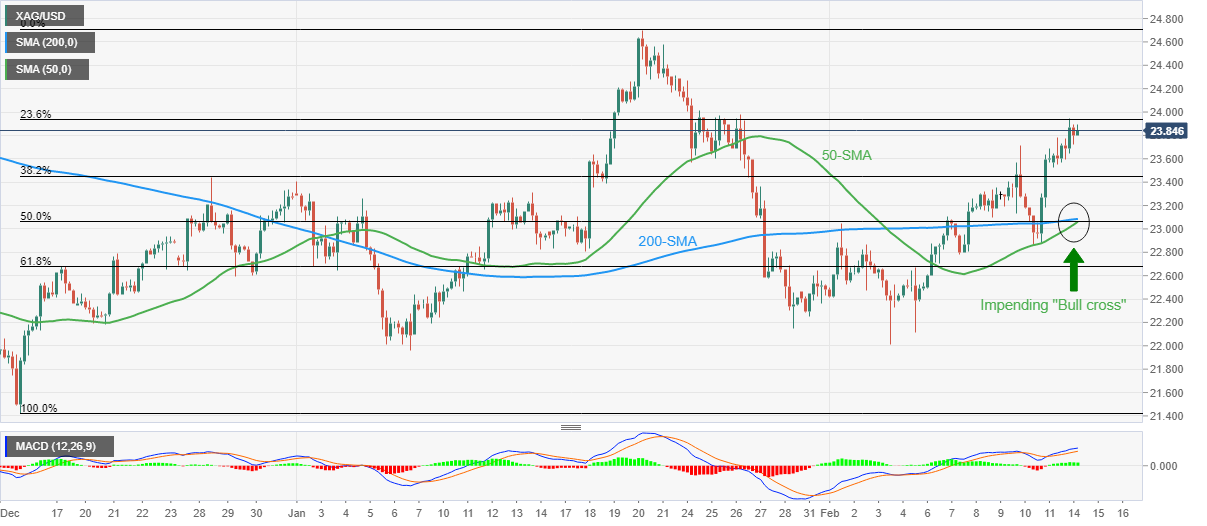
Trend: Further upside expected
- NZD/USD fades bounce off one-week low, remains pressured after three-day downtrend.
- Anxiety over Russian invasion of Ukraine unpins safe-haven demand of gold, USD.
- Mixed NZ data, Fedspeak also play their role to keep bears in command.
- Geopolitical headlines, US PPI may entertain traders ahead of next week’s RBNZ.
NZD/USD buyers are unsure of their returns, mainly due to the risk-off mood, by staying defensive around 0.6615 during early Tuesday morning in Asia. Even so, the Kiwi pair pauses the previous three-day downtrend while taking rounds to the lowest levels since February 04 marked the previous day.
Global markets witnessed a shaky start of the week, portraying the risk-aversion wave, as fears of the Russian invasion of Ukraine keep fueling the safe-havens like the US dollar and gold while weighing on the Antipodeans. It’s worth noting that the US Treasury yields regained upside momentum after stepping back from a 2.5-year high on Friday whereas the Wall Street benchmark closed in the red, despite mildly positive week-start performance.
Talking about the Moscow-Kyiv story, the Western leaders initially highlighted fears of Russia’s attack on Ukraine during this week before market chatters of February 16 to be the D-day. On the positive side were headlines covering Russian Foreign Minister Sergey Lavrov who told President Putin that the US had put forward concrete proposals on reducing military risks and that he could see a way to move forward with talks. Russia’s Lavrov also mentioned that EU and NATO responses have not been satisfactory, which in turn highlights risk-off mood despite easing fears.
Elsewhere, St. Louis Fed President James Bullard reiterated his call for 100 basis points (bps) in interest rate hikes by July 1 by citing the last four inflation reports which show broadening inflationary pressures.
On the economic calendar, New Zealand’s Business NZ PSI eased in January whereas Food Price Index and REINZ House Price Index both improved during the stated month. Further, the Visitor Arrivals in December rose from 3.8% prior to 4.4% YoY.
Against this backdrop, analysts at ANZ said, “Despite slowing housing and risks to the activity outlook, the inflation impulse provides plenty of reason for the RBNZ to stay the course with OCR hikes.”
Looking forward, US Producer Price Index (PPI) for January, expected 9.1% YoY versus 9.7% prior, will join Empire State Manufacturing Index for February, market consensus 12 versus -0.7% previous readouts, to decorate the daily calendar and direct short-term NZD/USD moves. However, major attention will be given to the Fedspeak and risk catalysts.
Technical analysis
A clear downside break of a 12-day-old ascending trend line directs NZD/USD prices towards 2022 bottom surrounding 0.6530. However, February 04 low near 0.6590 may offer an intermediate halt during fall.
Alternatively, 21-DMA and the latest swing high, respectively around 0.6660 and 0.6670 in that order, will restrict corrective pullback of the Kiwi pair.
- The shared currency falls for the second straight day, weighed by geopolitical concerns and US dollar strength.
- The US Dollar Index gained some 0.23% at 96.30, underpinned by higher US Treasury yields.
- EUR/USD is downward biased, emphasized by EUR sellers reclaiming the 50-DMA.
The EUR/USD slides towards the 1.1300 figure amid renewed concerns of a Russian invasion of Ukraine, as risk-aversion gets to the highest level in some time. At the time of writing, the EUR/USD is trading at 1.1304.
As Wall Street closed, equities portrayed a gloomy market mood, except for the Nasdaq Composite, up 0.10%. The greenback ended higher against most G8 currencies in the FX market, boosted by its safe-haven status. The US Dollar Index, a gauge of the buck’s value, advanced some 0.23%, sitting at 96.30.
In the fixed income market, US Treasury yields led by the 10-year T-note rose four basis points, sat at 1.991%, underpinned the greenback, which weighed on the EUR/USD. Those factors, alongside the conflict in eastern Europe, triggered EUR weakness.
EUR/USD Price Forecast: Technical outlook
Despite the five-day rally post-ECB’s hold when ECB President Christine Lagarde muted on hiking rates in 2022, the EUR/USD is downward biased. However, the upward move stalled at resistance near the January 13 daily high at 1.1482, followed by last Friday’s drop of almost 100-pips. Furthermore, the EUR/USD got back inside the descending Pitchfork’s channel, and at the same time, EUR sellers reclaimed the 50-DMA.
Therefore, the EUR/USD path of least resistance is downwards. The EUR/USD first support would be 1.1300. Breach of the latter would expose the mid-line between the central-top trendline of Pitchfork’s channel around the 1.1220-30 range, followed by the YTD low at 1.1121 and then central trendline of Pitchfork’s near the 1.1000.
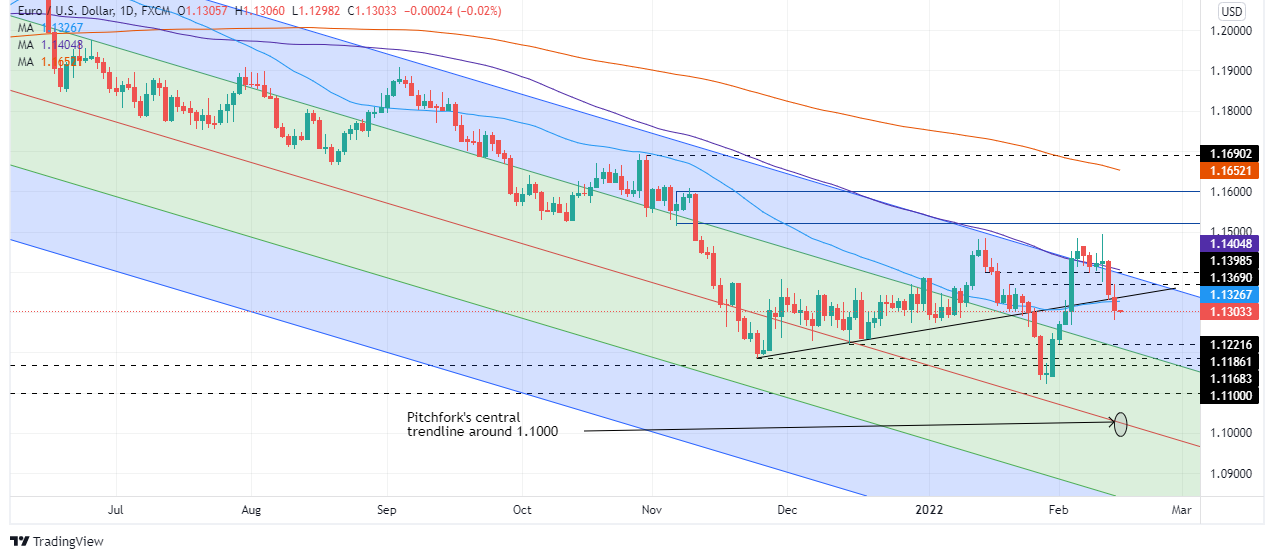
- USD/CAD is stuck in a sideways range awaiting geopolitical drivers.
- The price has reached a key upside target, now drifting lower as oil prices surge.
USD/CAD remains in familiar territory as fundamentals fail to gain traction as the world waits on Russia's next move or for diplomacy to prevail and avert a catastrophe in geopolitics.
In the prior, USD/CAD Price Analysis: The 1.2780's are in focus now that bulls are back in control, it was note that ''the price had found stability in the hourly lows but it has carved out a lower low as follows:

and that ''the spike lower would have cleared out some of the stale sell stops below the daily support.''
This had resulted in a renewed bullish impulse on the daily chart as follows:
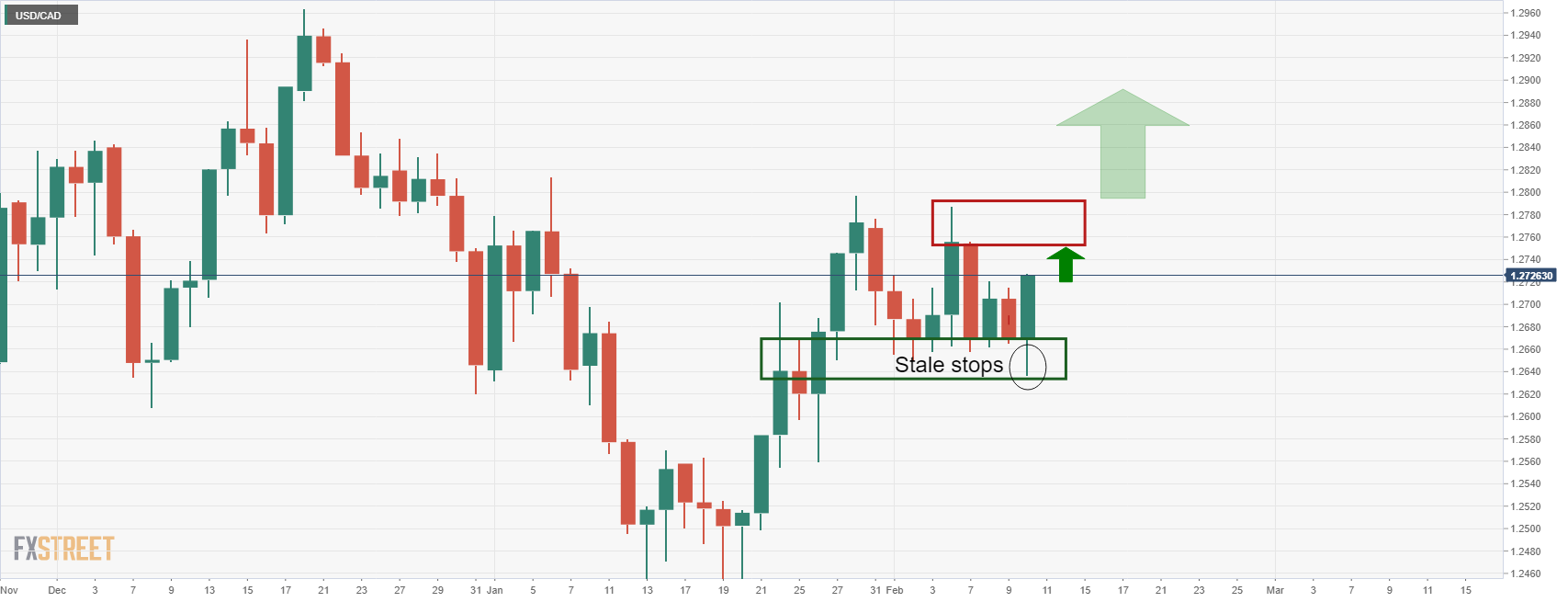
Eyes were on the 1.2780's and the Feb highs for the days ahead and the bulls have reached the target as follows:
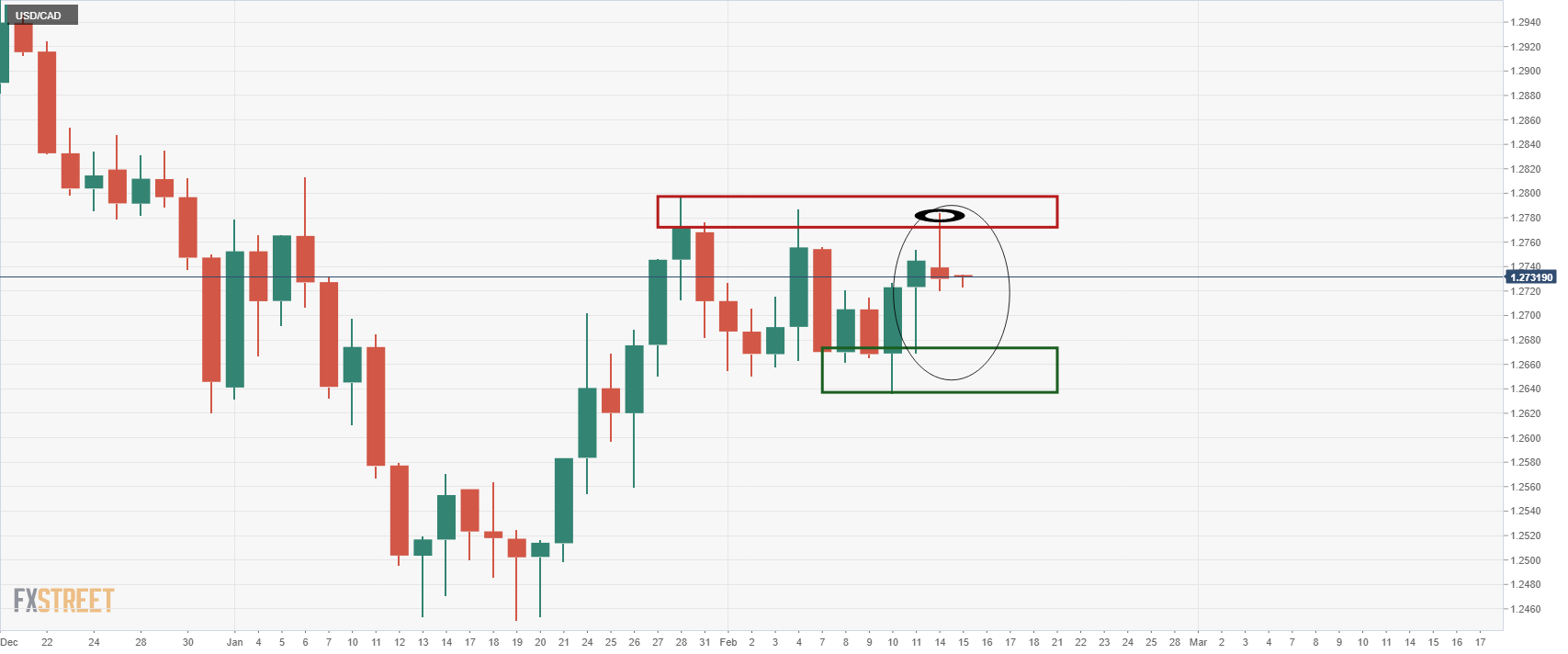
The outlook at this juncture remains clouded by the geopolitical backdrop and the familiar ranges will likely remain in play until there is a resolve or escalation way or another. WTI will also be a key driver as it heads towards $100bbls, supportive of CAD.
- AUD/USD continues to trade with a downside bias as geopolitical angst keeps the dollar in demand.
- The economic calendar is busy, with RBA and Fed minutes and policymaker rhetoric, plus key data releases.
As markets remain skittish on the prospect of a potentially imminent Russian military incursion into Ukraine, macro sentiment remains on the defensive and, as such, AUD/USD continues to trade with a negative bias. The pair is down around 0.2% on the day in the 0.7125 area, having recovered somewhat from a brief dip underneath the 0.7100 level early during European trade, but having failed to recover back to the 0.7150 level.
The fast pace of developments on the Russia/Ukraine front remains confusing for investors to follow and difficult to predict what is coming next. Earlier in the day, Russia indicated a preference for continuing diplomacy, but Satellite imagery cited by US press shows that Russian troops near the Ukrainian border are moving into attack positions. Meanwhile, the Ukraine President “jokingly” referred to Wednesday as a possible date when Russia may attack, a statement which markets took seriously at first, but now are unsure what to make of.
All said, the state of heightened geopolitical risk ought to keep AUD/USD capped for now. The Aussies exposure to commodity prices, however, may prevent AUD from being the worst hit of risk-sensitive G10 currencies in the case of an all-out Russia/Ukraine war scenario. Energy prices have been surging and precious metals are up, both positives for the Aussie. Geopolitics will remain the main driver for AUD/USD this week, though traders should also keep an eye on a busy economic calendar that includes RBA and Fed minutes and policymaker commentary, plus US PPI, Retail Sales, regional Fed manufacturing surveys and Australia jobs data.
- The EUR/GBP pares some of its monthly gains, courtesy of risk-off market mood and technical barriers.
- The 100-DMA capped EUR/GPB rally, followed by a consolidation of three days.
- A daily close below 0.8358 would keep the EUR/GBP sellers in control as they prepare for an attack of 0.8300.
The shared currency losses ground for the third consecutive day against the British pound amid a risk-off market mood spurred by Russia/Ukraine conflict. That said, at press time, the EUR/GBP is trading at 0.8354.
The EUR/GBP price action on the last three days witnessed a fall in line with the overall trend of the daily moving averages (DMAs), lying above the spot price. However, when the BoE and the ECB revealed their monetary policy decisions, the pair rallied almost 200-pips, towards 0.8477, which pierced the 100-day moving average (DMA), retreating three days afterward.
EUR/GBP Price Forecast: Technical outlook
The EUR/GBP remains tilted to the downside. Last Friday’s price action triggered a leg-down as bears reclaimed the 50-DMA at 0.8413, which exacerbated a downward move beyond the 0.8400 figure, reaching a daily low at 0.8358.
During the overnight session for North American traders, the EUR/GBP bulls attacked February’s 11 daily low and printed a daily high at the daily pivot point at 0.8385, followed by a drop below 0.8358, where the EUR/GBP comfortably trades as the New York session end looms.
The EUR/GBP first support level would be 0.8345. Breach of the latter would expose January 31 low at 0.8304. Once that level is cleared, it would expose the YTD low at 0.8283 and then a probe of 0.8200.
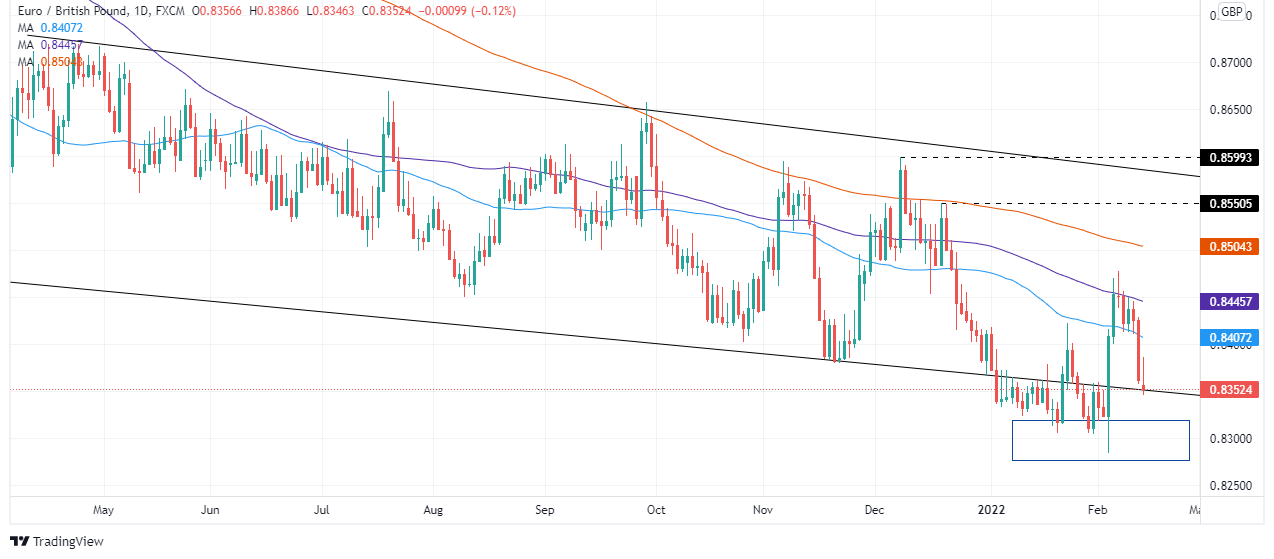
- USD/JPY round turns on conflicting Ukraine headlines driving risk sentiment.
- World leaders will engage in high stake meetings this week over the threat of the Russian invasion.
- Fed sentiment coming through as hawkish Fed speakers advocate 50bps hike in March.
USD/JPY is back on the bid following a series of information that is crossing the wires with regards to the prospects of a Russian invasion. In recent trade, the President of Ukraine Volodymyr Zelensky was reported to have said that the Ukraine “has been informed” that Wednesday, February 16 “will be the day of the attack”. This sent the yen higher and financial markets into risk-off mode again:
-
Markets flip risk-off as Ukraine's President Zelensky cites 16 Feb. as day of Russia attack
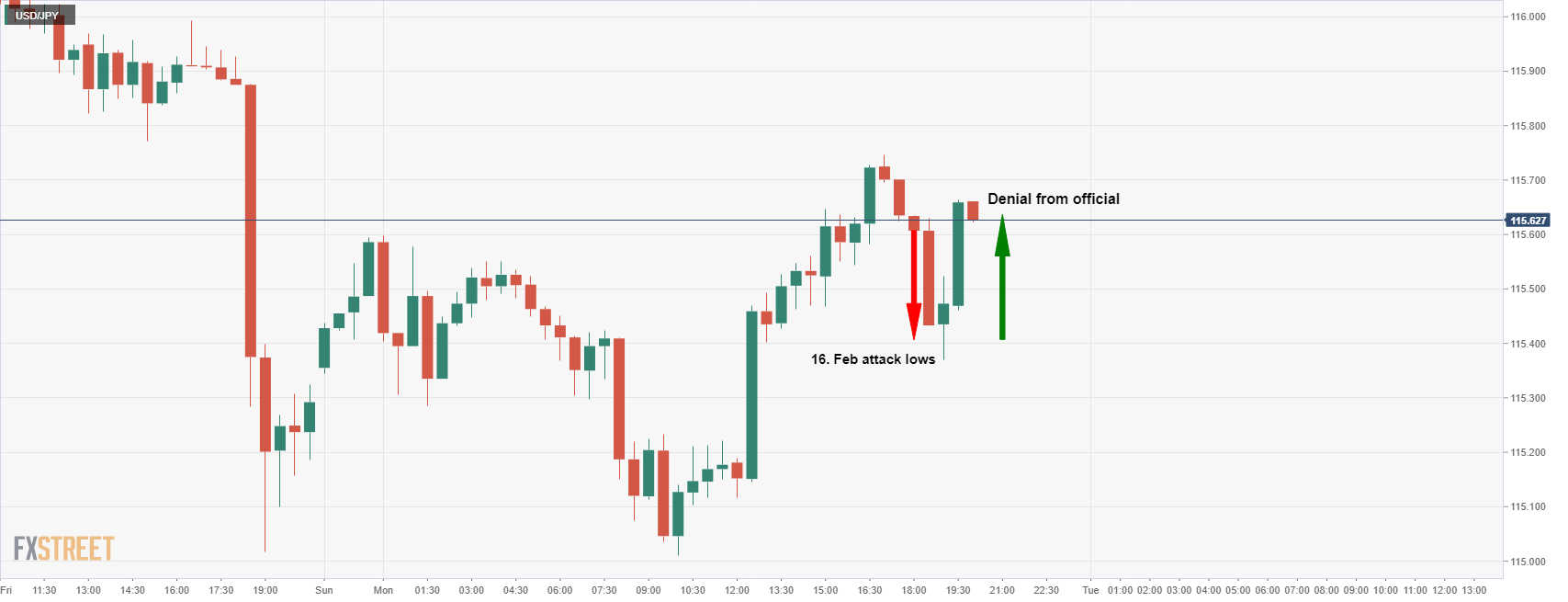
However, as the chart illustrates above, the price turned on a dime when a senior Ukrainian official denied that President Zelensky was being literal when he said in an address to the nation that he'd been told a Russian attack would begin on February 16th. Mykhailo Podoliak, a Presidential adviser, said that Zelensky was being ironic. Meanwhile, the risk is very real and markets are on high alert and on tenterhooks. The yen stands to benefit from risk aversion, especially through crosses such as AUD/JPY. Traders will be waiting for leaders to meet, with the French president visiting Moscow and the US president meeting with the Zelensky at the White House on Wednesday.
As for other fundamental drivers, the US dollar index reached a two-week high on Monday, as St. Louis Federal Reserve President James Bullard reiterated calls for a faster pace of U.S. Federal Reserve interest rate hikes. Bullard on Monday also said that four strong inflation reports in a row warranted action. Last week's stronger-than-expected US Consumer Price index report has driven speculation the Fed might raise rates by a full 50 basis points in March.
- NZ House Prices rose 1.4% MoM in January on a seasonally adjusted basis.
- NZD did not see any reaction to the latest housing figures.
New Zealand House Prices rose at a MoM pace of 1.4% and 20.3% YoY in January on a seasonally adjusted basis, according to the latest data from Real Estate Institute of New Zealand (REINZ) released on Monday. However, the institute said that "compounding factors" are influencing a decrease in house prices and sales activity in New Zealand.
Market Reaction
NZD has not reacted to the latest data, with NZD/USD continuing to trade sideways just above the 0.6600 level.
What you need to know on Tuesday, February 15:
Tensions between Russia and Ukraine dominated financial markets on Monday, leading to some solid safe-haven demand. The catalyst was a statement from US President Joe Biden, who told his Ukrainian counterpart Volodymyr Zelensky on Sunday that the US would respond "swiftly and decisively" if Russia takes further steps toward invasion.
Early on Monday, Russian Foreign Minister Sergey Lavrov told President Putin that the US had put forward concrete proposals on reducing military risks and that he could see a way to move forward with talks, although he added that EU and NATO responses have not been satisfactory. Fears partially eased, although risk-off continues.
As the day comes to an end, there are no signs of progress in diplomatic talks, but on the contrary, the Ukrainian President Zelensky reported that he has suspects Russia will likely attack the country on Wednesday, February 16, declaring it a national holiday, the Day of Unity.
The American dollar and gold were the most benefited in a risk-averse environment, with the first further boosted by comments from US St Louis Fed President James Bullard, who reiterated his call for 100bps in interest rate hikes by July 1, citing the last four inflation reports which show broadening inflationary pressures.
A scarce macroeconomic calendar exacerbated risk-related trading, with not much in the docket until next Wednesday, when the US will publish Retail Sales and the FOMC Meeting Minutes.
The EUR/USD pair trades sub-1.1300, while GBP/USD hovers around 1.3520. Commodity-linked currencies are little changed vs the greenback amid soaring gold and oil prices.
Global indexes plunged, with Wall Street accelerating its decline ahead of the close. Government bond yields retreated, with that on the 10-year Treasury note now at around 1.96%.
Gold surged to a fresh 2022 high of $1,872.85 a troy ounce, holding nearby at the time being. Crude oil prices also soared, with WTI trading at $95.25 a barrel.
Shiba Inu struggles to hold support, SHIBA could retest prior range near $0.000020
Like this article? Help us with some feedback by answering this survey:
- USD/CHF remains subdued near 0.9250 despite choppy conditions elsewhere in FX markets/other asset classes as Russia prepares its Ukraine assault.
- Both the buck and Swiss franc are currently underpinned by a safe-haven bid, making for unpredictable trading conditions going forward.
Despite recent cross-asset choppiness after the Ukrainian President confirmed Russia will attack on Wednesday and after reports citing satellite imagery said Russian troops were now moving into attack positions, USD/CHF continues to trade in a relatively contained manner. The pair is currently flat on the day near 0.9250, having swung within thin 0.9240-70ish ranges on the first trading session of the week. The pair’s lack of notable volatility owes to the fact that both the US dollar and Swiss franc are viewed as safe-haven currencies in the context of elevated geopolitical uncertainty.
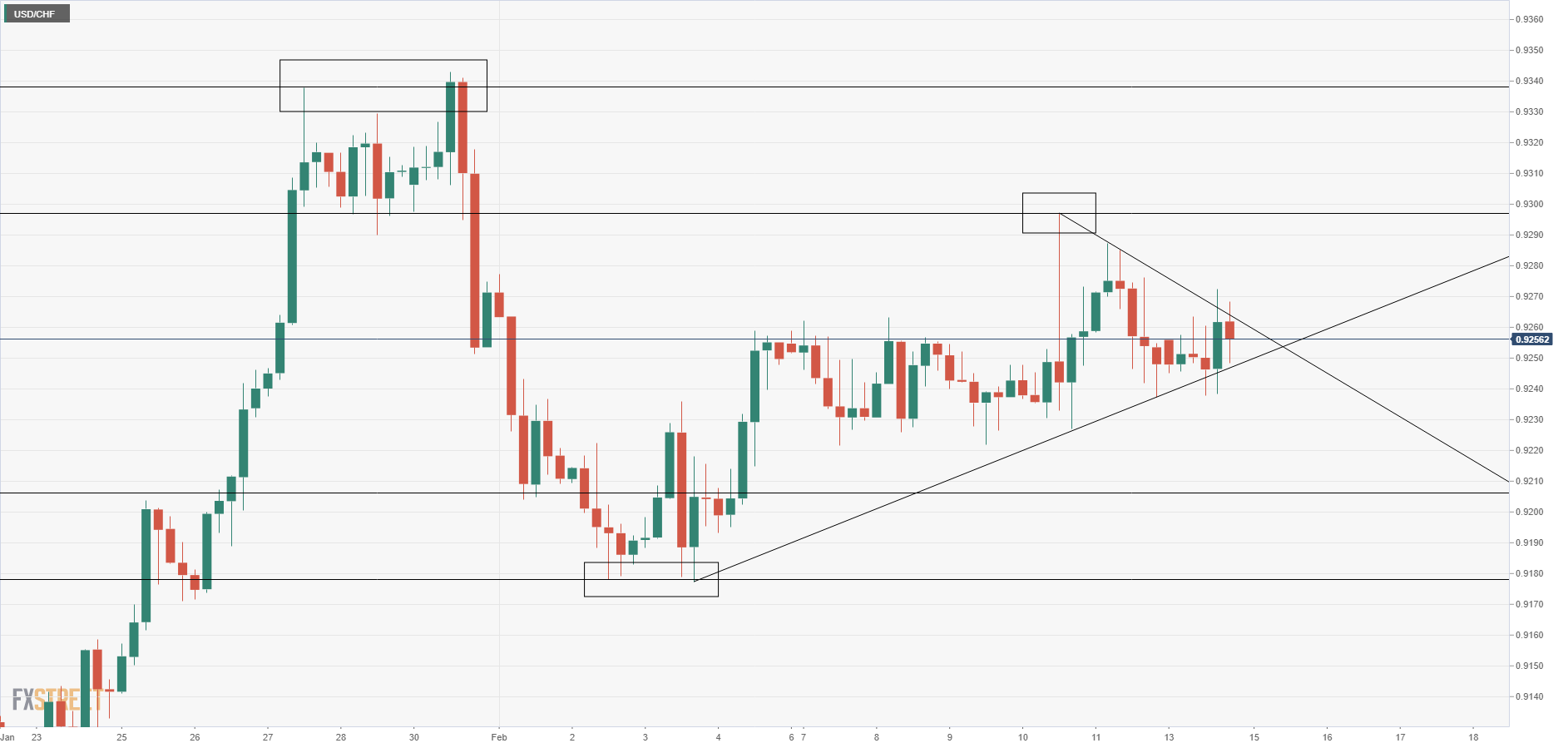
Technicians will note that the pair has in the last few days formed a pennant structure that suggests a breakout in either a bullish or bearish direction is likely. Recent upside in US bond yields amid further hawkish commentary from influential Fed policymaker James Bullard on Monday helped underpin the US dollar, safe-haven demand aside, against some of its G10 peers. Bullard’s remarks helped pump Fed tightening expectations. If economic events this week (Producer Price Inflation on Tuesday, Retail Sales and Fed minutes on Wednesday) further solidify expectations for a 50bps rate hike from the Fed in March, then that could favour an upside break.
In this instance, the immediate area of resistance to be watching is last week’s highs just under 0.9300 and then the annual highs near 0.9350 just above it. However, if war is on the brink of breaking out in Eastern Europe and associated sanctions on the Russian economy do risk causing another spike in global inflationary pressures, traders may continue to view CHF favourably. Inflation is structurally lower in Switzerland than elsewhere, as has been witnessed in the post-pandemic era. Amid a highly uncertain geopolitical backdrop, USD/CHF trading conditions will likely be unpredictable and it may be far to soon to call for a lasting breakout of the 0.9100 to upper-0.9300s range that has persisted for six months.
- Increasing tensions of a war between Ukraine/Russia keep oil prices rising, almost 2% in the day.
- Satellite images show Russian troops leaving assembly points – per CBS News.
- WTI Technical Outlook: Upward biased, as geopolitical tensions maintain oil bulls eyeing $100.
US crude oil benchmark, Western Texas Intermediate (WTI), barely advances, following Friday’s jump of 3.78%. At the time of writing, WTI is trading at $94.00, almost flat.
Geopolitical events dampened the market mood in the financial markets. Russia’s intentions of a possible invasion of Ukraine keep crude oil prices upward pressured, based on the fact that a war may trigger Russia’s sanctions to western countries, including cutting supplies of natural gas and oil. (Russia is the third-largest producer of natural gas and crude.)
Ukraine President Zelensky informed that February 16th would be the day of the attack, tensions elevate, and oil jumps
Around 18:50 GMT, crossed the wires that satellite images show Russian troops leaving assembly points and moving to attack positions, as reported by CBS News. Alongside that development, the Wall Street Journal reported that the US is closing its embassy in Kyiv and relocating its diplomatic operations to Western Ukraine. Furthermore, Ukraine President Zelensky said that Ukraine “has been informed” that Wednesday, February 16th “will be the day of the attack.”
WTI’s Reaction
At the headline, WTI’s jumped almost $2.00, and at 19:09, GMT is trading at $95.20 as tensions arise, despite efforts from finding a diplomatic way to end this conflict.
Meanwhile, OPEC Secretary-General Mohammad Barkindo told reports that “there’s no doubt that we are concerned with ensuring that the security of supply is also guaranteed.” However, emphasized that if demand continues to grow at the group projections, “the world will continue to be thirsty for oil for the foreseeable future,” Barkindo noted.
WTI Price Forecast: Technical outlook
WTI is upward biased and is trading above February’s 11 daily close at $93.88, though the upward move appears to stall at the mid-line between the top-central lines of Pitchfork’s uptrend channel, around $95.00, which once broken would expose $100.00.
Nevertheless, WTI’s would face some hurdles on its way north. The first resistance would be $95.00. A daily close above that level would expose August’s 2014 swing highs round 98.55, followed by a probe of $100.00, followed by the top-line of Pitchfork’s channel around $102.00
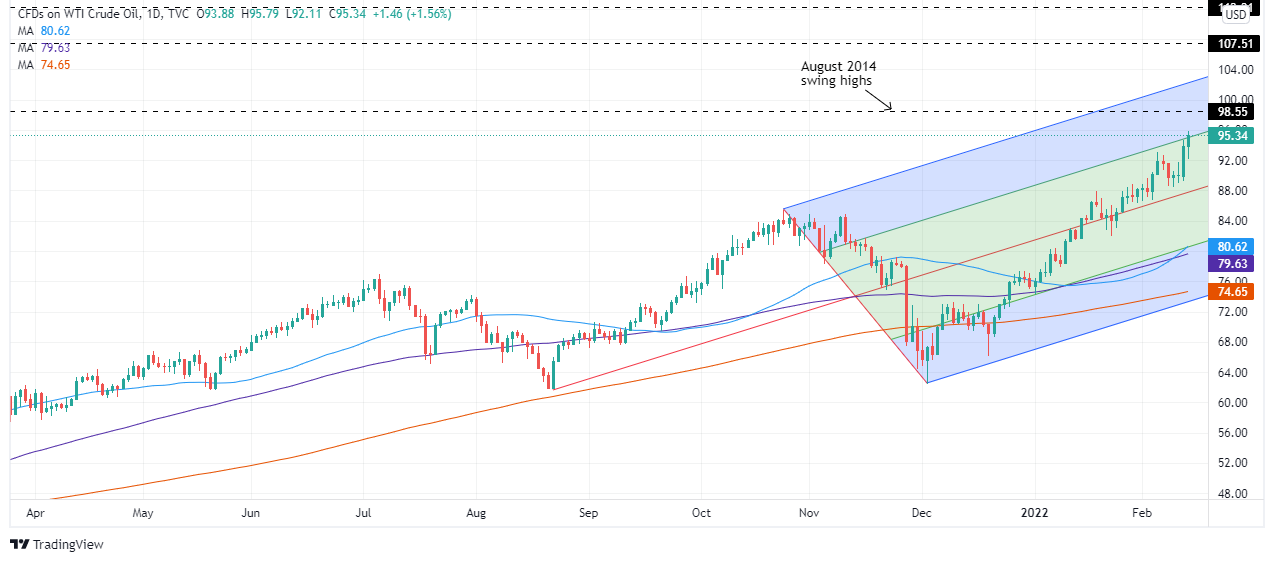
Ukraine's President Zelensky said that the Ukraine “has been informed” that Wednesday, February 16 “will be the day of the attack”, according to comments attributed to Zelensky accompanying a Facebook update to the nation.
He does not say who or what agency provided the information.
Nevertheless, the market is paying attention to each and every update. The 16th was a date US President Joe Biden told Western leaders about last week as a potential time when Russia will start a physical assault on Ukraine.
In an update, Russia has moved some long-range artillery and rocket launchers into firing position, threatening Ukraine, according to a US official. A bumper-to-bumper formation is seen in satellite photos — and are beginning to move into "attack positions," according to the official who said that the US believes Russia will attack Ukraine by the end of the week, although it's not yet certain what form it will take, the official said.
The US benchmarks are printing fresh lows with the S&P 500 now moving to 4,371 the low while AIUD/JPY drops from the corrective highs and challenges what may otherwise have been regarded as the formation of an inverse head and shoulders:
AUD/JPY technical analysis, H1 chart
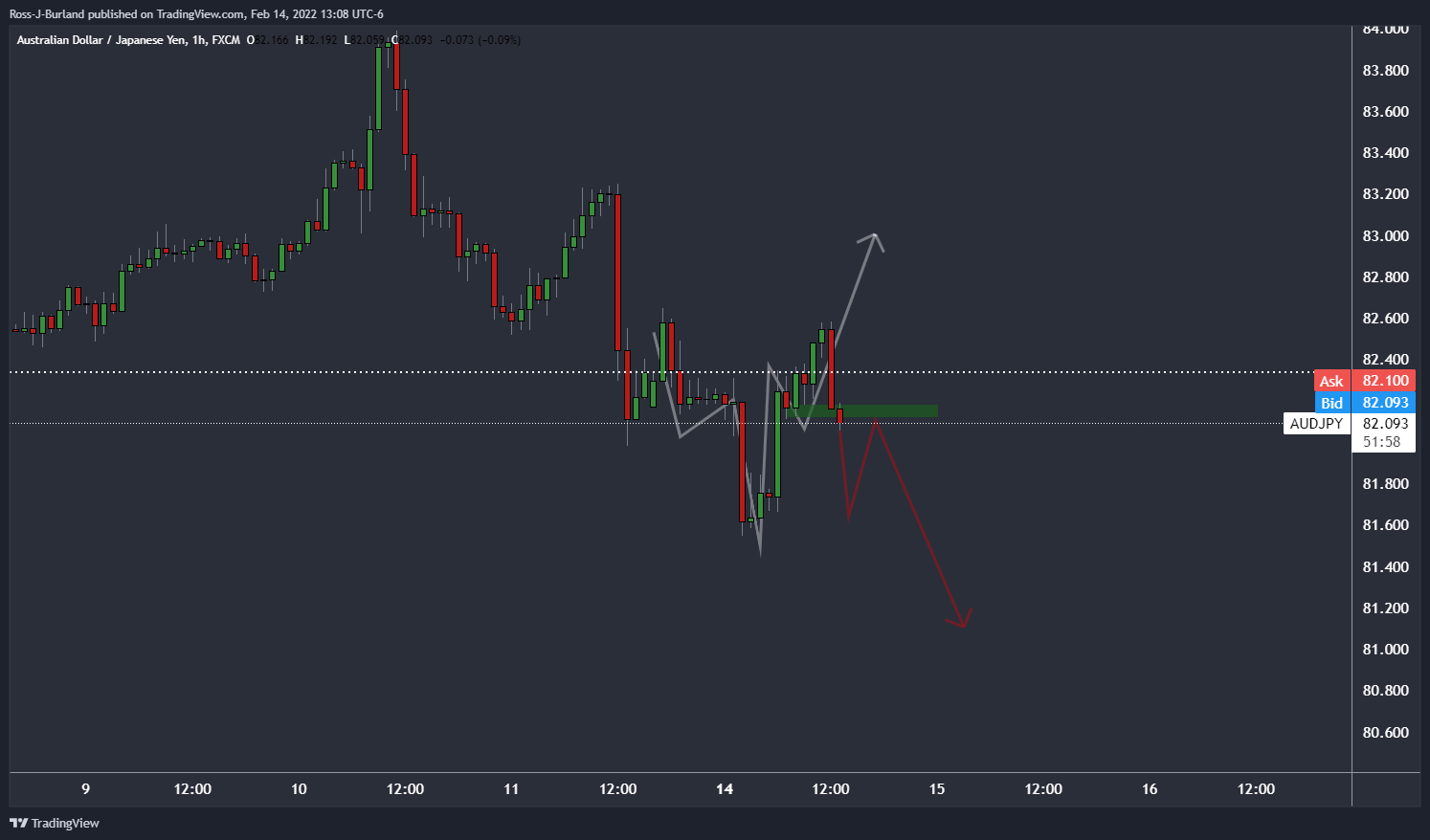
As for the forex market's risk barometer, AUD/JPY, the price is breaking the right-hand shoulder to the downside and finding so, invalidates the inverse head and shoulders, putting the focus on the downside once again. 81.11 could become a strong level of resistance on a retest with 81.66 the next level of potential support.
- NZD/USD bulls tests bear commitments at 4-hour resistance at 0.6627.
- Bears look for a break of daily support at 0.6589 to engage fully from there.
As per the prior analysis, NZD/USD struggles in the face of a stronger US dollar despite hot RBNZ inflation expectations, there are bearish developments to take note of.
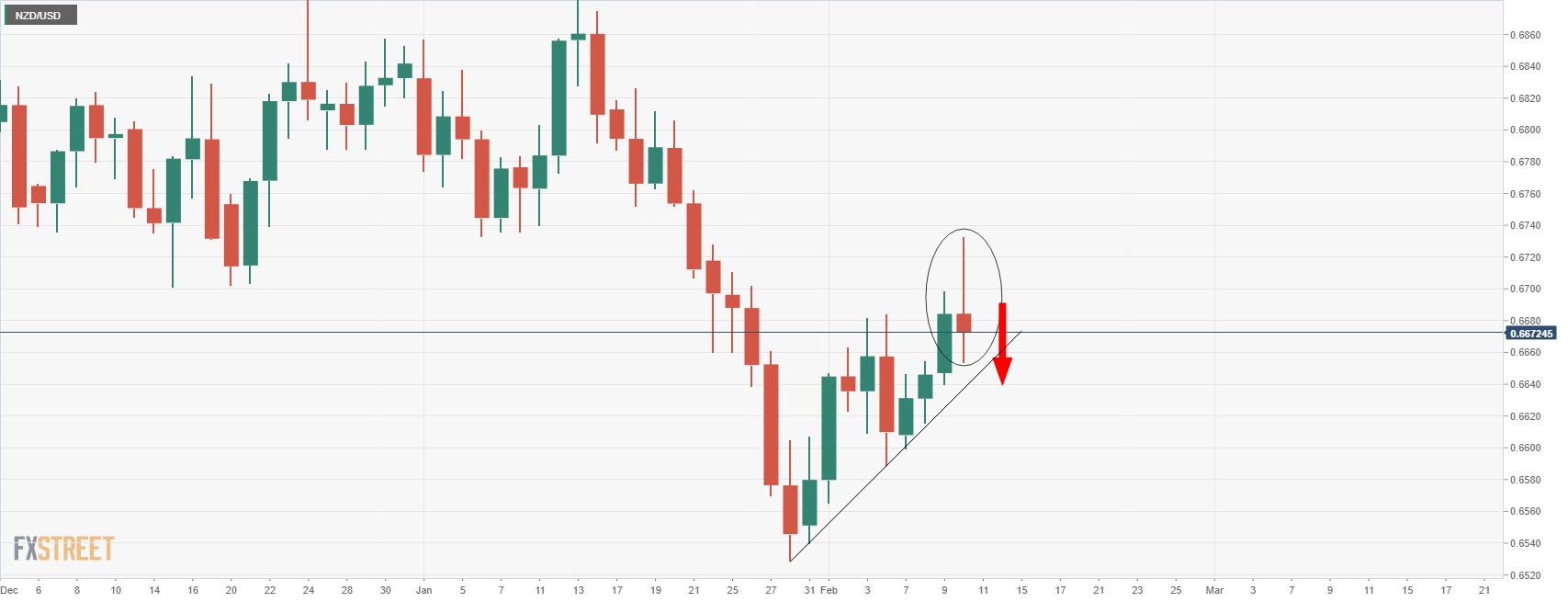
it was stated in the prior analysis, that ''the Doji candle, if followed by a bearish close on Friday, could set the case for a downside continuation for next week's business,'' as follows:

NZD/USD live market
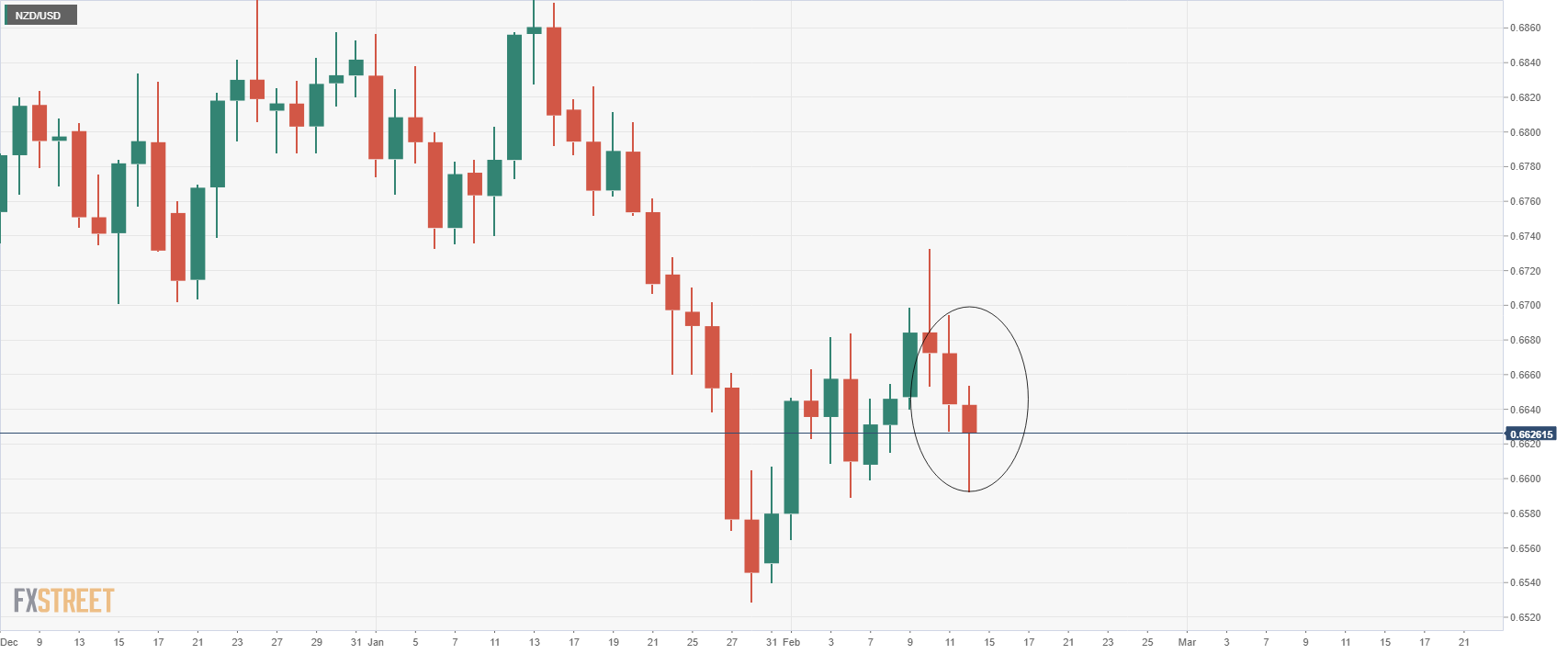
The price action since the prior analysis has started to play out. The Doji was followed by a relatively strong bearish candle and today's, while yet to close, is also bearish.
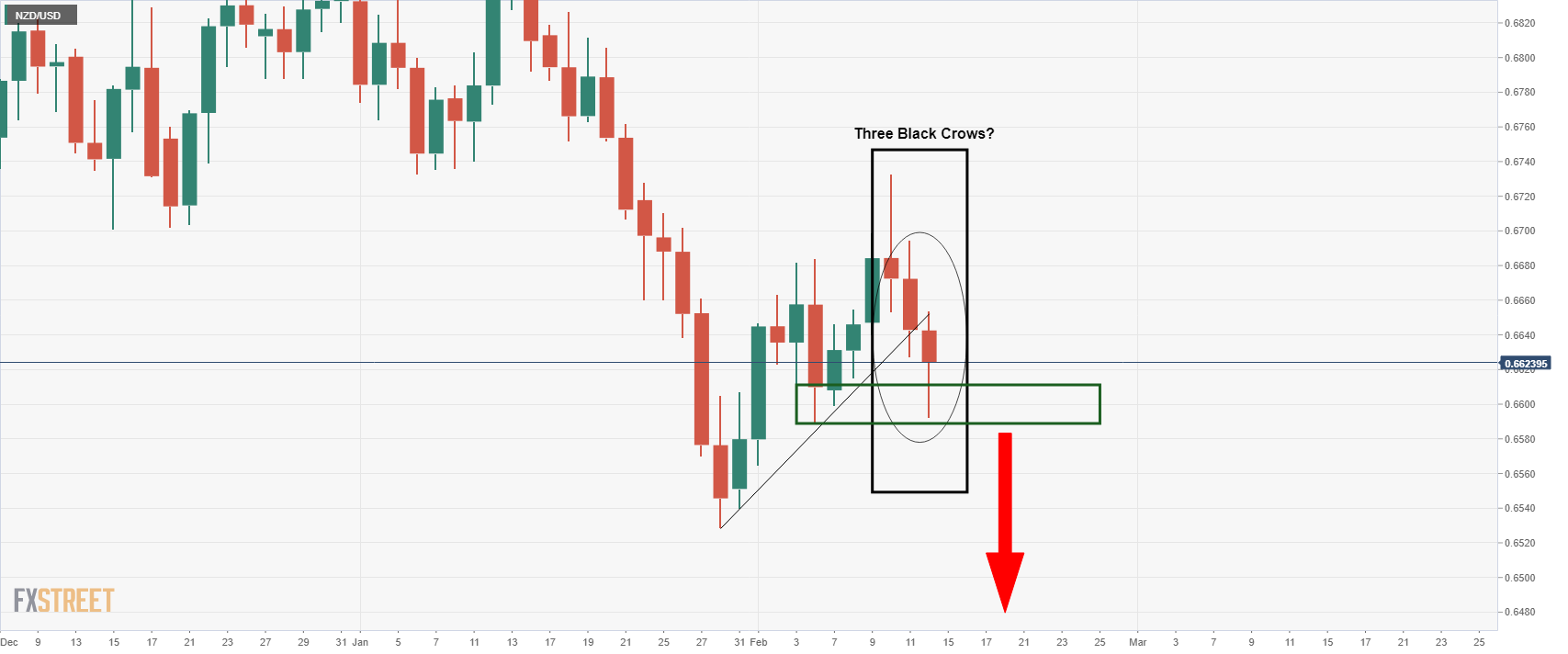
The outcome of today's close could leave a Three Black Crows bearish candlestick formation on the daily chart. However, the candles should ideally be relatively long-bodied bearish candlesticks that close at or near the low price for the period. Nevertheless, the focus is on the downside from a longer-term perspective as illustrated in the following weekly chart:
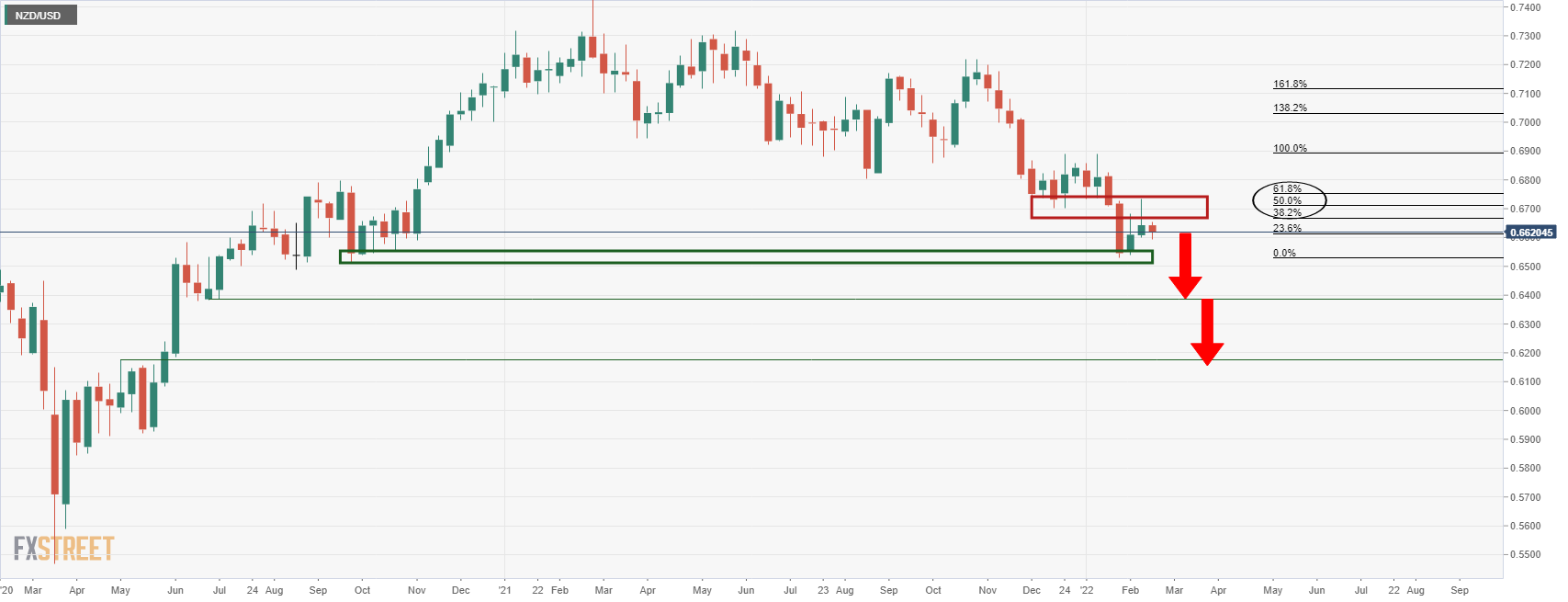
NZD/USD H4 structure and scenarios
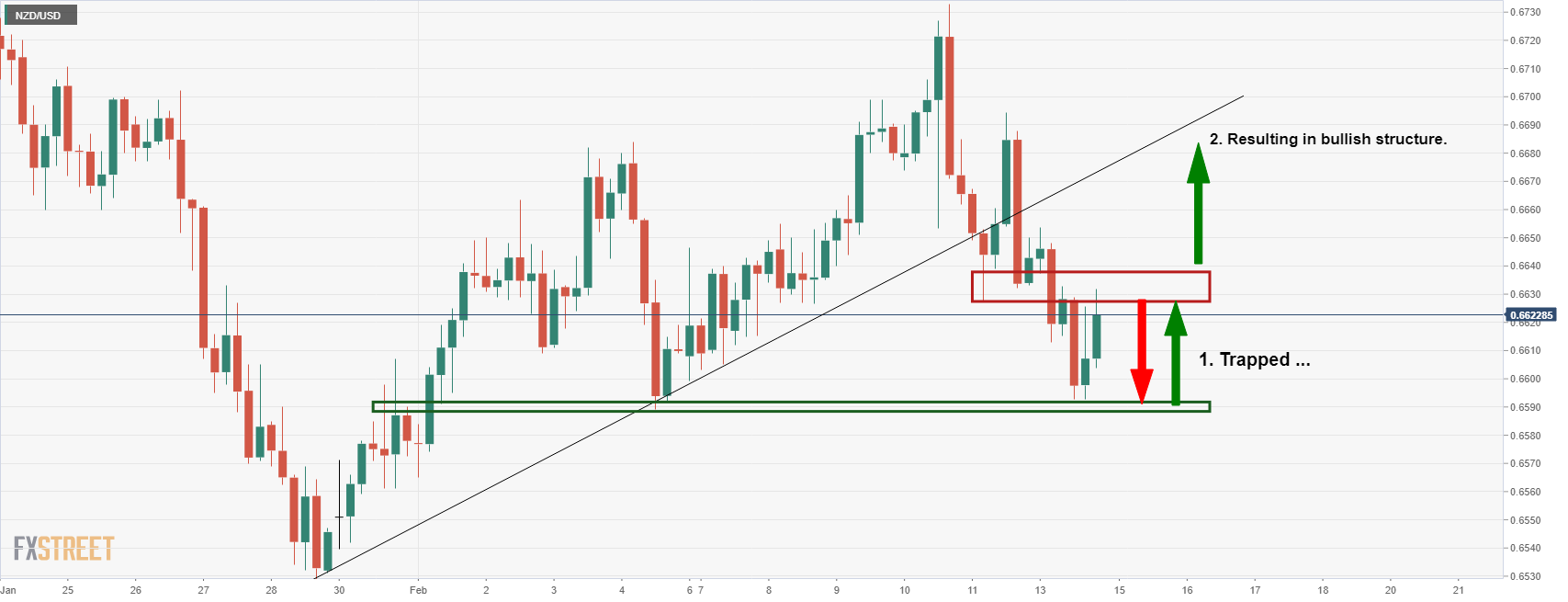
From a bullish perspective, the price could easily find support at the daily support structure. If the current tests at 4-hour resistance at 0.6627 fail but support remains firm, we will have a trapped scenario.
This could easily lead to a break of resistance and bullish market structure, leaving the focus back on the upside again for a deeper correction of the weekly chart's bearish impulse.
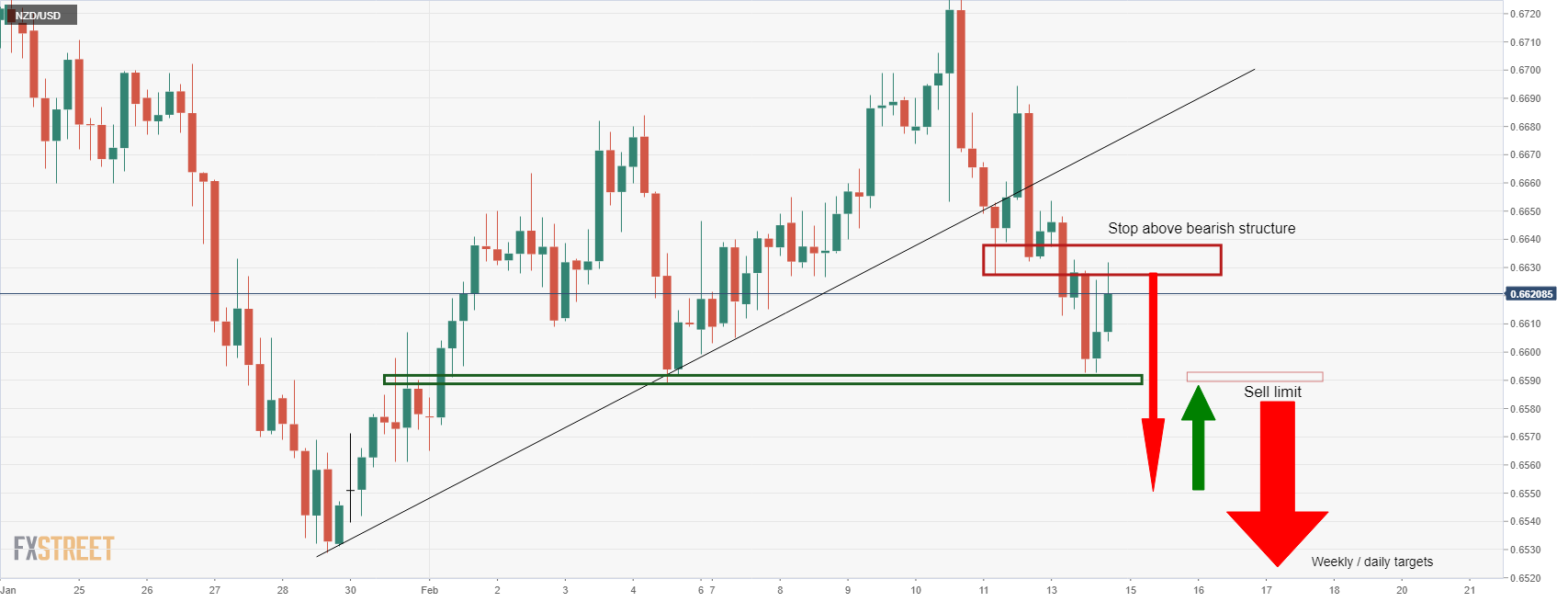
On the other hand, bears will be encouraged by a break of daily support at 0.6589 and might engage fully from there on the restest of the structure. This would be expected to act as a firm resistance and ultimately lead to a downside continuation of the weekly chart's bear trend.
- Gold remains stable during the North American session, up 0.41%.
- A dampened market mood spurred by geopolitical jitters witnessed flows towards the safe-haven status of gold.
- XAU/USD Technical Outlook: Upward biased, though a clear break above $1877 would put $1900 at reach.
The safest haven asset of all, gold, remains steady during the beginning of the week, despite a stronger US dollar across the board. However, it retreats from daily tops around $1,871 as geopolitical tensions appear to ease in the conflict between Russia and Ukraine. That said, XAU/USD is trading at $1,867, up some 0.43% at the time of writing.
Financial markets sentiment remains downbeat, as shown by global equities falling, except for the Nasdaq Composite in the US. US Treasury yields keep rising, led by the 10-year T-note yield, at 2.021%, up to ten basis points in the day, though the non-yielding metal remains stubbornly in the green, amid escalations in the eastern Europe conflict.
In the meantime, Russia / Ukraine geopolitical jitters are the leading indicator in the markets at press time. Earlier, as reported by CNN, the US intelligence is assessing Russian military plans, including the surrounding of Kyiv, within 24-48 hrs from the start of military action. Nevertheless, early messages from the Russian Foreign Minister Sergey Lavrov on Monday said Russia could move forward with talks, emphasizing that the west has failed to address Russia’s interests.
Those remarks appeared to ease the market mood, though they failed to reignite a rally in US equities.
Regarding the economic docket, the Fed speaking in the likes of St. Louis President James Bullard, crossed the wires. He commented that he keeps his 1% threshold by July 1st at 1% concerning interest rates. While speaking of the balance sheet, he is worried that the Fed is not moving fast enough and would like to reduce the balance sheet in Q2.
XAU/USD Price Forecast: Technical outlook
Gold (XAU/USD) is trading above a nine-month-old, despite rising US T-bond yields and broad US dollar strength across the board. Furthermore, it is trading above the mid-line between the center-top Pitchfork’s uptrend channel, a confluence, which once broken, would expose the top of it, around the $1,872-75 area.
That said, the XAU/USD first resistance would be November’s 16 swing high at $1,877. Breach of the latter would expose the $1,900 psychological level, followed by June 1st swing high at $1,916.
Contrarily, in the event of XAU/USD moving downward, it would expose crucial support levels, like the mid-line between the top-central Pitchfork’s channel around the $1,850-55 regions, followed by the central trendline at the $1,832-35 area, followed by the confluence of the 50 and the 200-DMA at the $1,809-07 range.
- A break of the 156.00/10 structure to the downside would open the risk of an hourly continuation.
- Bulls note an inverse head & shoulders bullish chart pattern and a break of the neckline near 156.50.
As per the prior day's analysis, GBP/JPY Price Analysis: Bears move in on critical hourly support, the price broke to the downside on news relating to Russia but has since bounced back into the resistance area.
GBP/JPY prior analysis, 15-min chart
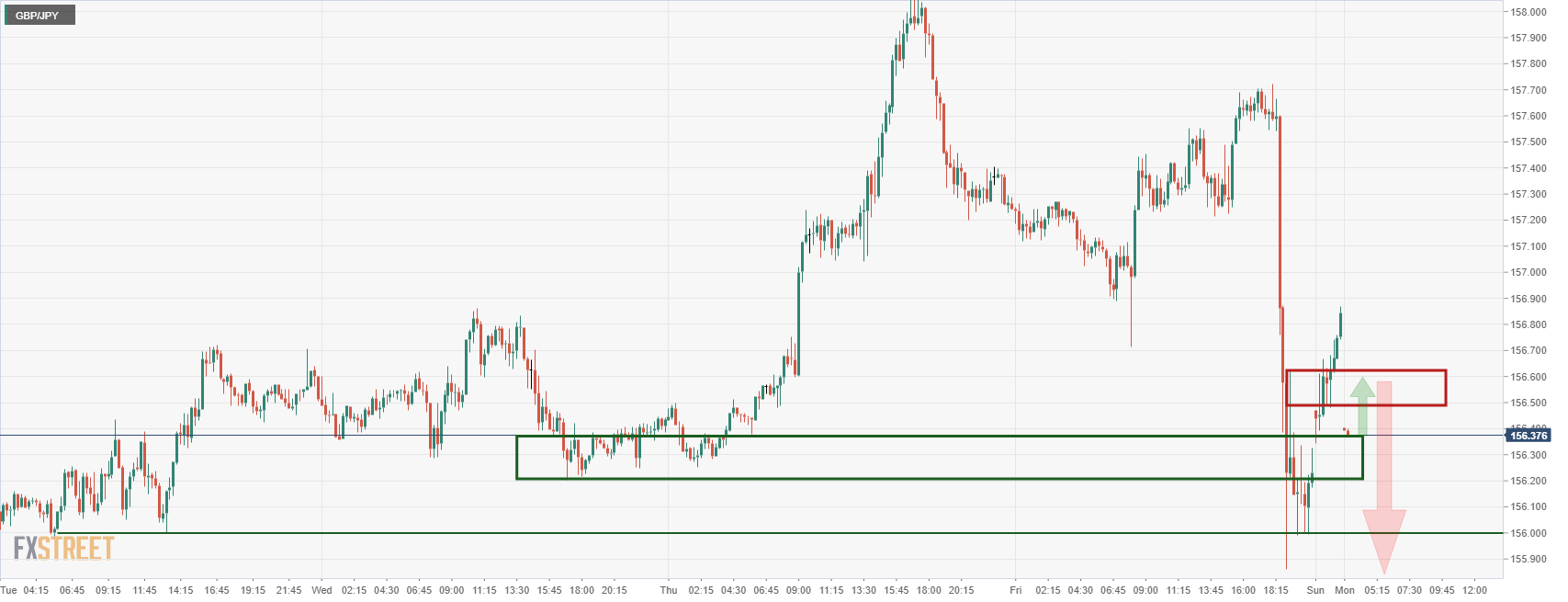
GBP/JPY live market, 15-min chart
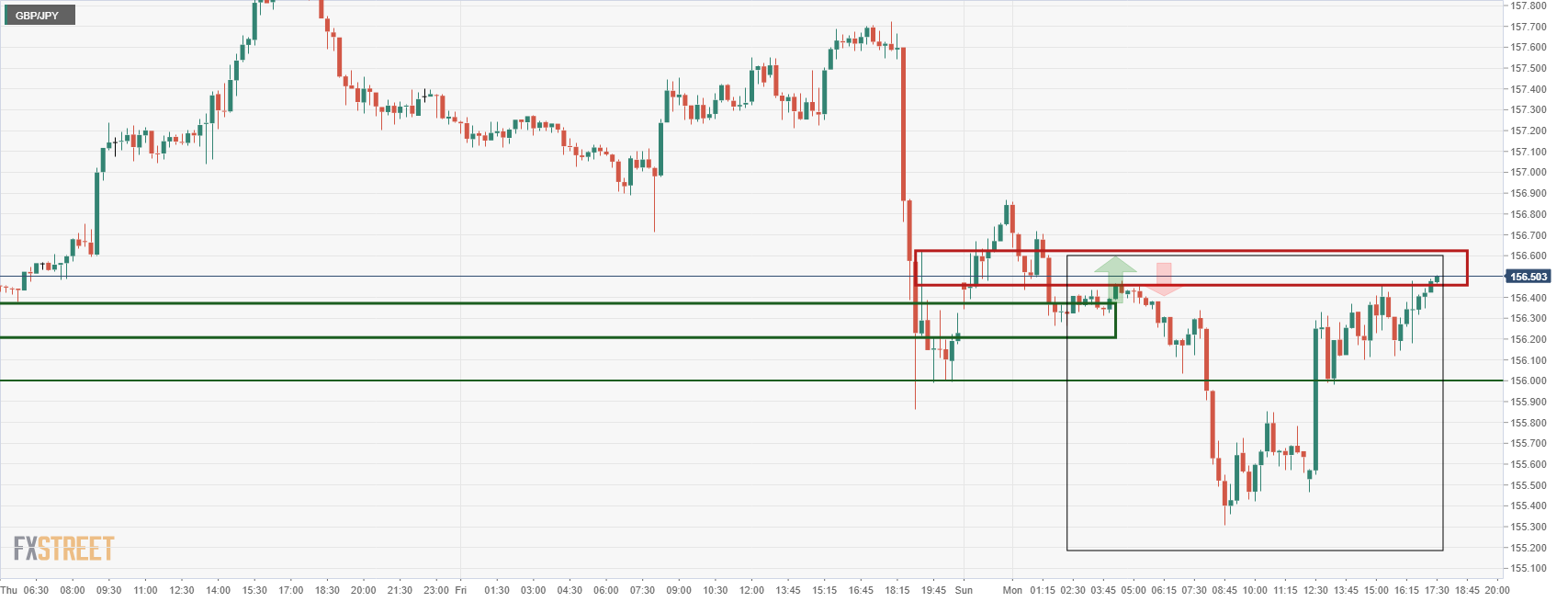
The Russian headlines have been coming through thick and fast creating volatility in forex, especially in the yen. While the price has firmed, it is still within the bear's layer.
GBP/JPY prior analysis, H1 chart
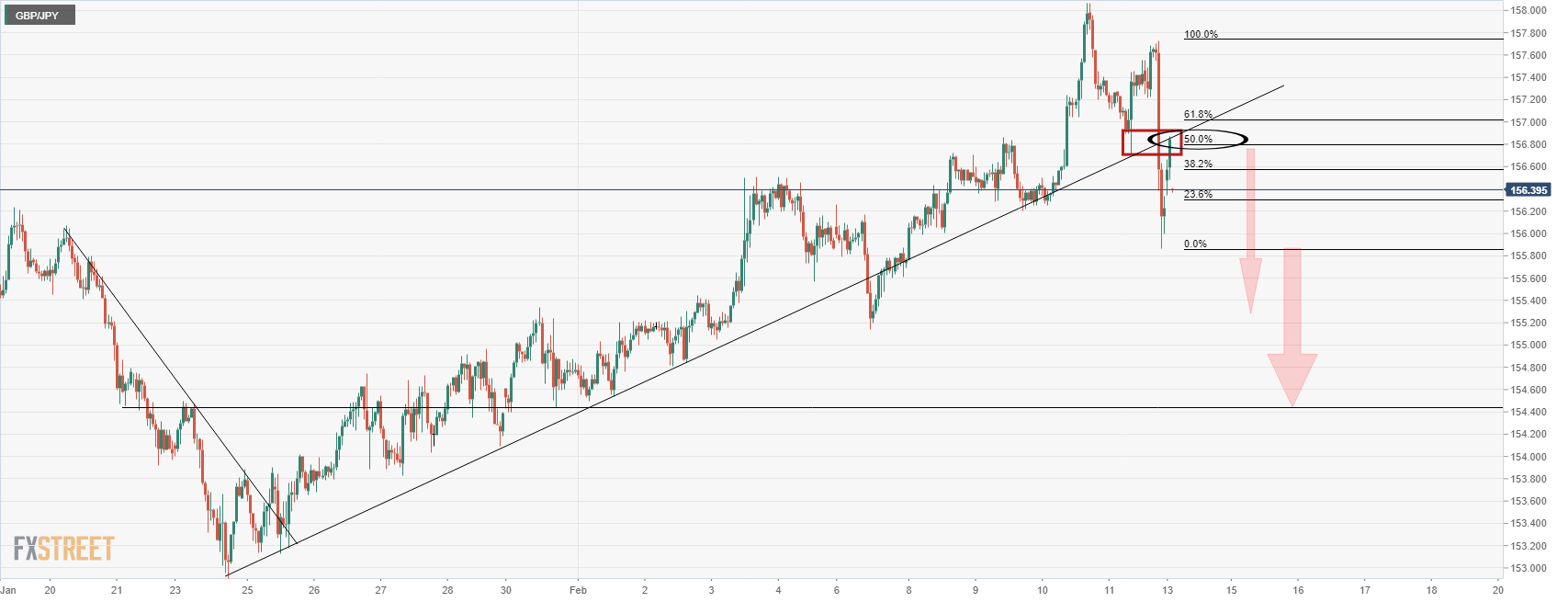
From an hourly perspective, the bears are focused on the downside target towards the midpoint of the 154's.

GBP/JPY inverse H&S H1 chart
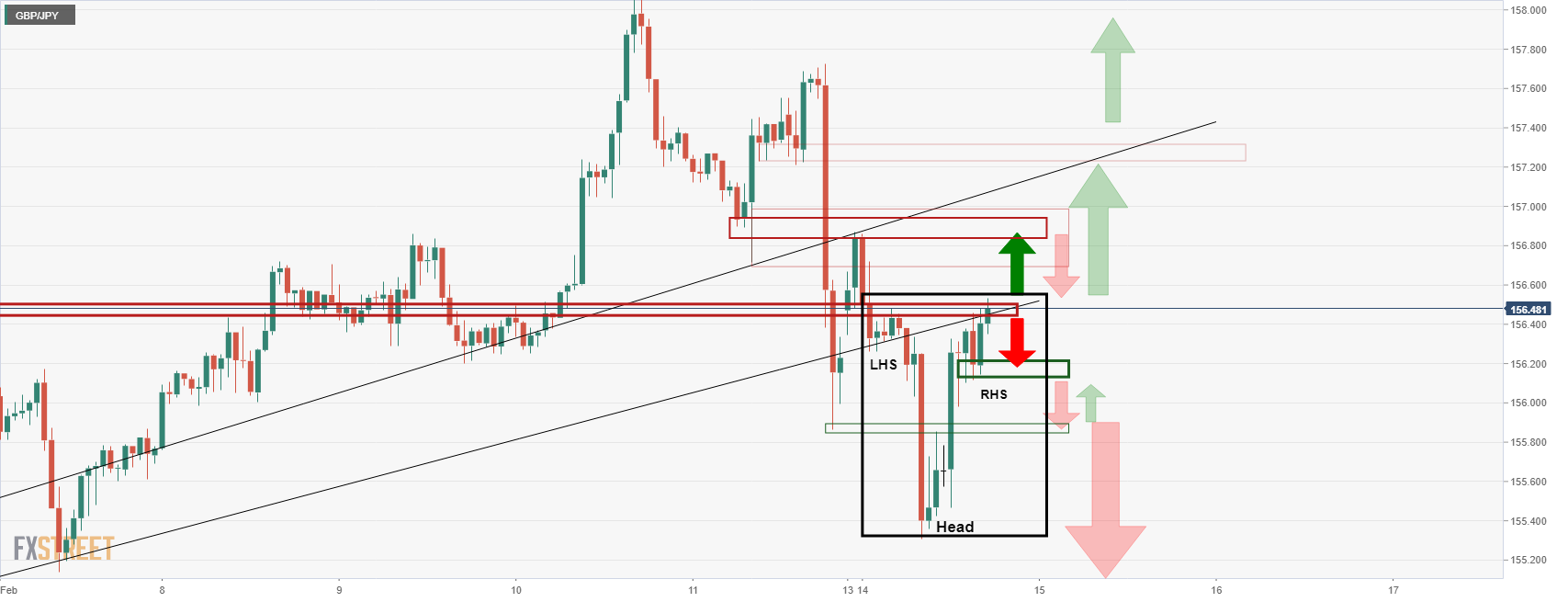
The price can easily be rejected at this juncture and a break of the 156.00/10 structure to the downside would open risk of a continuation towards the hourly 154.50's target.
On the other hand, given the inverse head & shoulders bullish chart pattern, a break of the neckline near 156.50 could open prospects of demand through the 156.80's and with a focus on the rising channel again and prospects beyond the 157.20's.
- USD/JPY rebounded from 115.00 as USD became the safe-haven of choice amid ongoing geopolitical concerns on Monday.
- Hawkish commentary from Fed’s Bullard spurred upside in US yields, reducing the yen’s appeal and boosting the dollar.
USD/JPY rebounded from the 1.1500 level during US trade on Monday, having failed on multiple occasions since last Friday to break below the key level. The pair is now trading close to highs of the day in the 115.60s, up about 0.2% and is eyeing a retest of the 116.00 level and last week’s highs in the 116.30s. Though geopolitical tensions remain elevated in the throes of what feels like the final diplomatic push to avoid a Russia/Ukraine military conflict, the yen’s safe-haven bid has been easing as the US dollar becomes the FX haven of choice.
That is likely due to a surge in US government bond yields on Monday (the 2-year +9bps and back above 1.60% and the 10-year +6bps and back above 2.0%) as markets amp up Fed tightening bets once more. Spurring the move were comments from FOMC member James Bullard who doubled down on his calls for the Fed to hike interest rates by 100bps by July 1 and pledged to try to bring round other Fed colleagues to his view.
USD/JPY remains highly sensitive to US /Japan bond yield differentials, particularly at the long end. With the BoJ having pledged to buy JGBs in unlimited size to prevent the Japan 10-year yields from rallying above 0.25% (and having succeeded thus far), the further 10-year US yields rise, the more upward pressure will be exerted on USD/JPY. Data and Fed speak this week will be viewed in the context of how it influences the chances of a 50bps rate hike from the Fed in March and the pace of subsequent tightening. It’s a busy week on the economic calendar, with January Producer Price Inflation and Retail Sales data, as well as February regional Fed manufacturing surveys out.
- The USD/CAD rises some 0.01% in the North American session.
- Russia-Ukraine conflict tensions “appear” to ease, but mixed news keeps traders nervous.
- USD/CAD remains range-bound amid the lack of a catalyst to guide the pair.
The USD/CAD begins the week on the right foot extends its gains for the third straight day amid a risk-off market mood, spurred by the Russia-Ukraine conflict jitters. At the time of writing is trading at 1.2735, above last Friday’s highs.
Risk-aversion looms the financial markets, as developments since last Friday’s when news that a Russian invasion of Ukraine was “imminent” spurred erratic movements in all the assets classes. In the FX market, safe-haven peers rose and found follow through on Monday, as the USD is the strongest, followed by the JPY.
In the case of the USD/CAD, the Loonie got a boost from rising oil prices. Concerns of not enough supply caused the jump since Friday, as Russia is the third-largest producer of natural gas and oil. So, any escalations and the invasion of Russia to Ukraine could weigh on oil prices and put a lid on the USD/CAD price. At press time, WTI is trading at $94.56 power barrel, up 0.49%
The latest development of the Ukraine-Russia conflict keeps showing mixed messages from western and Ukrainian sources
Earlier in the day, as reported by CNN, US intelligence indicates that Russia continues to build up forces around Ukraine “in preparation for possible military action this week,” a senior US official briefed on the intelligence, per CNN.
However, as reported by Interfax, a Ukrainian official said that the country sees no full-scale of Russian attack in the coming days.
Concerning central bank policy, the expectations of a Federal Reserve “aggressive” tightening looms, as US inflation for January rose to 7.5, while the Core CPI that exclude volatile items jumped to 6%, spurred reactions of the more “hawkish” member of the Fed. On Friday, St. Louis President James Bullard backpedaled from what he said at the beginning of the month, emphasizing that he would favor a 50 bps increase to the Federal Funds Rate (FFR) and expect it to be at 1% by July. Those remarks increased the demand for greenback.
On Monday, the Canadian and US economic docket are absent. On Tuesday, the Canadian docket would feature Housing Starts for January. On the US front, prices paid for producers, with the Producer Price Index (PPI), followed by the Redbook.
USD/CAD Price Forecast: Technical outlook
The USD/CAD is neutral-upward biased, as shown by the daily moving averages (DMAs) above the exchange rate. As previously mentioned, the USD/CAD is range-bound, unable to break the 1.2650-1.2780 range, with only false breakouts upwards/downwards, amid the lack of a catalyst or the convergence of central bank monetary policy conditions.
That said, the USD/CAD resistance levels are the February 11 high at 1.2753, followed by January 31 at 1.2776, and then the January 28 swing high at 1.2796. On the flip side, the first support would be February 10 daily high previous resistance-turned-support at 1.2727, followed by the 50-DMA at 1.2701 and then February 10 daily low at 1.2635.
The AUD/USD pair tested levels under 0.7100 on Monday. Analysts at Danske Bank see the pair at 0.71 on a three-month perspective, at 0.70 in six months and at 0.69 in a year.
Key Quotes:
“The rally in commodity prices has supported AUD since late January as broad USD strengthening took a step back. Continuing easing from China is especially supportive for Australia’s key export commodity, iron ore.”
“The outlook for commodities remains uncertain, as the global recovery and Chinese easing have supported demand, but more aggressive Fed tightening and broad USD strength should limit the rise in prices.”
“The Reserve Bank of Australia ended its QE purchases in February. RBA highlighted the risks of more persistent inflationary pressures, but also noted that near-term rate hikes remain unlikely. Labor market conditions have tightened, but data released so far does not yet point towards a pickup in wage inflation. First rate hike seems likely in H2 this year, but with the very hawkish market pricing, relative rates remain a drag on AUD.”
On Wednesday, the January retail sales report is due in the US. According to analysts at Wells Fargo, sales likely rebounded rising 2.1%, a number above the 1.6% increase of market consensus.
Key Quotes:
“Retail sales declined sharply to end 2021. During December, total sales fell 1.9%, a drop that was more severe than consensus expectations. The decline was broad-based across most store types. Excluding spending on autos and gas, sales fell 2.5%. While it is tempting to blame December's drop on intensifying inflation and the Omicron surge, the weakness during the month was more a reflection of early holiday shopping and pulled-forward demand. That is not to say inflation is not a concern moving forward. Inflationary headwinds to consumer activity are likely to pick up throughout 2022, as evidenced by the recent deterioration in consumer sentiment.”
“Another factor that may affect spending this year is that, as the economy emerges from the latest Omicron wave, it doesn’t have the same fiscal support it had previously. In terms of COVID, consumers continue to become desensitized to rising case counts with each passing wave of the virus. In addition, households remain in solid financial shape today, which should support overall consumer spending in the months ahead.”
“We look for retail sales to bounce back and rise 2.1% in January.”
The USD/CAD pair will likely move to the upside over the next months according to analysts at Danske Bank. They forecast the pair at 1.36 in a twelve-month horizon.
Key Quotes:
“CAD has over the last month risen on the global setback to risk and Bank of Canada (BoC) disappointing market expectations. At the January meeting markets priced a higher than 50% likelihood of a rate hike yet BoC kept its guidance that the first hike will come in the “middle quarters” of 2022. While we cannot rule out a hike at the interim March meeting we still think the big meeting in April is the most likely time for the first hike.”
“We still regard relative rates to be a positive for USD/CAD and we pencil in more topside to the cross from our view on the external environment.”
“We still like to treat USD/CAD as a low beta version of USD/NOK, We now forecast USD/CAD at 1.29 in 1M (from 1.25), 1.31 in 3M (from 1.29), 1.33 in 6M (1.32) and 1.36 in 12M (1.33).”
ECB President Christine Lagarde on Monday said that the bank will take action at the right time to achieve its 2.0% inflation goal over the medium term. In the near term, she added, inflation is likely to remain high and bottlenecks will still persist for some time. There are some signs these bottlenecks might be starting to ease, she said, saying that in the medium-term, the ECB views the risks to the economic outlook as broadly balanced. However, in the near term, Lagarde continued, risks to the outlook for inflation are tilted to the upside, although while the near-term outlook is uncertain, inflation is expected to decline over the course of the year. Finally, Lagarde noted that the solid anchoring of long-term inflation expectations in the euro area near the 2.0% level is reassuring.
Market Reaction
Lagarde's latest remarks do not add anything new to what she said last week or the week before in her post-ECB press conference, thus, the euro has not reacted.
- US dollar holds onto gains amid risk aversion and higher yields.
- Euro fails to recover ground, continues under pressure.
- EUR/USD head for lowest close in two weeks.
The EUR/USD printed a fresh weekly low under 1.1300 during the American session as the US dollar remains strong supported by risk aversion and higher US yields. The pair botomed at 1.1288, before rebounding modestly.
EUR/USD back under the 20-day SMA
The correction from last week top near 1.1500 has turned into a potential reversal. Now EUR/USD is hovering around 1.1300, back under the 20-day simple moving average (1.1330) about to post the second-lowest daily close of the current months. The pair is back into the 1.1250/1.1360 range.
A recovery above 1.1370 should put the euro back on track for 1.1400 and more. The next resistance stands at 1.1450; above attention would turn to the 1.1480/90 area that capped the upside last week and also in January.
Higher yields despite risk aversion
Equity prices in Wall Street failed to hold onto positive territory. The Dow Jones is falling 0.65% and the S&P 500 by 0.21%, the Nasdaq is the exception as it gains 0.85%. Caution still prevails across financial markets supporting the demand for the dollar.
US yields also gave a boost to the greenback. The US 10-year rebounded from 1.90% (1-week low) and climbed back above 2.01%, while the 30-year rose from 2.21% to 2.32% in a few hours.
Market participants’ attention continues to be on Russian/Ukraine tensions and also on comments from Federal Reserve and European Central Bank officials. After a quiet day on Monday regarding economic data, on Tuesday data to be released includes GDP, employment and the ZEW survey in the Eurozone, while in the US, the key number will be the Producer Price Index.
Technical levels
- Silver is on the front foot and trading in the $23.80 area, despite a stronger buck and higher US yields.
- XAG/USD has been underpinned by a safe-haven bid as traders fret about the imminent prospect of a Russia/Ukraine war.
Despite the stronger US dollar and a sharp rise in US government bond yields across the curve in wake of the latest remarks from hawkish Fed policymaker James Bullard, spot silver (XAG/USD) prices have been on the front foot. Spot prices run out of steam and were unable to test the $24.00 per troy ounce level, but at current levels around $23.80, continue to trade about 0.9% or more than 20 cents higher on the day. For reference, Bullard, who is St Louis Fed President and a voting FOMC member in 2022, doubled down on his call for 100bps in Fed tightening by July 1. That gave Fed tightening bets a pump (money markets now price a more than 60% chance of a 50bps hike in March versus closer to 50% prior to his remarks), exerting upwards pressure on yields and the buck.
But precious metals have escaped the negative impact of higher yields, which increase the opportunity cost of holding non-yielding assets, and a stronger buck, which makes them more expensive to non-USD holding buyers, due to a continued safe-haven bid. Indeed, while Russian Foreign Minister Sergey Lavrov on Monday advised Russian President Vladimir Putin to continue with diplomacy for now, fears of imminent Russian military action against Ukraine remain elevated. US press, citing US intelligence, have been furiously reporting in recent days that an invasion could come as soon as this week.
Of course, when military tensions between Russia, who want to ensure Ukraine never joins NATO, and the West, who want to ensure Russia doesn’t invade Ukraine, rise, familiar fears about escalation towards a nuclear conflict arise. While a Russian invasion into Ukraine, a non-NATO member, wouldn’t directly trigger Russia/NATO conflict, there is a risk that conflict could spill across Ukraine’s borders to neighboring NATO countries (like Poland). Otherwise, and perhaps a more important reason why traders might be piling into precious metals, is the risks to the global economy that a Russia/Ukraine war presents.
If the West was to hit Russia with massive economic sanctions, Russia could hit back by restricting natural resource exports (oil, gas, industrial metals, ammonia for fertiliser) that could severely damage the global economy and create inflation. In that sense, silver/other precious metals might make sense as a sort of global “stagflation” hedge. An outbreak of war could easily see XAG/USD hit annual highs to the north of $24.50. Fed speak and US data (PPI, Retail Sales) will play a secondary role to this theme this week.
- WTI has stabilised just under multi-year highs in the $93.00s as traders monitor Russia/Ukraine/NATO tensions amid elevated fears of war.
- Tight global market conditions amid continued OPEC+ undersupply versus their own output quotas is another factor supporting prices.
Crude oil markets stabilised on Monday after printing fresh seven-year highs earlier in the day, supported by the ongoing tense geopolitical backdrop in Eastern Europe and continued tight global oil market conditions. Front-month WTI futures, which have swung between multi-year highs near $95.00 and session lows just above $92.00, currently trade in the $94.00 are and are close to flat on the day. The situation surrounding Russia/Ukraine/NATO tensions and the prospect of military action by the former against Ukraine remains highly uncertain and confusing.
For now, diplomacy continues, with Western powers and Ukraine eager to remain and Russian Foreign Minister Sergey Lavrov on Monday recommending to Russian President Vladimir Putin that he continue with negotiations for now. Citing US intelligence, US press has been reporting in recent days that a Russian attack against Ukraine could come as soon as this week. With German Chancellor Olaf Scholz visiting Moscow to meet with Putin on Tuesday, most see an attack prior to then as unlikely.
“Market participants are concerned that a conflict between Russia and Ukraine could disrupt supply,” said analysts at UBS. They added that this is of particular concern to markets because global oil inventories and producer spare capacity are already very low. Indeed, OPEC+ undersupply that has drained global inventories has been one of the major factors behind WTI’s stunning near 25% rally on the year. The group was revealed to have missed its January output quota by 900K barrels per day and International Energy Agency head Fatih Birol on Monday urged the cartel to close this gap.
“If Russia invades Ukraine, crude oil and natural gas prices can be expected to surge significantly… Brent would probably exceed $100 per barrel” said analysts at Commerzbank. Elsewhere in notable geopolitical themes for oil markets to take note of, indirect US/Iran talks are ongoing, though there are no signs of any breakthrough just yet, with talks having now nearly stretched out for one year. A deal could release well over 1M barrels per day in exports to global markets, which could offer some welcome easing to the current massive global supply deficit.
- US dollar holds onto daily gains as Wall Street turns red.
- AUD/USD drops for the third consecutive day in a row, corrects further last week peak.
The recovery of AUD/USD from the weekly low it hit during the European session at 0.7084 found resistance around the 0.7130 area. As of writing, it trades at 0.7115, in negative territory for the day, on its way to the lowest close in ten days, amid a stronger US dollar.
The greenback found buyers on the back of risk aversion. The AUD/USD moved off lows amid a recovery in equity prices but during the American session, US stocks turned negative hitting fresh lows and weakened again the pair.
If the slide in equity prices continues, AUD/USD will likely drop to test 0.7100. Below the next support stands at 0.7085 (daily low) followed by 0.7070 and 0.7050. On the upside, the aussie needs to recover 0.7130 to alleviate the bearish pressure. The next resistance stands at 0.7150 followed by 0.7167.
In Wall Street, the Dow Jones is falling by 0.95% and the S&P 500 0.58% but the Nasdaq gains 0.25%. Concerns about Russian-Ukraine tensions weigh on market sentiment. US yields are rising despite the demand for safe-haven assets. The US 10-year bounced from a weekly lot at 1.90% back to 2%. The move helped the dollar secure daily gains.
On Tuesday the economic calendar shows key events. The Reserve Bank of Australia will release the minutes of it latest meeting while in the US the Producer Price Index is due. Attention will also continue on diplomacy.
Technical levels
- The British pound begins the week on the wrong foot, spurred by geopolitical jitters and Brexit.
- The market mood is downbeat as Ukraine-Russian tensions keep arising.
- Odds of the BoE’s hiking 50 bps are at 50%, per money market futures.
- Money market futures have priced in 100 bps of rate hikes of the Federal Reserve.
The GBP/USD snaps two days of gains and begins the week on the wrong foot amid increasing geopolitical tensions in eastern Europe. At the time of writing, the GBP/USD is trading at 1.3528.
The market sentiment is downbeat, depicted by European bourses falling, while US futures point to a lower open. The Ukraine – Russia tensions still weigh on market players’ risk appetite, as uncertainty in talks, and mixed messages crossing the wires, keeps some investors at bay, while others have turned to safe-haven assets. In the FX market, the gainers are the USD, JPY, and CHF.
An absent UK economic docket left GBP/USD traders adrift to geopolitical events and Fed speakers on Monday.
Ukraine / Russia conflict eases, but uncertainty looms
In the meantime, around 12:37, GMT crossed the wires that Russian Foreign Minister Lavrov told Russian President Vladimir Putin that responses from the EU and NATO have not been satisfactory. Furthermore, he added that the US had put forward concrete proposals on reducing military risks. Nonetheless, Lavrov said he could see a way to move forward talks. That said, the GBP/USD bounced from 1.3500 to 1.3546.
At press time crossed the wires, that UK Foreign Minister said that Russia could invade at any moment. Also, according to CNN, US Intelligence assesses that Russia continues to build up forces surrounding Ukraine in preparation for possible military action this week.
Back to the GBP/USD, Friday’s UK’s GDP figures alongside Brexit jitters seem to weigh on the British pound. Those factors, alongside the risk-off market sentiment in the financial markets, portrayed by global equities falling, spurred demand for the greenback and safe-haven peers.
Bank of England’s and Fed odds of increasing 50 bps at 50%
Concerning monetary policy, the Bank of England’s tightening expectations remains high. Money market futures suggest an increase of 25 bps in the March meeting is fully priced in, with over 50% odds of a 50 bps move.
On the US front, Federal Reserve money market futures odds from a 50 bps increase remain at 50% in March, down from 80% on Friday, on Bullard’s remarks, followed by two 25 bps hikes in May and June, leaving the Federal Funds Rate (FFR) at 1%, as St. Louis President Bullard’s expected.
The UK economic docket for Tuesday would reveal employment data, followed on Wednesday by January Consumer Price Index (CPI). Across the pond, on Tuesday, the Producer Price Index (PPI) for January is expected, followed by Retail Sales on Wednesday.
- USD/TRY reverses the recent weakness and regains 13.60.
- Turkey 10y benchmark bond yields drop below 21%.
- The CBRT meets on Thursday and is expected to keep rates on hold.
The Turkish lira starts the week on the negative footing and now pushes USD/TRY back to the 13.60 region.
USD/TRY cautious ahead of CBRT
USD/TRY regains upside traction after four consecutive daily pullbacks against the backdrop of the generalized buying bias in the greenback, geopolitical jitters and rising demand for the safe-haven space.
Indeed, increasing concerns around the Russia-Ukraine-US front have been sustaining the exodus from the EM FX universe and the broad-based risk complex as of late, all favouring the US dollar and the rest of the safer assets.
On the domestic space, the lira is expected to remain under scrutiny later in the week, as the Turkish central bank (CBRT) will meet on Thursday. On that, consensus among investors expects the central bank to keep the One-Week Repo Rate unchanged at 14.00% without major changes to the statement.
What to look for around TRY
The pair keeps its multi-week consolidative theme well in place, always within the 13.00-14.00 range. While skepticism keeps running high over the effectiveness of the ongoing scheme to promote the de-dollarization of the economy – thus supporting the inflows into the lira - the reluctance of the CBRT to change the (collision?) course and the omnipresent political pressure to favour lower interest rates in the current context of rampant inflation and (very) negative real interest rates are a sure recipe to keep the domestic currency under pressure for the time being.
Key events in Turkey this week: Budget Balance (Tuesday) – CBRT interest rate decision (Thursday) – Consumer Confidence (Friday).
Eminent issues on the back boiler: Progress (or lack of it) of the government’s new scheme oriented to support the lira via protected time deposits. Constant government pressure on the CBRT vs. bank’s credibility/independence. Bouts of geopolitical concerns. Much-needed structural reforms. Growth outlook vs. progress of the coronavirus pandemic. Earlier Presidential/Parliamentary elections?
USD/TRY key levels
So far, the pair is advancing 0.98% at 13.5859 and a drop below 13.4125 (55-day SMA) would expose 13.2327 (monthly low Feb.1) and finally 12.7523 (2022 low Jan.3). On the other hand, the next up barrier lines up at 13.9319 (2022 high Jan.10) followed by 18.2582 (all-time high Dec.20) and then 19.0000 (round level).
- US equities are trading mixed/on the defensive after hawkish Fed speak and as Russia/Ukraine/NATO tensions remain elevated.
- The S&P 500 is down 0.3%, the Nasdaq 100 up 0.3% and the Dow down 0.5%.
US equity markets opened this week’s trade mixed, with the S&P 500 down 0.3%, the Nasdaq 100 up 0.3% and the Dow down 0.4%. The S&P 500 CBOE volatility index remained elevated near the 30.0 level, up about 2.0 points on the day, with equity index futures trade prior to Monday’s US open choppy. Futures had initially been under pressure amid fears of further escalation in Russia/Ukraine/NATO tensions and the potential for war to break out as soon as later this week (according to the US press reports citing US intelligence).
S&P 500 futures had dipped as lower as the 4360s, where they traded down about 1.4% at the time. However, a Monday meeting between Russian President Vladimir Putin and Russian Foreign Minister Sergey Lavrov, where the latter recommended continuing with diplomacy, for now, seemed to ease fears somewhat, sending S&P 500 futures momentarily back into the green above 4420. Futures wouldn’t remain in the green for long, with comments from hawkish FOMC member (and 2022 voter) James Bullard upping Fed tightening bets and pushing futures back towards 4400, above which the index has found support during cash trade.
Bullard doubled down on the call he made last week for the Fed to lift interest by 100bps by July 1. According to the CME Fed Watch tool, the implied odds of a 50bps Fed rate hike rose to 66% from closer to 50% prior to his remarks. Other Fed members have pushed back against the idea of a larger 50bps move, seemingly expressing a preference for more measures 25bps moves. Upcoming US data out this week, including Tuesday’s January Producer Price Inflation report and Wednesday’s January Retail Sales figures will be scrutinized in the context of how it might impact expectations about the pace of Fed tightening. Wednesday’s FOMC minutes of the January meeting will also be closely watched.
But the main driver of broad risk appetite is likely to remain geopolitical tensions in Eastern Europe. A meeting between German Chancellor Olaf Scholz and Russian President Vladimir Putin in Moscow on Tuesday has been flagged as a key date. If the meeting doesn’t yield any progress towards a deal to de-escalate tensions, that could be a “green flag” for Russia to mount a military offensive against Ukraine, with US press having hinted an attack could begin later this week. A war involving Russia so close to NATO borders in Eastern Europe inevitably triggers fears of broader escalation into nuclear conflict and remains a downside risk to US equities.
GBP/USD follows peers lower to test 1.35. Economists at Scotiabank notes that a break under that level would open up losses towards the 50-day moving average (DMA) at 1.3468, then the 1.3450 and 1.3400 marks.
Near-term resistance seen at 1.3525/30
“1.3525/30 that marks resistance alongside the mid-figure zone; 1.3575 and the 1.36 area follow.”
“A re-test of 1.35 on the downside and a firm breach under the level opens up losses to a test of the 50-day MA of 1.3468, followed by the mid-1.34s and then the figure.”
See: GBP/USD to slide below 1.34 towards 1.32 on a Russian invasion of Ukraine – Scotiabank
GBP/USD has tested the 1.35 level ahead of key domestic data releases this week. Economists at Scotiabank believe that the cable could plunge to the 1.32 level if Russia makes a move into Ukrainian territory.
GBP to lose its footing as market reassess the outlook for BoE policy
“The ONS’s data on January payrolls and inflation should go a long way to confirming BoE hike expectations although we think that markets are overconfident in their assessment of a 50bps increase. OIS markets reflect an 80% chance of such a move and also expect the bank rate to reach 2% as soon as November, which is too steep of a hiking pace and too high of a terminal rate for the BoE to follow.”
“Rate hike bets may be getting stretched in the case of the Fed but, overall, we think there is more for disappointment from the BoE, which presents downside risks for the GBP.”
“A Russian invasion of Ukraine would likely trigger GBP losses under 1.34 with an eventual test of the 1.32 zone.”
Richmond Fed President and FOMC member Thomas Barkin said on Monday that he will be keeping a close eye on service prices in the months ahead. Barkin continued that he is nervous that labour supply might remain short in the decade ahead. Underlying demand is fundamentally strong, he continued, adding that it is, thus, now time for us to normalise.
EUR/USD is following the risk-averse mood in markets to a test of 1.13. The pair could nosedive to the 1.10 level on any further Russian aggression against Ukraine, in the opinion of economists at Scotiabank.
Upside momentum has been limited
“EUR/USD risks losses to 1.10 if Russia makes a move into Ukrainian territory in the coming days.”
“The 1.1275/00 zone may act as EUR support as it did through late-December/early January, followed by the mid 1.12s, to prevent a test of the next big figure.”
“Upside momentum today and on Friday has been limited, resistance is ~1.1350 and the overnight high of 1.1369 followed by the 1.14 area.”
Economist at UOB Group Barnabas Gan assesses the latest monetary policy meeting by the RBI.
Key Takeaways
“The Reserve Bank of India (RBI) kept its policy repo rate and reverse repo rate unchanged at 4.00% and 3.35% respectively in its Jan monetary policy meeting.”
“Policymakers have shifted from its relative positive tone seen in 4Q21 to a dovish and cautious one. RBI pencilled GDP growth of 7.8% for FY2022/23, as compared to the government forecast range of between 8.0% and 8.5% in the latest economic survey.”
“RBI views that headline consumer prices will only expand by 4.5% in FY2022/23, from Dec 2021’s 5.59% y/y climb. We think there is a substantial upside risk to the official outlook based on the higher oil prices to-date.”
“We think that GDP growth will stay resilient for the upcoming year, but the looming inflation risks in FY2022/23 will be a persuasive factor for RBI to finally jump on the hike wagon and introduce its first rate hike in 2Q22 to 4.25%, and by another 50bps for the rest of 2022 to bring the policy rate to 4.75%.”
A spate of UK economic data is due for release during the course of the week and this could be instrumental in providing fresh direction for the pound, according to economists at Rabobank. They see EUR/GBP at 0.85 on a three-month view.
GBP could be vulnerable if the market back tracks on BoE hikes forecasts
“The combination of this week’s UK economic releases is likely to set the tone for the pound near-term. Assuming the data come in close to market expectations the GBP may be able to claw back a little ground vs. the EUR near-term since ECB officials have been actively reinforcing the cautious, data-driven nature of their policy outlook.”
“By the middle of the year, we expect the GBP will have lost its footing as the money market reassess the outlook for BoE policy.”
“Our three-month EUR/GBP forecast is 0.85.”
- EUR/USD is hovering just above 1.1300 as traders eye Russia/Ukraine/NATO tensions and recent dovish ECB speak.
- A break below 1.1300 could generate bearish momentum towards 1.1200-1.1250, says ING.
- Aside from geopolitics, there are plenty of economic data and central bank speakers for EUR/USD traders to watch this week.
EUR/USD is hovering just to the north of the 1.1300 level as ongoing concerns about the Eurozone’s economic vulnerability to a Russia/Ukraine war plus recent more dovish-leaning remarks from ECB policymakers weigh on the euro. EUR/USD was sent tumbling below 1.1400 last week as US press, citing US intelligence, reported that a Russian military incursion into Ukraine could take place as soon as this week, sparking fears about the Eurozone’s dependence on Russian gas imports. At current levels just under 1.1320, the pair is about 1.5% below last week’s highs and is roughly back in line with its pre-hawkish ECB meeting levels from February 3.
According to ING, the “break below 1.1400 in EUR/USD last week is likely signaling that the European Central Bank members’ recent attempt to cool down excessive hawkish speculation has… got to the euro”. “Another break lower – below 1.1300,” the bank continued, “could generate some further bearish momentum in EUR/USD that could extend to the 1.1200-1.1250 area should markets scale back bets on summer tightening by the ECB”. Indeed, Irish Central Bank head pushed back strongly against the idea of summer tightening on Sunday, labelling money market pricing for a June rate hike “unrealistic”.
Whilst geopolitical tensions between Russia/Ukraine/NATO will likely remain the dominant driver of the pair this week, there is also plenty of central bank speak and US and Eurozone data to keep tabs on. Lagarde will be speaking at 1615GMT on Monday, ahead of the release of the February German ZEW survey and second estimate of Q4 2021 Eurozone GDP growth on Tuesday. Also on Tuesday, US January Producer Price Inflation figures and the February New York Fed Manufacturing survey are scheduled for release, ahead of the US January Retail Sales report and minutes of the last Fed meeting on Wednesday.
On Thursday, the ECB will release its Economic Bulletin, ahead of the release of the February Philadelphia Fed Manufacturing survey and week initial jobless claims report out of the US. There will also be remarks James Bullard and Loretta Mester, though the more important Fed speak comes on Friday, with “core” Fed policymakers Christopher Waller, NY Fed President John Williams and Fed Vice Chair Lael Brainard all on the wires.
- EUR/USD extends the bearish move to the 1.1300 region.
- Extra losses look likely while below the 5-month line near 1.1390.
EUR/USD loses further ground following last week’s 2022 tops in levels just shy of 1.1500 the figure.
In the meantime, further losses in the pair remains in the pipeline while below the 5-month line near 1.1390. While capped by the latter, EUR/USD is expected to remain under pressure with the immediate target around the 1.1300 neighbourhood ahead of the pre-ECB meeting low at 1.1266 (February 3).
In the longer run, EUR/USD is expected to keep the negative outlook as long as it trades below the key 200-day SMA, today at 1.1656.
EUR/USD daily chart
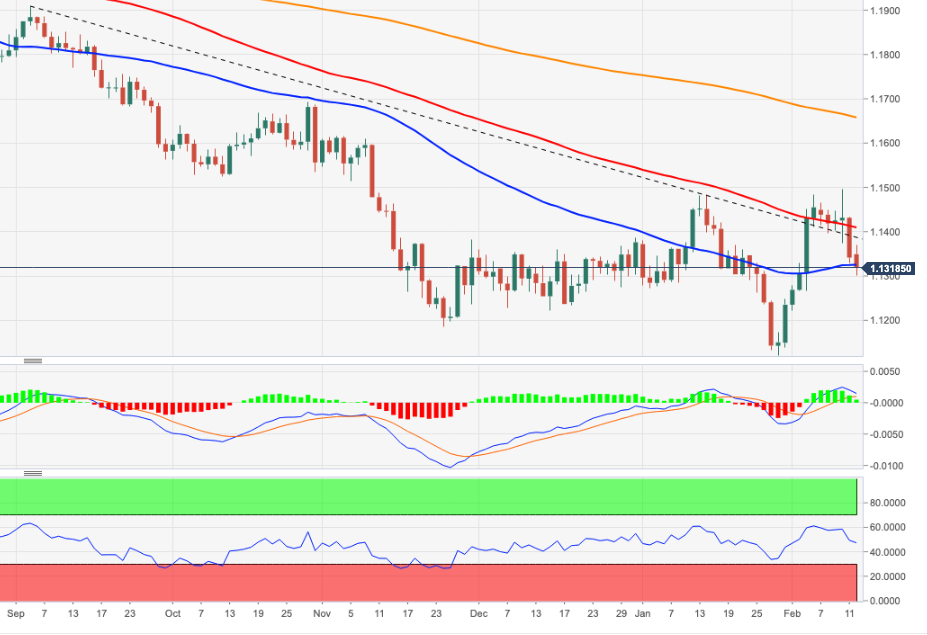
In opinion of Quek Ser Leang at UOB Group’s Global Economics & Markets Research, USD/IDR remains poised to trade between 14,288 and 14,400 for the time being.
Key Quotes
“Last Monday (07 Feb, spot at 14,400), we highlighted that USD/IDR ‘appears poised to break clearly above 14,405’. We added, ‘a clear break of this level is likely to lead to further USD/IDR strength’.”
“While USD/IDR subsequently rose to 14,408, the anticipated advance did not materialize as USD/IDR pulled back from the high. Upward pressure has dissipated and for this week, USD/IDR is likely to trade sideways between 14,288 and 14,400.”
- A combination of supporting factors pushed USD/CAD higher for the third successive day.
- Retreating oil prices undermined the loonie and remained supportive amid a stronger USD.
- Bulls, however, struggled to make it through an over two-week-old trading range resistance.
The USD/CAD pair built on last week's goodish recovery move from the 1.2635 area, or the monthly low and gained positive traction for the third successive day on Monday. The momentum pushed spot prices to over a one-week high and was sponsored by a combination of factors.
Despite escalating geopolitical tensions between Russia and the West over Ukraine, crude oil prices witnessed some profit-taking taking from a more than seven-year high. This, in turn, undermined the commodity-linked loonie and extended some support to the USD/CAD pair amid a broad-based US dollar strength.
Bulls, however, struggled to capitalize on the strength and the intraday positive move faltered near the 1.2780-1.2785 region. The said area marks the monthly high and the top end of a familiar trading range held over the past two weeks or so, which should now act as a key pivotal point for short-term traders.
Given that technical indicators on the daily chart have just started gaining some positive traction, a convincing breakthrough will be seen as a fresh trigger for bulls. Some follow-through buying beyond the 1.2800 mark will reaffirm the constructive outlook and pave the way for a further appreciating move.
The next relevant resistance is pegged near the 1.2835 region, above which the USD/CAD pair could extend the momentum towards the 1.2900 mark, with some intermediate hurdle near the 1.2870-75 area.
On the flip side, the 1.2700 mark now seems to protect the immediate downside ahead of Friday’s swing low, around the 1.2670-1.2665 region. This is followed by the 1.2635 area, or the monthly low, which if broken decisively will negate the near-term positive bias and make the USD/CAD pair vulnerable to slide further.
The downward trajectory could then drag spot prices below the 1.2600 mark, towards testing the 1.2570-1.2560 support and the very important 200-day SMA, around the 1.2520-1.2515 zone. This is followed by the key 1.2500 psychological mark, below which the USD/CAD pair could slide to the YTD low, around mid-1.2400s.
USD/CAD daily chart
-637804434351170152.png)
Key technical levels
St Louis Fed President and 2022 voting FOMC member James Bullard on Monday reiterated his call for 100bps in interest rate hikes by July 1, citing the last four inflation reports which show broadening inflationary pressures. The Fed's credibility is on the line, he continued, saying that the Fed needs to reassure the public that it is going to defend its 2.0% inflation target. Inflation reports since October have called into question the idea that price increases will moderate without Fed action, Bullard said, before cautioning that the Fed needs to act in a way that is not disruptive to markets. The timing of rate hikes would ultimately be up to Fed Chair Jerome Powell, Bullard added, though he did say that he thought his plan was a good one and now would try to persuade his colleagues.
The Fed will be in "a pickle" if inflation does not moderate as expected in the second half of the year, Bullard warned, adding that the bank needs to position for that eventuality now. Bullard noted that he would like to see the yield curve steepen from reducing the size of the Fed's balance sheet, a process he would like to kick off with passive run-off in Q2, with a "plan B" of asset sales if needed.
Market Reaction
Currency markets have not reacted to the latest remarks from Bullard, which were broadly in line with his hawkish post-hot US CPI data comments last week.
- GBP/JPY attracted some dip-buying on Monday and recovered a major part of its intraday losses.
- A turnaround in the risk sentiment undermined the safe-haven JPY and extended some support.
- The lack of any strong follow-through buying warrants some caution for aggressive bullish traders.
The GBP/JPY cross managed to rebound nearly 100 pips from the one-week low touched earlier this Monday and was last seen trading with only modest losses, around the 156.25 region.
The cross extended last week's retracement slide from the vicinity of 2021 high, or levels just above the 156.00 mark and witnessed heavy selling during the first half of the trading on Monday. Tensions over the Northern Ireland protocol of the Brexit agreement, along with Friday's disappointing UK GDP report turned out to be a key factor that undermined the British pound. This, along with the risk-off impulse in the markets, benefitted the safe-haven Japanese yen and exerted additional pressure on the GBP/JPY cross.
That said, a more hawkish Bank of England policy decision should help limit any deeper losses for sterling. It is worth recalling that the BoE raised the benchmark interest rate by 25 bps and the vote distribution showed that four out of nine MPC members backed a more aggressive 50 bps increase in borrowing costs. Apart from this, strong intraday recovery in the equity markets acted as a headwind for the JPY, which helped limit any deeper losses for the GBP/JPY cross and attract fresh buying near the 155.30 area.
The latest comments by Russia's Foreign Minister Sergey Lavrov helped ease worries about an imminent Russian invasion of Ukraine. Lavrov told Russian President Vladimir Putin in a meeting on Monday that the US had put forward concrete proposals on reducing military risks and that he could see a way to move forward with talks. He, however, warned that indefinite talks are not possible, but there was always a chance for agreement. This gave the market some comfort, which was evident from a turnaround in the risk sentiment.
It will now be interesting to see if bulls are able to capitalize on the move or the intraday uptick is seen as an opportunity to initiate fresh bearish positions around the GBP/JPY cross. Hence, it will be prudent to wait for strong follow-through buying before confirming that the recent corrective pullback has run its course. Market participants now look forward to Tuesday's release of the UK jobs report for a fresh impetus.
Technical levels to watch
- Spot gold is consolidating in the $1850-60 area after hitting fresh multi-month highs last Friday on geopolitical tensions.
- As concern about a potential Russian incursion into Ukraine mounts, risks seem tilted to the upside for gold.
- Technical developments also lean bullish after XAU/USD broke above a long-term pennant last week.
Having hit multi-month highs in the $1860s last Friday amid rising geopolitical concerns (as Russian military action against Ukraine, perhaps as soon this week, looks ever more likely) spot gold (XAU/USD) prices have been stabilising in an $1850-60 range. Russia/Ukraine/NATO tensions will be the main driver of market sentiment this week, meaning gold traders will be closely keeping an eye on meetings between Russian and Western politicians over the next two days. The most important of these meetings is a visit by German Chancellor Olaf Scholz to Kiev on Monday and then to Moscow on Tuesday. With US press suggesting that Russian could launch an assault as soon as the middle of the week, and Western leaders warning a Russian attack could come at any time, this meeting may be the last-ditch attempt to prevent war.
Recent news that, in a meeting with Russian President Vladimir Putin, Russian Foreign Minister Sergey Lavrov recommended sticking with the diplomatic path for now, saw gold prices chop within intra-day ranges and did not result in lasting downside. That suggests that risks remain tilted to the upside this week. In the event that diplomacy fails and war does break out, an associated safe-haven bid could easily send XAU/USD towards November’s highs in the $1870s, with a break above that opening the door to a run at the $1900 level. Importantly for the gold bulls, recent technical developments also suggest a bullish bias. Looking at XAU/USD over the past year and a bit, the pair formed a long-term pennant structure. Last Friday, it appeared to break to the upside of this structure, suggesting an extension of upside in the near term.
Aside from geopolitical risks, gold traders will also be keeping an eye on US economic and Federal Reserve developments. January Producer Price Inflation figures are scheduled for release on Tuesday ahead of January Retail Sales and the release of the accounts from the January Fed meeting on Wednesday. Regional Fed Manufacturing surveys for the month of February and a barrage of Fed speak, starting with outspoken hawk James Bullard at 1330GMT on CNBC on Monday, will also be worth keeping an eye on.
Russian Foreign Minister Sergey Lavrov told Russian President Vladimir Putin in a meeting on Monday that the US had put forward concrete proposals on reducing military risks and that he could see a way to move forward with talks. He added that he had proposed to continue with diplomatic work, though warned that indefinite talks are not possible, but that there was always a chance for agreement.
Lavrov did, however, tell Putin that the responses from the EU and NATO to Russian security proposals have not been satisfactory and that Russia will try to get responses from all EU countries. Russia will also continue to try to get a response from the US on unanswered questions.
Market Reaction
The fact that Lavrov recommended a continuation of diplomacy to President Putin has been taken by the market as positive news that reduces the risk of imminent war. US equity futures have spiked as a result, with e-mini S&P 500 futures now in the 4420s having previously traded in the 4380 area.
Elsewhere, as risk appetite has improved and risk assets rallied, safe havens have unsurprisingly taken a dip in recent trade. The US Dollar Index dropped to the 96.10s from previously in the 96.30s, USD/JPY spiked to the 115.40 area from previously in the 115.10s and US 10-year yields spiked higher to around 1.95% from around 1.92%.
- A combination of factors dragged NZD/USD lower for the third successive day on Monday.
- Rising bets for a 50 bps Fed rate hike in March continued acting as a tailwind for the USD.
- The risk-off mood weighed on the perceived riskier kiwi and also contributed to the slide.
The NZD/USD pair maintained its heavily offered tone heading into the North American session and was last seen trading just below the 0.6600 mark, or over a one-week low.
The pair witnessed selling for the third successive day on Monday and moved further away from the monthly high, around the 0.6730-0.6735 region touched last week. The prospects for a faster policy tightening by the Fed acted as a tailwind for the US dollar. This, along with the risk-off impulse in the markets, drove flows away from the perceived riskier kiwi and exerted pressure on the NZD/USD pair.
Investors seem convinced that the Fed will adopt an aggressive policy response to combat stubbornly high inflation and have been pricing in a 50 bps rate hike in March. The market bets were reinforced by the red-hot US CPI report released last Thursday. This, in turn, was seen as a key factor that continued underpinning the greenback and attracted some follow-through selling around the NZD/USD pair on Monday.
Apart from this, worries over an imminent Russian invasion of Ukraine triggered a fresh wave of the global risk-aversion trade, which was evident from a sell-off in the equity markets. In the latest development, a senior Russian military official reportedly said that Russia was ready to open fire on foreign ships and submarines that illegally enter its territorial waters. This further benefitted the safe-haven buck.
From a technical perspective, acceptance below the 0.6600 mark and the NZD/USD pair's inability to attract any buying suggests that the recent bounce from the lowest level since October 2020 has run its course. In the absence of any major market-moving economic releases from the US, traders will take cues from comments by St. Louis Fed President James Bullard, who called for 100 bps rate hikes over the next three FOMC policy meetings.
Technical levels to watch
- DXY climbs to fresh tops further north of the 96.00 hurdle.
- The next target of note comes around 96.90.
DXY posts gains for the third straight session on Monday, extending the recent surpass of the 96.00 barrier.
If the recovery gains more serious traction, then the index is expected to revisit the 96.90 region, where the November and December 2021 highs are located. The surpass of this level should expose a move to the 2022 peak around 97.40 (January 28).
In the near term, the 5-month line near 95.20 is expected to hold the downside for the time being. Looking at the broader picture, the longer-term positive stance in the dollar remains unchanged above the 200-day SMA at 93.62.
DXY daily chart
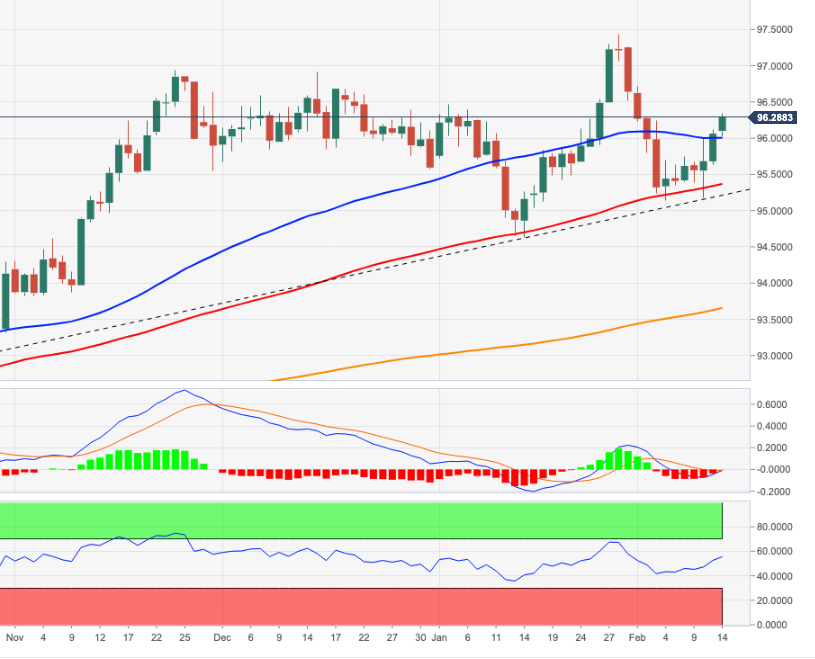
USD/MYR is still seen navigating within the 4.1750-4.2000 range for the time being, noted Quek Ser Leang at UOB Group’s Global Economics & Markets Research.
Key Quotes
“We highlighted last Monday (07 Feb, spot 4.1850) that daily MACD is ‘flattish’ and we held the view that USD/MYR ‘could continue to trade between 4.1620 and 4.2150 for a while more’.”
“Our view was not wrong even though USD/MYR consolidated in a quiet manner and within a narrow range of 4.1800/4.1890. The quiet price actions offer no fresh clues and USD/MYR could continue to trade sideways. Expected range for this week, 4.1750/4.2000.”
- EUR/JPY accelerates losses below the 200-day SMA (130.45).
- The 55-day SMA emerges as the next support at 129.65.
EUR/JPY sinks further south of the key 200-day SMA in the mid-130.00s at the beginning of the week.
The sharp corrective downside appears to have further legs to go in the very near term. Against that, the cross could shed further ground and revisit the 55-day SMA at 129.65 ahead of the February low near 128.90 (February 1) and the 2022 lows in the 128.20 zone recorded in late January.
In the longer run, and while below the 200-day SMA, the outlook for the cross is expected to remain bearish.
EUR/JPY daily chart
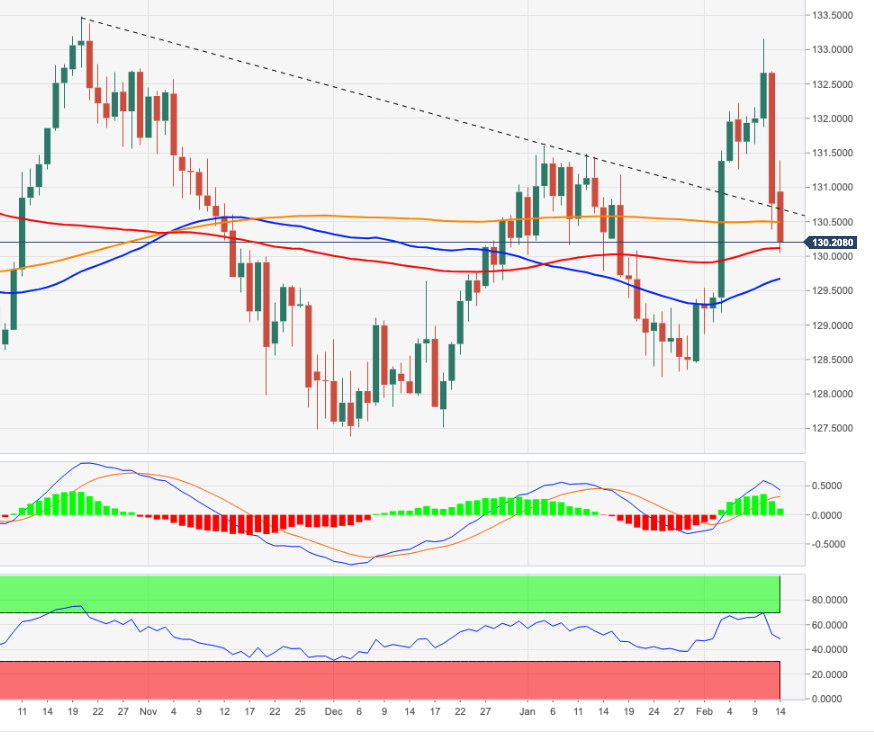
- A combination of factors dragged USD/JPY lower for the second successive day on Monday.
- The risk-off mood benefitted the JPY and exerted pressure amid retreating US bond yields.
- Modest USD strength assisted bulls to defend the key 115.00 round figure, at least for now.
The USD/JPY pair quickly recovered a few pips from the one-week low touched in the last hour and was last seen trading around the 115.20 region, still down nearly 0.20% for the day.
Following an early uptick to the 115.60 area, the USD/JPY pair turned lower for the second successive day on Monday and was pressured by a combination of factors. The risk-off impulse in the markets benefitted the Japanese yen's safe-haven status and acted as a headwind for the major. Bearish traders further took cues from an intraday pullback in the US Treasury bond yields, though a stronger US dollar helped limit any deeper losses.
The global risk sentiment took a hit amid worries over an imminent Russian invasion of Ukraine. In the latest development, a senior Russian military official reportedly said that Russia was ready to open fire on foreign ships and submarines that illegally enter its territorial waters. This further weighed on the market mood and forced investors to take refuge in traditional safe-haven assets, which was evident from sliding US bond yields.
On other hand, the USD remained well supported by the growing market acceptance that the Fed would adopt a more aggressive policy response to contain stubbornly high inflation. In fact, the markets have been pricing in the possibility of a 50 bps rate hike in March. This, in turn, held back bearish traders from placing aggressive bets and assisted the USD/JPY pair to defend the key 115.00 psychological mark, at least for the time being.
Traders now look forward to comments by St. Louis Fed President James Bullard, who called for 100 bps rate hikes over the next three FOMC policy meetings. This, along with the US bond yields, might influence the USD price dynamics amid absent relevant market-moving economic releases. This, along with the broader market risk sentiment and geopolitical developments, should provide some meaningful impetus to the USD/JPY pair.
Technical levels to watch
Quek Ser Leang at UOB Group’s Global Economics & Markets Research noted USD/THB remains poised for extra decline.
Key Quotes
“While we expected USD/THB to weaken last week, we were of the view that ‘the next major support at 32.56 is likely out of reach’. The subsequent weakness exceeded our expectations as USD/THB dropped to 32.56 last Wednesday (09 Feb). The rapid decline is oversold but with no sign of stabilization just yet, there is scope for the weakness in USD/THB to extend.”
“In view of the oversold conditions, the next major support at 32.18 is not expected to come into the picture. On a shorter-term note, 32.65 is already quite a strong support level. Resistance is at 32.85 but only a breach of 33.05 would indicate that the current weakness has stabilized.”
The Interfax news agency reported on Monday that a senior Russian military official said Russia was ready to open fire on foreign ships and submarines that illegally enter its territorial waters, per Reuters.
The official further added that any decisions to open fire on foreign vessels would however only be taken at the highest level.
Market reaction
Markets remain risk-averse during the European trading hours following these remarks. As of writing, US stocks futures were down between 0.8% and 1.1%, Germany's DAX 30 was losing 2.8%.
- A combination of factors dragged AUD/USD lower for the third successive day on Monday.
- Bets for a 50 bps Fed rate hike in March underpinned the buck amid geopolitical tensions.
- The anti-risk flow contributed to the bearish pressure around the perceived riskier aussie.
The AUD/USD pair remained depressed through the first half of the European session and was last seen trading around the 0.7100 mark, just a few pips above the one-week low.
The pair extended last week's rejection slide from the vicinity of mid-0.7200s, or the 100-day SMA hurdle and continued losing ground for the third successive day on Monday. The US dollar remained well supported by the prospects for a faster policy tightening by the Fed. This, along with the risk-off impulse in the markets, weighed on the perceived riskier aussie and exerted pressure on the AUD/USD pair.
The markets seem convinced that the Fed would adopt a more aggressive policy response to combat stubbornly high inflation and have been pricing in a 50 bps rate hike in March. The bets were boosted further after data released last Thursday showed that the headline US CPI accelerated to the highest level since February 1982 during the first month of 2022. Adding to this, the core CPI climbed to 6.0% from a year ago.
Apart from this, worries over an imminent Russian invasion of Ukraine took its toll on the global risk sentiment and further benefitted the greenback's relative safe-haven status. This was seen as another factor that dragged the AUD/USD pair back below the 0.7100 mark. The downtick, however, lacked any follow-through, warranting some caution for aggressive bearish traders and before positioning for any further losses.
In the absence of any major market-moving economic releases, traders might take cues from St. Louis Fed President James Bullard's appearance later during the North American session. It is worth recalling that Bullard called for 100 bps rate hikes over the next three FOMC policy meetings and hence, his remarks, along with the US bond yields, will influence the USD and provide some impetus to the AUD/USD pair.
Apart from this, geopolitical developments and the broader market risk sentiment should allow traders to grab some short-term opportunities around the AUD/USD pair. The focus would then shift to the RBA monetary policy meeting minutes, due for release during the Asian session on Tuesday.
Technical levels to watch
In an interview with the Wall Street Journal on Monday, Esther George, President of the Federal Reserve Bank of Kansas City, argued that the Fed should weigh asset sales to curb inflation, as reported by Reuters.
Geroge further added that they should remove stimulus in a systematic way.
Market reaction
These comments don't seem to be having a significant impact on the dollar's performance against its major rivals. As of writing, the US Dollar Index was rising 0.23% on a daily basis at 96.25.
GBP/USD has declined toward 1.3500 pressured by risk aversion. The bearish pressure could ramp up in case that levels turn into resistance, FXStreet’s Eren Sengezer reports.
1.3520 forms the first technical resistance
“1.3500 (psychological level, Fibonacci 50% retracement of the latest uptrend) aligns as critical support. If a four-hour candle closes below that level and uses it as resistance, the next bearish target is located at 1.3470 (Fibonacci 61.8% retracement) ahead of 1.3440 (static level).”
“On the upside, 1.3520 (Fibonacci 38.2% retracement) forms the first technical resistance before the 1.3550/1.3560 area (200-period SMA, Fibonacci 23.6% retracement).”
- A combination of supporting factors pushed USD/CAD to over a one-week high on Monday.
- Retreating oil prices undermined the loonie and extended some support amid stronger USD.
- Hawkish Fed expectations, the risk-off impulse continued benefitting the safe-haven buck.
The USD/CAD pair quickly retreated a few pips from over one-week high touched in the last hour and was last seen trading around the 1.2765 region, still up over 0.60% for the day.
The pair caught fresh bids during the early European session and broke out its intraday consolidation phase, with bulls now looking to build on last week's rebound from the monthly low. Despite the risk of a further escalation in the conflict between Russia and the West over Ukraine, crude oil prices pulled back from a more than seven-year high touched earlier this Monday. This, in turn, undermined the commodity-linked loonie and provided a goodish lift to the USD/CAD pair amid fresh US dollar buying.
The greenback remained well supported by growing acceptance that the Fed will tighten its monetary policy at a faster pace than anticipated to combat stubbornly high inflation. In fact, the markets have been pricing in the possibility of a 50 bps Fed rate hike move in March. The bets were boosted further after data released last Thursday showed that the headline CPI reached the highest level since February 1982 and the core CPI, which excludes food and energy prices, climbed 6.0% from a year ago.
Apart from this, the risk-off impulse – as depicted by a sell-off across the equity markets – further benefitted the greenback's safe-haven status. This was seen as another factor that contributed to the USD/CAD pair's strong intraday positive move. The global risk sentiment took a hit after US National Security Advisor Jake Sullivan warned on Sunday that “we are in the window where a Russian invasion of Ukraine could begin at any time and could happen during the Beijing winter Olympics.”
It, however, remains to be seen if bulls are able to capitalize on the move or the USD/CAD pair continues with its break through the 1.2800 mark amid absent economic releases from the US or Canada. Hence, the market focus will remain on geopolitical developments, which will influence oil price dynamics. Apart from this, traders will take cues from the broader market risk sentiment. This, along with the US bond yields, will drive the USD demand and provide some impetus to the USD/CAD pair.
Technical levels to watch
- EUR/USD revisits the 1.1300 region on Monday.
- The dollar remains bid amidst persistent risk aversion.
- US 10y yields trade on the defensive near the 1.90% mark.
The single currency sheds further ground and forces EUR/USD to put the 1.1300 support level to the test on Monday’s European morning.
EUR/USD looks to geopolitics, risk aversion
EUR/USD retreats for the second session in a row and extends further the rejection from last week’s tops near 1.1500 the figure soon after the release of US inflation figures for the month of January (February 10).
In addition, the focus of attention remains on the short end of the yield curve in both the US and German cash markets as important drivers of the pair's price action, particularly folllowing the last FOMC and ECB events. In the meantime, German 10y Bund yields keep correcting lower following recent tops, widening at the same time the spread differential vs. its American peer, which remains another source of weakness for the pair at the beginning of the week.
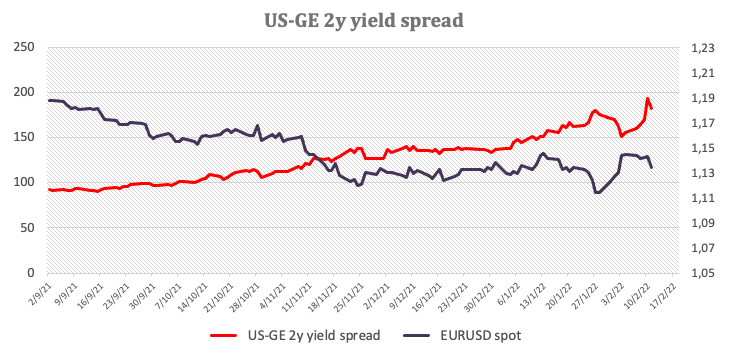
Nothing scheduled data wise on both sides of the Atlantic, although the speech by Chair Lagarde later in the old continent should garner some attention.
What to look for around EUR
EUR/USD could not sustain the post-US CPI raise to the vicinity of the 1.1500 barrier, sparking a corrective move to the boundaries of 1.1300 on the back of the renewed and quite strong bias towards the US dollar. Despite the ongoing knee-jerk, the improvement in the pair’s outlook appears underpinned by fresh speculation of a potential interest rate hike by the ECB at some point by year end, higher German yields, persevering elevated inflation and a decent pace of the economic activity and other key fundamentals in the region
Key events in the euro area this week: ECB Lagarde (Monday) – Advanced EMU Q4 GDP, EMU/Germany ZEW Economic Sentiment (Tuesday) – EMU Industrial Production (Wednesday) – Flash EMU Consumer Confidence (Friday).
Eminent issues on the back boiler: Asymmetric economic recovery post-pandemic in the euro area. Speculation of ECB tightening/tapering later in the year. Presidential elections in France in April. Geopolitical concerns from the Russia-Ukraine conflict.
EUR/USD levels to watch
So far, spot is retreating 0.27% at 1.1314 and faces the next up barrier at 1.1491 (200-week SMA) seconded by 1.1494 (2022 high Feb.10) and finally 1.1656 (200-day SMA). On the other hand, a break below 1.1303 (weekly low Feb.14) would target 1.1186 (monthly low Nov.24 2021) en route to 1.1121 (2022 low Jan.28).
UOB Group’s FX Strategists expect USD/CNH to remain side-lined in the next weks.
Key Quotes
24-hour view: “Our expectations for USD to ‘edge higher’ last Friday did not materialize as it traded sideways between 6.3525 and 6.3695 before closing little changed at 6.3668 (+0.05%). Momentum indicators are mostly neutral and further sideway-trading would not be surprising. Expected range for today, 6.3550/6.3730.”
Next 1-3 weeks: “There is no change in our view from last Monday (07 Feb, spot at 6.3600). We continue to view the current movement as part of a consolidation phase and expect USD to trade between 6.3400 and 6.3805 for now.”
- GBP/USD witnessed aggressive selling on Monday and dropped to a one-week low.
- The impasse over the Northern Ireland Protocol acted as a headwind for sterling.
- The emergence of fresh USD buying also contributed to the sharp intraday decline.
The GBP/USD pair dropped to a one-week low during the first half of the European session, with bears now looking to extend the downfall further below the key 1.3500 psychological mark.
Following an early uptick to the 1.3570 area, the GBP/USD pair came under renewed selling pressure on Monday and extended its recent pullback from the 1.3645 region, or the monthly high touched last week. Tensions over the Northern Ireland protocol of the Brexit agreement, along with Friday's disappointing UK GDP report turned out to be a key factor that acted as a headwind for the British pound. This, along with, the emergence of fresh US dollar buying, exerted pressure on the major and contributed to the latest leg down.
The greenback continued drawing support from growing acceptance that the Fed would adopt a more aggressive policy response to contain stubbornly high inflation. In fact, the market bets for a 50 bps Fed rate hike in March were boosted further following the release of the red-hot US CPI report on Thursday. Apart from this, the risk-off impulse – as depicted by a sea of red across the global equity markets – further benefitted the greenback's safe-haven status and added to the heavy intraday selling around the GBP/USD pair.
The recent price action witnessed over the past one week or so suggests that the markets have digested a more hawkish Bank of England. It is worth recalling that the raised the benchmark interest rate by 25 bps and the vote distribution showed that four out of nine MPC members backed a more aggressive 50 bps increase in borrowing costs. This, in turn, supports prospects for a further near-term depreciating move for the GBP/USD pair amid absent relevant market-moving economic releases, either from the UK or the US.
Traders, however, will take cues from comments by St. Louis Fed President James Bullard, who called for 100 bps rate hikes over the next three FOMC policy meetings. This, along with the US bond yields and the broader market risk sentiment, will influence the USD price dynamics and provide some impetus to the GBP/USD pair.
Technical levels to watch
- Gold price gathers strength for the next upswing towards $1,878.
- US inflation concerns and the Russia-Ukraine turmoil to offer support.
- Gold corrects before resuming uptrend, focus on Russia-Ukraine crisis.
Gold price is taking a breather after a blistering $40 rally seen on Friday, which drove the bright metal to the highest level in three months at $1,866. Reports about a potential Russian invasion of Ukraine this week roiled markets and triggered a massive flight to safety into gold price. The bullion remains in a win-win situation going forward amid rising inflation concerns and as investors watch over the geopolitical risks concerning Ukraine. Gold traders also await Wednesday’s US Retail Sales data and the Fed minutes for fresh directives.
Read: Russia could initiate military action before the end of the Winter Olympics: Could this affect stocks?
Gold Price: Key levels to watch
The Technical Confluences Detector shows that the gold price has recaptured powerful support now resistance at $1,855, as its corrective pullback fades.
That level is the convergence of the Fibonacci 23.6% one-day and the previous month’s high.
The immediate upside barrier is seen at the Bollinger Band one-day Upper at $1,859. The next bullish target appears at the previous day’s high of $1,866.
Acceptance above the latter will fuel a fresh upswing towards $1,878, the pivot point one-day R1.
On the flip side, if gold price finds a strong foothold below the aforementioned $1,855, then the Fibonacci 23.6% one-week at $1,851 will get tested.
Further down, the Fibonacci 38.2% one-day at $1,848 will come to buyers’ rescue. The last line of defense for gold bulls is aligned at $1,843, the intersection of the Fibonacci 38.2% one-week, SMA10 four-hour and pivot point one-month R1.
Here is how it looks on the tool
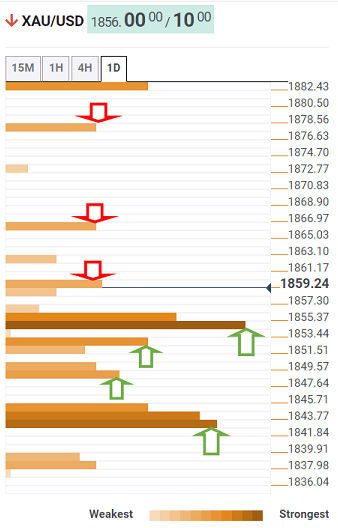
About Technical Confluences Detector
The TCD (Technical Confluences Detector) is a tool to locate and point out those price levels where there is a congestion of indicators, moving averages, Fibonacci levels, Pivot Points, etc. If you are a short-term trader, you will find entry points for counter-trend strategies and hunt a few points at a time. If you are a medium-to-long-term trader, this tool will allow you to know in advance the price levels where a medium-to-long-term trend may stop and rest, where to unwind positions, or where to increase your position size.
EUR/USD suffered heavy losses late Friday and has started the new week on the back foot. The pair could extend its slide if the 1.1300 support fails, FXStreet’s Eren Sengezer reports.
Focus shifts to ECB President Christine Lagarde's speech
“Later in the session, European Central Bank President Christine Lagarde will deliver a speech. In case Lagarde sounds less hawkish than she did at the ECB's press conference on February 7, the pair could face additional bearish pressure.”
“On the downside, 1.1300 (psychological level, Fibonacci 50% retracement of the latest uptrend) aligns as the first support. In case this level turns into resistance, the next bearish target aligns at 1.1260 (Fibonacci 61.8% retracement).”
“The first technical hurdle is located at 1.1320 (100-period SMA) before 1.1340 (200-period SMA, Fibonacci 38.2% retracement) and 1.1370 (Fibonacci 23.6% retracement).”
See: EUR/USD to slide towards 1.1250/00 on a break below 1.13 – ING
Gold surged to its strongest level since mid-November at $1,865 on Friday. Economists at Société Générale believe the yellow metal has potential to reach the November high of $1,877 and even the $1,923/1,930 area.
Last month's low of $1,790/1,780 to cushion downside
“Gold is now attempting a cross above the descending trend line which has capped the recoveries since September 2020. This break points towards possibility of a bounce towards last November's high of $1,877 and perhaps even towards projections of $1,923/1,930. It could be a crucial resistance.”
“Last month's low of $1,790/1,780 is expected to cushion downside near-term.”
EUR/SEK rises back to pre-pandemic levels around 10.60 as cautious Riksbank leaves the krona vulnerable to further weakness. Economists at MUFG Bank expect the bearish SEK trend of recent months to remain in place in the near-term.
SEK remains sensitive to equity market weakness
“The Riksbank’s reluctance to join other central banks by bringing forward tightening plans leaves the SEK vulnerable to further near-term weakness.”
“A bigger hawkish pivot in Riksbank policy will be required to trigger a reversal.”
“The SEK remains sensitive to equity market weakness as well.”
See: EUR/SEK to wait until mid-2Q before seeing a decisive retrace to 10.40 – ING
The NZD/USD is expected to climb gradually to 0.70 by by the end of the year as the kiwi catches up with strong fundamentals in the Antipodeans, economists at ING report.
Time to re-connect with fundamentals
“The kiwi has a strong set of domestic fundamentals it can count on, and this should continue to be the case in the foreseeable future.”
“A positioning shift to oversold territory means that we could see some stabilisation in NZD, and a February Reserve Bank of New Zealand hike may revamp the currency’s correlation with rate differentials. The market is pricing six hikes in 2022, which seems reasonable (it is our forecast).
“Milk prices back to the 2021 highs may also help NZD.”
“We expect a recovery in NZD/USD to 0.70 by the end of the year.”
The British pound continues to perform well, with the Bank of England (BoE) firmly in the hawkish camp with the Federal Reserve. Therefore, economists at ING expect the GBP to stay resilient in the first half of the year.
BoE to be happy with a strong pound
“We now look for further 25bp hikes on 17 March and 5 May.”
“Our call is that the BoE will pause at a 1.00% base rate to take stock. And the market will then focus on BoE active Gilt sales. But the market prices a 2.00% bank rate by year-end. That’s unlikely.”
“For 1H22, we expect BoE to be happy with a strong pound to insulate against higher gas prices and GBP can withstand $ strength.”
- USD/CHF struggled to gain any meaningful traction and remained confined in a range on Monday.
- Geopolitical tensions benefitted the CHF’s safe-haven status and acted as a headwind for the pair.
- Hawkish Fed expectations, elevated US bond yields underpinned the USD and help limit any losses.
The USD/CHF pair seesawed between tepid gains/minor losses through the early European session and was last seen trading in the neutral territory, around mid-0.9200s.
A combination of diverging forces failed to provide any meaningful impetus to the USD/CHF pair and led to subdued/range-bound price moves on the first day of a new week. The risk-off mood benefitted the safe-haven Swiss franc and acted as a headwind. That said, expectations for a more aggressive Fed acted as a tailwind for the US dollar and extended support to the major.
Worries over an imminent Russian invasion of Ukraine took its toll on the global risk sentiment, which was evident from a generally weaker tone around the equity markets. In fact, the US National Security Advisor Jake Sullivan warned on Sunday that “we are in the window where a Russian invasion of Ukraine could begin at any time and could happen during the Beijing winter Olympics.”
On the other hand, the USD continued drawing support from rising bets for a 50 bps Fed rate hike in March, which was further boosted by the red-hot US CPI last week. This was reinforced by elevated US Treasury bond yields, which should continue to underpin the greenback and the USD/CHF pair, at least for now, amid absent relevant market moving economic releases from the US.
Traders now look forward to comments from St. Louis Fed President James Bullard, who called for 100 bps rate hikes over the next three FOMC policy meetings. Apart from this, the US bond yields will influence the USD price dynamics. This, along with geopolitical developments and the broader market risk sentiment, might produce some trading opportunities around the USD/CHF pair.
Technical levels to watch
Vadym Prystaiko, Ukraine's ambassador to the UK, said in a statement on Monday, “to avoid war, we are ready for many concessions.”
Additional quotes
“But they have nothing to do with NATO.”
“Commitment to NATO membership is enshrined in Ukrainian constitution.”
“Ukraine not delaying ambitions to join NATO.”
With West Texas Intermediate (WTI) crude piercing the $90/bbl mark, chatter of $100+ oil has picked up further steam. Is peak oil supply on the horizon? According to strategists at the Bank of Montreal, it is probably too early to declare peak oil supply has arrived.
Outlook for demand looks pretty clear
“It’s the growing risk that global oil supply could increasingly lag the recovery in demand that is underpinning the surge. This has prompted us to revise up our WTI forecast to $85/bbl in 2022 and $80 in 2023 (previously $75 and $77.50, respectively).”
“Outlook for demand looks pretty clear. Global oil demand is likely to grind higher in line with the International Energy Agency’s (IEA) projection of 100.6 mb/d in 2022. From a medium-term perspective, we would expect global oil demand to increase roughly 0.75 mb/d on an annual basis as the pandemic moves to the rearview mirror.”
“The new, big unknown is whether recent under-production among OPEC+ members is due to years of underinvestment and maturing oil fields or more a result of temporary technical and operational issues as the IEA recently characterized.”
EUR/SEK has hit the 10.60 level. Economists at ING expect the Swedish krona to strengthen but that may have to wait until at least the mid of the second quarter.
Undervalued, but no recovery soon
“We may have to wait until mid-2Q before seeing a decisive retrace to the 10.40 mark despite the EUR/SEK pair being around 2% overvalued in the short-term (according to our fair value model). That’s because the combination of a dovish Riksbank, negative exposure to US tech stock woes and geopolitical risk in Ukraine should all curb the krona's recovery.”
“If EUR/SEK remains stuck around 10.60 with risks of a move to 10.70-10.80, USD/SEK could easily see a rise to the 9.48 January high, especially if tensions in Ukraine continue to build.”
- DXY trades with mild gains just above the 96.00 mark.
- US yields trade within a mixed tone around Friday’s levels.
- Investors’ attention remains on the Russia-Ukraine front.
The US Dollar Index (DXY), which gauges the greenback vs. a bundle of its main competitors, trades within a narrow range just above the 96.00 yardstick at the beginning of the week.
US Dollar Index focuses on geopolitics, yields
The index looks to extend the upside for the third session in a row in a context still favourable to the safe haven universe and always against the backdrop of rising cautiousness in light of the Russia-US standoff around Ukraine.
The US cash markets also remain vigilant, with yields navigating a narrow range and close to recent peaks. Indeed, the strong rebound in US yields following higher-than-expected US inflation figures in January and prospects of a tighter Fed’s rate path this year appear to be taking a breather as geopolitical factors continue to dictate the sentiment among traders.
Speaking about sentiment, the dollar managed to leave behind Friday’s 11-year low in the US U-Mich Index, which tracks the US Consumer Sentiment.
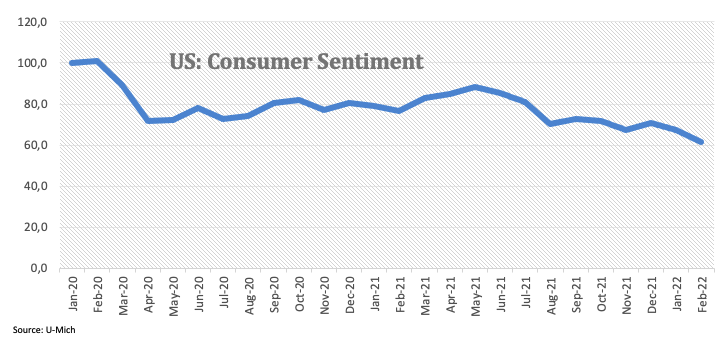
Nothing scheduled in the US docket on Monday is expected to keep the attention on the publication of the FOMC Minutes and Retail Sales, both due later in the week.
What to look for around USD
Higher-than-expected US inflation figures lent extra oxygen to the greenback and propelled DXY back above the 96.00 yardstick last week. However, the extent and duration of this improvement in the dollar remains to be seen, as much of the current elevated inflation narrative was already priced in by market participants as well as the probability (bigger now) of a 50 bps rate hike by the Fed (instead of the more conventional 25 bps move). Looking at the longer run, and while the constructive outlook for the greenback appears well in place for the time being, recent hawkish messages from the BoE and the ECB carry the potential to undermine the expected move higher in the dollar in the next months.
Key events in the US this week: Producer Prices (Tuesday) – MBA Mortgage Applications, Retail Sales, Industrial Production, NAHB Index, FOMC Minutes (Wednesday) – Building Permits, Housing Starts, Initial Claims, Philly Fed Manufacturing Index (Thursday) – CB Leading Index, Existing Home Sales (Friday).
Eminent issues on the back boiler: Escalating geopolitical effervescence vs. Russia and China.Fed’s rate path this year. US-China trade conflict under the Biden administration. Debt ceiling issue.
US Dollar Index relevant levels
Now, the index is gaining 0.10% at 96.12 and a break above 96.25 (high Feb.3) would open the door to 97.44 (2022 high Jan.28) and finally 97.80 (high Jun.30 2020). On the flip side, the next down barrier emerges at 95.17 (weekly low Feb.10) followed by 95.13 (weekly low Feb.4) and then 94.62 (2022 low Jan.14).
Despite a few hiccups, AUD/USD has recovered some ground after touching sub-0.70 levels at the end of January. However, economists at ING expect the aussie to remain under pressure over the first half of the year.
RBA rate expectations are way overdone
“The improvement in China’s growth sentiment thanks to accommodative government and central bank policies are also helping the highly exposed AUD, but Beijing’s zero-Covid policy continues to cloud the outlook in the region.”
“The Reserve Bank of Australia has proved to be a secondary factor for AUD, but we think that rate expectations are way overdone, and expect only one hike in 4Q.”
“Downside risks should prevail for AUD/USD in the first half of the year, also due to USD strength.”
EUR/USD is moving sideways in a relatively tight range below 1.1350 early Monday. A break under 1.1300 would open up the 1.1250-00 area, economists at ING report.
Risks tilted to the downside
“A break below 1.1400 in EUR/USD last week is likely signalling that the European Central Bank members’ recent attempt to cool down excessive hawkish speculation has eventually got to the euro. The common currency looks a bit more vulnerable at this stage, also due to its sensitivity to the Ukrainian situation.”
“Another break lower – below 1.1300 – could generate some further bearish momentum in EUR/USD that could extend to the 1.1200-1.1250 area should markets scale back bets on summer tightening by the ECB.”
Economists at Danske Bank are once again changing their Federal Reserve forecasts. They expect a total of 200bp rate hikes this year starting with 50bp in March.
US recession fears are on the rise, as the US yield curve flattens
“We change our Fed call and now expect the Fed to deliver 200bp rate hikes this year (versus 125bp previously). We expect the Fed to hike by 50bp in March and 25bp on each of the following six meetings. If so, the Fed funds target range should be 2.00- 2.25% by the end of the year.”
“We expect the Fed to hike three times in 2023 and go on hold when the Fed funds target range reaches 2.75-3.00%.”
“We will not be surprised if the Fed announces it ends QE immediately although it did not happen over the weekend. We now expect the Fed to start QT in May with a cap between USD100-125bn (from June and USD75-100bn previously).”
“We still see risks skewed towards the Fed pulling the emergency brake by hiking sooner and more forcefully. This also means a higher risk of a recession down the road and we will not be surprised if the yield curve inverts reflecting higher recession fears.”
“The Fed needs to slow demand and reduce inflation fears by tightening monetary and financial conditions and that also increases the risk of a hard landing instead of a soft one.”
- EUR/GBP caught fresh bids on Monday and recovered a part of the previous session’s losses.
- Tensions over the Northern Ireland Protocol of the Brexit agreement undermined the GBP.
- Absent relevant macro data might cap gains ahead of the ECB President Lagarde's comments.
The EUR/GBP cross maintained its bid tone through the early European session and was last seen trading near the daily high, around the 0.8375-0.8380 region.
The cross attracted fresh buying near the 0.8355 area, or a one-and-half-week low touched earlier this Monday and recovered a part of the previous session's steep decline. The British pound's relative underperformance comes amid tensions over the Northern Ireland protocol of the Brexit agreement and Friday's disappointing UK GDP figures.
That said, a more hawkish Bank of England policy decision should help limit any deeper losses for sterling, at least for now.
It is worth recalling that the BoE raised the benchmark interest rate by 25 bps and the vote distribution showed that four out of nine MPC members backed a more aggressive 50 bps increase in borrowing costs.
On the other hand, the European Central Bank officials have pushed back against bets for an early policy tightening. In fact, ECB member Olli Rehn warned on Saturday that overreacting to inflation by the central bank could stem the economic growth. Moreover, ECB's Gabriel Makhlouf said that investors are wrong to bet on a rate hike in June.
Hence, the market focus will be on the ECB President Christine Lagarde's testimony before the European Parliament for a fresh impetus later during the North American session. This might hold back traders from placing aggressive bullish bets amid absent relevant market-moving economic releases, either from the UK or the Eurozone.
Technical levels to watch
USD/JPY has re-approached the highs of the year consistent with its tight correlation with US interest rates. 120 remains the target of analysts at ING.
Bank of Japan remains resolutely dovish
“So far, the BoJ is one of the very few central banks to disavow the need for tighter policy. BoJ Governor Kuroda has also seemed, surprisingly, to be welcoming a weaker JPY and not to be concerned over higher energy prices.”
“The door now seems open to 120.”
The main risk is an extended equity correction should the Fed tighten too fast. Lower long-dated US yields would be the signal.”
In advance of what could be a very aggressive Fed tightening cycle, analysts at ING remain bullish on the dollar. Regarding EUR/USD, the recent hawkish turn from the European Central Bank (ECB) suggests the pair will probably play out a broad 1.10-1.15 range this year.
March will be a pivotal month for financial markets
“10 March sees the ECB release new inflation forecasts and potentially opens the door for a 4Q rate hike. 16 March sees the Fed release new Dot Plots and possibly starts off the cycle with a 50bp hike. We currently look for five hikes in total from the Fed in 2022.”
“Expect realised volatility to continue to rise.”
“Our preference now is that EUR/USD traces out something like a 1.10/1.12 to 1.15 trading range as we brace for major central bank tightening.”
Following the recent price action, USD/JPY is now predicted to gyrate around 114.75 and 116.05 in the next weeks, suggested FX Strategists at UOB Group.
Key Quotes
24-hour view: “Our expectations for a higher USD last Friday were incorrect as it sold off sharply and cracked a few strong support levels with ease (low has been 115.00). Despite the sharp bounce from the low, the risk remains on the downside. For today, USD could retest 115.00 but a sustained decline below this level is unlikely (the next support is at 114.75). Resistance is at 115.60 followed by 115.85.”
Next 1-3 weeks: “The sharp sell-off in USD to a low of 115.00 last Friday came as a surprise. The break of our ‘strong support’ at 115.40 indicates that the recent upward pressure has dissipated. The current movement is viewed as part of a consolidation and USD is likely to trade between 114.75 and 116.05 for now. Looking ahead, a break of 114.75 could potentially trigger a deep decline in USD.”
Considering advanced figures from CME Group for natural gas futures markets, open interest shrank for the fifth consecutive session on Friday, now by around 8.3K contracts. On the other hand, volume extended the choppy activity and went up by around 111.3K contracts.
Natural Gas remains capped by the 200-day SMA
Friday’s inconclusive session in prices of natural gas was amidst shrinking open interest and an equally erratic trend in volume. That said, further losses appear not favoured in the very near term, allowing for some consolidation or an attempt of recovery in the next sessions. On the upside, the 200-day SMA at $4.22 per MMBtu emerges as the next hurdle of note for bulls.
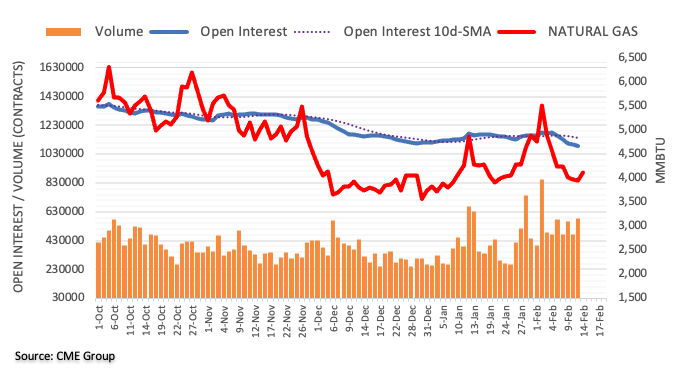
AUD/USD could extend the range bound theme within 0.7055 and 0.7240 for the time being, noted FX Strategists at UOB Group.
Key Quotes
24-hour view: “We highlighted last Friday that ‘the bias is on the downside but any AUD weakness is unlikely to break 0.7110’. However, AUD dipped to 0.7109, rebounded to 0.7184 before dropping back down to close at 0.7137 (-0.45%). Despite the relatively choppy price actions, the underlying tone appears to have softened. From here, AUD could decline to 0.7100. A sustained drop below this level appears unlikely for now. Resistance is at 07155 followed by 0.7180.”
Next 1-3 weeks: “There is not much to add to our update from last Friday (11 Feb, spot at 0.7150). As highlighted, the recent build-up in momentum has dissipated. The outlook appears to be neutral and AUD could trade within a broad range of 0.7055/0.7240 for now.”
- NZD/USD edged lower for the third successive day and dropped to a one-week low on Monday.
- Rising bets for a 50 bps Fed rate hike, elevated US bond yields continued underpinning the USD.
- The risk-off impulse further weighed on the perceived riskier kiwi and added to the selling bias.
The NZD/USD pair remained depressed through the early European session and was last seen trading around the 0.6625 area, just a few pips above the one-week low touched earlier this Monday.
The pair witnessed some selling for the third successive day and retreated further from a nearly three-week high, around the 0.6730-0.6735 region touched last Thursday. Worries over an imminent Russian invasion of Ukraine took its toll on the global risk sentiment, which was evident from a generally weaker tone around the equity markets. This, in turn, was seen as a key factor that benefitted the US dollar's relative safe-haven status and drove flows away from the perceived riskier kiwi.
Apart from this, the greenback was further underpinned by rising bets for a faster policy tightening by the Fed, boosted by the red-hot US CPI report released last week. In fact, the markets have been pricing in the possibility of a 50 bps rate hike in March, which remained supportive of elevated US Treasury bond yields. The fundamental backdrop favours the USD bulls and supports prospects for an extension of the depreciating move for the NZD/USD pair amid absent relevant economic releases.
That said, traders might take cues from St. Louis Fed President James Bullard's appearance later during the North American session. It is worth recalling that Bullard took a more hawkish stance and said that the US central bank should hike rates by 100 basis points over the next three meetings. His remarks might influence the USD price dynamics. Apart from this, geopolitical developments, along with the broader market risk sentiment, should produce some impetus to the NZD/USD pair.
Technical levels to watch
Gold price is trading around $1,850, retreating from three-month highs of $1,866, as investors take profits off the table after the recent upsurge. But as FXStreet’s Dhwani Mehta notes, XAU/USD is set to resume the uptrend.
Golden cross remains in play
“The looming geopolitical tensions between Russia and Ukraine will remain the biggest risks for markets, which could potentially keep gold underpinned.”
“Immediate support is seen at $1,846, the 23.6% Fibonacci Retracement level of the rally from January 28 that peaked out last Friday. Further south, the February 10 highs of $1,842 will be tested, below which floors could open up towards 38.2% Fibo level of the same ascent.”
“The correction appears short-lived for gold, as the golden cross remains in play while the 14-day Relative Strength Index (RSI) still holds comfortable above the central line, despite the latest downtick.”
“If buyers regain poise, then a retest of the multi-month highs at $1,866 will be inevitable. The next critical resistance area is seen around $1,870-$1,872 price zone, which is the November peaks.”
- USD/TRY prints mild gains after four consecutive days of losses.
- Corrective pullback from 200-SMA fails to cross 50-DMA, steady RSI adds strength to bearish bias.
- Fortnight-old horizontal resistance also challenges pair buyers, monthly support line restrict immediate declines.
USD/TRY fades bounce off 200-SMA while taking rounds to $13.50 heading into Monday’s European session.
In doing so, the Turkish lira (TRY) pair remains below 50-SMA amid steady RSI conditions.
Other than the immediate hurdle around $13.55, comprising the 50-SMA, a two-week-old horizontal resistance area around $13.65 will also challenge the USD/TRY bulls.
Should USD/TRY prices rise past $13.65, the pair’s run-up towards the $14.00 threshold can’t be ignored.
Meanwhile, a one-month-old ascending support line near $13.35 restricts short-term declines of the pair ahead of the horizontal support zone from January 20, close to $13.25.
During the quote’s weakness past $13.25, the $13.00 round figure and January’s low near $12.75 should lure the USD/TRY bears.
USD/TRY: Four-hour chart

Trend: Bearish
Here is what you need to know on Monday, February 14:
Safe-haven flows dominated the financial markets ahead of the weekend amid renewed fears over a Russia-Ukraine military conflict and investors stay cautious early Monday. The economic docket will not be featuring any high-impact data releases and the risk perception is likely to remain the primary driver of financial markets. Additionally, European Central Bank (ECB) President Christine Lagarde and St. Louis Fed president James Bullard will be delivering speeches later in the day.
Late Friday, several news outlets reported that Russia was expected to invade Ukraine as soon as this week. Over the weekend, the White House said that the US will respond "swiftly and decisively" to any further Russian aggression against Ukraine. US President Biden's national security adviser, Jake Sullivan, told CNN that an invasion could take place before February 20.
Japan's Nikkei 225 Index lost more than 2% on Monday and the Shanghai Composite Index is down more than 1%. US stock index futures trade flat in the early European session and the benchmark 10-year US Treasury bond yield, which lost nearly 6% on Friday, is up 2% at 1.95%. The US Dollar Index, which tracks the greenback's performance against a basket of six major currencies, is staying relatively quiet near 96.00 after rising 0.5% last week.
Meanwhile, oil prices continue to push higher with the barrel of West Texas Intermediate (WTI) trading at its highest level since September 2014 at $94.20.
EUR/USD fell sharply late Friday and touched its lowest level in more than a week at 1.1329. The pair is moving sideways in a relatively tight range below 1.1350 early Monday.
GBP/USD is posting small losses below 1.3550 heading into the European session. The UK's Office for National Statistics will release the labour market data on Tuesday.
USD/JPY fell nearly 100 pips on Russia-Ukraine headlines but seems to have steadied above 115.00. Recovering US Treasury bond yields are helping the pair limit its losses.
Gold surged to its strongest level since mid-November at $1,865 on Friday. XAU/USD was last seen consolidating its gains around $1,850.
Bitcoin registered small losses over the weekend after facing heavy selling pressure on Friday but it managed to stay afloat above $40,000. Ethereum moves sideways below $3,000 after closing the previous four days in the negative territory.
CME Group’s preliminary readings for crude oil futures markets note traders scaled back their open interest positions by around 19.3K contracts at the end of last week. Volume, instead, rose for the third session in a row, this time by around 328.2K contracts, the largest single-day build since November 26 2021.
WTI looks overbought, targets $100/bbl
Friday’s important uptick in prices of the WTI was on the back of shrinking open interest, hinting at the idea that a corrective move could be in the offing in the very near term. This view is supported by the overbought condition of the commodity, as the RSI hovers around the 75.00 level. The rally in crude oil, in the meantime, now shifts the attention to the psychological $100.00 mark per barrel.
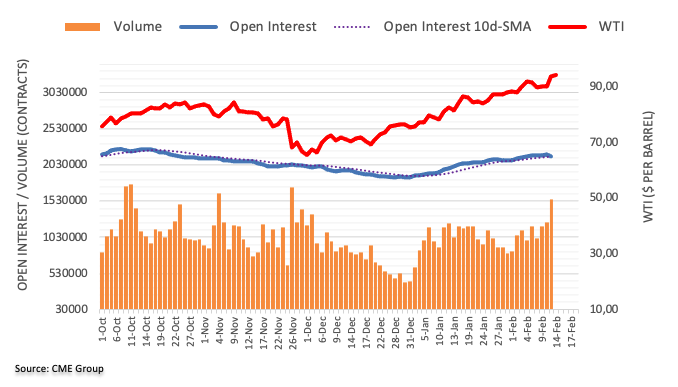
- USD/CAD snaps two-day uptrend, grinds higher of late.
- US-Canada trade link re-established after police cleared protests against covid restrictions.
- Oil prices stay firmer amid Russia-Ukraine war fears even as Kyiv recently requested Moscow for a meeting.
- Risk catalysts will be crucial for intraday moves, FOMC Minutes becomes the week’s key event.
USD/CAD holds onto mild losses around 1.2730 ahead of Monday’s European session.
The loonie pair drops for the first time in three days as easing geopolitical tensions in Canada and abroad, as well as upbeat oil prices, favor the Canadian dollar (CAD). It should be noted, however, that a light calendar and indecision over Russia-Ukraine situations, not to forget cautious mood at the Fed, restricts the quote’s immediate moves.
“North America's busiest trade link reopened for traffic late Sunday evening, ending a six-day blockade, Canada Border Services Agency said, after Canadian police cleared the protesters fighting to end COVID-19 restrictions,” said Reuters.
On the other hand, Ukraine recently requested Russia for a meeting, which in turn tamed geopolitical fears of imminent war as signaled by the Western leaders the previous day.
In adding to the ebbing risk-off mood, a lack of clarity over the Fed’s next move also weigh on USD/CAD prices, not to forget the upbeat prices of Canada’s key export WTI crude oil. It should be noted that WTI crude oil trades near the highest levels since late 2014 while taking rounds to $93.00 of late.
The markets went gung-ho about the 50 basis points (bps) of Fed-rate-hike in March versus the previous hopes of a 0.25% move during the last week. However, downbeat readings of US Michigan Consumer Sentiment for February, to 61.7 versus 67.2 prior, pushed the CME FedWatch Tool to suggest nearly 50-50 chances of such a move and drown the US Treasury yields.
Elsewhere, the recent Fedspeak also hesitates to favor a strong move on the rates and hence exert downside pressure on the USD/CAD prices.
Looking forward, USD/CAD traders await clear updates from Russia, as well as comments from St. Louis Fed President James Bullard, for intraday direction. However, major importance will be given to Wednesday’s Federal Open Market Committee (FOMC) Meeting Minutes.
Read: USD/CAD Weekly Forecast: Ukraine reorders market outlook
Technical analysis
The USD/CAD pair justifies the late Friday’s ‘Hanging man’ candlestick, as well as the Momentum line’s retreat, to register daily losses for the first time in three. With this, the prices are likely to extend the latest pullback towards the 100-SMA level near 1.2680.
However, the lower line of the stated two-week-old descending trend channel, near 1.2630, will restrict the pair’s further weakness, if not then the late January’s swing low around 1.2560 should return to the charts.
On the flip side, the channel’s resistance line near 1.2750 and late January’s peak around 1.2800 will restrict short-term upside moves of the USD/CAD pair.
In opinion of FX Strategists at UOB Group, GBP/USD is still seen navigating within the 1.3450-1.3645 range in the short-term horizon.
Key Quotes
24-hour view: “Last Friday, we held the view that GBP “could weaken but a clear break of 1.3500 is unlikely”. GBP subsequently dropped to 1.3515, rebounded quickly to 1.3609 before easing off to close unchanged at 1.3461. The choppy price actions have resulted in a mixed outlook and GBP is likely to trade sideways for today, expected to be between 1.3520 and 1.3600.”
Next 1-3 weeks: “Our view from last Friday (11 Feb, spot at 1.3550) still stands. As highlighted, GBP is likely trade between 1.3450 and 1.3645 for now.”
The People’s Bank of China (PBOC) is unlikely to deliver a second consecutive cut to its lending rate, a Reuters poll of 22 financial institutions.
Key findings
“Nineteen out of 22 financial institutions surveyed said they expect the People's Bank of China (PBOC) to issue 200-billion-yuan ($31.45 billion) in maturing medium-term lending facility (MLF) loans on Tuesday, matching the amount maturing on Friday.”
“The remaining three said they expect issuance to slightly exceed the value of loans maturing this week as an indication of the PBOC's easing stance.”
“All survey respondents said they expect the MLF rate to remain stable”.
Open interest in gold futures markets rose for the fifth consecutive session on Friday, this time by around 16.2K contracts considering flash data from CME Group. Volume followed suit and went up for the second straight session, now by nearly 5K contracts.
Gold now targets $1,877
Friday’s strong upside in the precious metal was amidst rising open interest and volume, leaving the door open to the continuation of the uptrend in the very near term and with the immediate target at the November 2021 high at $1,877 per ounce troy.
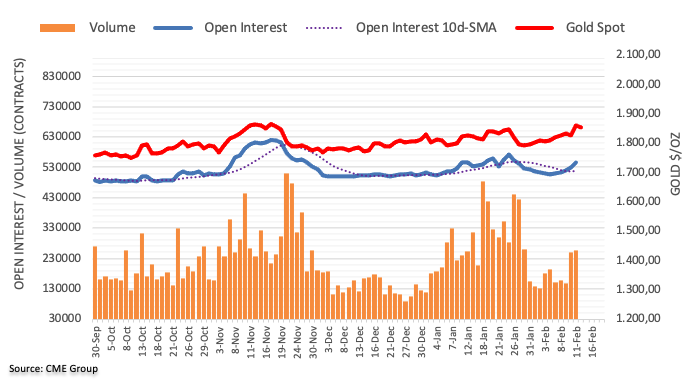
FX Strategists at UOB Group noted further downside in EUR/USD should meet decent support in the 1.1300 area in the near term.
Key Quotes
24-hour view: “The sharp drop in EUR during late NY hours to 1.1328 came as a surprise. While the rapid decline appears to be running ahead of itself, EUR could dip 1.1328 from here. That said, the major support at 1.1300 is unlikely to come into the picture. Resistance is at 1.1385 followed by 1.1410.”
Next 1-3 weeks: “Last Friday (11 Feb, spot at 1.1420), we highlighted that the recent upside risk has dissipated and we expected EUR to trade between 1.1340 and 1.1500. We did not anticipate the rapid manner by which EUR dropped below 1.1340 (low of 1.1328). Downward pressure has increased, albeit not by much. There is room for EUR to edge lower but any weakness is likely limited to a test of 1.1300. On the upside, a breach of the ‘strong resistance’ level, currently at 1.1440, would indicate that the downside risk has dissipated.”
- USD/JPY bounces to around 115.50 after defending 115.00.
- Russia-Ukraine geopolitical risks continue to remain a threat.
- Downside appears cushioned amid a bunch of healthy support levels.
USD/JPY is consolidating Friday’s sell-off around mid-115.00s, trying to find the conviction to extend the recovery momentum.
Even though the risk sentiment has somewhat recovered, worries over a potential Russia-Ukraine war persist, which keeps any renewed upside in the US Treasury yields limited. This, in turn, could stem USD/JPY’s rebound.
Bulls may also find comfort from an increasing case for rising global rates, as inflation soar worldwide. The January Fed meeting’s minutes are likely to ramp up expectations for aggressive tightening by the world’s most powerful central bank.
Meanwhile, the Bank of Japan (BOJ) successfully defended its key bond yield target on Monday, as attention turns towards the Japanese growth numbers due on Tuesday.
In the meantime, the speech from St. Louis President James Bullard will be closely eyed for fresh hints on the Fed’s rate hike plans.
USD/JPY: Technical outlook
USD/JPY’s daily chart shows that the price found buyers well above the bullish 21-Daily Moving Average (DMA) at 114.79.
Also, bulls remain hopeful as the spot managed to defend the 115.00 level, as the 14-day Relative Strength Index (RSI) continues to hold above the midline.
On the upside, daily closing above 116.00 is needed to retest Friday’s high of 116.17, above which the critical horizontal trendline resistance at 116.34 will come into play.
USD/JPY: Daily chart

USD/JPY: Additional levels to consider
- AUD/USD bears attack 100-SMA during three-day downtrend, sidelined of late.
- Clear downside break of fortnight-old rising trend line, bearish MACD favor sellers.
- Fresh monthly high becomes necessary for bulls to retake controls.
Having conquered a two-week-old rising trend line the previous day, AUD/USD holds lower ground near 0.7120 during the three-day declines heading into Monday’s European session.
In doing so, the Aussie pair seesaws around the 100-SMA. However, bearish MACD signals and the quote’s U-turn from 0.7250, portrayed on Friday, keep Aussie sellers hopeful.
Hence, a clear downside break of 0.7115 becomes necessary for AUD/USD bears to extend the latest declines towards the 0.7100 threshold.
Following that, the 23.6% Fibonacci retracement (Fibo.) of January’s declines, near 0.7050, will precede the 0.700 psychological magnet to test the AUD/USD bears, not to forget the yearly bottom surrounding 0.6965.
Alternatively, the support-turned-resistance line near 0.7155 and the 200-SMA level of 0.7170 restrict short-term upside moves of the AUD/USD pair.
It should be noted, however, that the AUD/USD bulls remain cautious until the quote refreshes monthly high, currently around 0.7250.
AUD/USD: Four-hour chart

Trend; Further weakness expected
- Gold prices consolidate the biggest daily gains in a month amid mixed clues.
- Easing bets on 0.50% Fed-rate-hike in March, Ukraine’s request for meeting with Russia trigger pullback moves.
- Light calendar, rebound in Yields add to the short-term bearish bias.
- Gold Price Forecast: XAU/USD corrects before resuming uptrend, focus on Russia-Ukraine crisis
Gold (XAU/USD) remains pressured around an intraday low of $1,851, paring the heaviest daily jump in a month heading into Monday’s European session.
The yellow metal rallied the previous day as market players rushed towards risk-safety on geopolitical fears emanating from Russia. Adding to the bullish bias were global inflation fears, as well as easing probabilities for a 0.50% rate hike by the Fed following softer US sentiment data.
It should, however, be noted that a sluggish start to the week joined Ukraine’s request to Russia for a meeting to tame the risk-off mood and trigger a pullback in the gold prices from a three-month high.
Even so, US Treasury yields and equities in Asia-Pacific trade mixed while stock futures in the US and Europe print mild gains by the press time.
That said, gold traders await clear updates from Russia, as well as comments from St. Louis Fed President James Bullard, for intraday direction. However, major importance will be given to Wednesday’s Federal Open Market Committee (FOMC) Meeting Minutes.
Technical analysis
Although nearly overbought RSI conditions triggered gold’s recent pullback, the metal sellers will undoubtedly wait for a clear downside break of the previous resistance line, near $1,850 to convince markets.
Also acting as a downside filter is a five-week-old horizontal support zone near $1,830 and the key SMAs surrounding $1,818-17.
Although bullish MACD signals keep gold buyers hopeful, a clear downside break of $1,817 won’t hesitate to welcome sellers targeting the previous month’s low near $1,780.
Meanwhile, an upward sloping trend line from early January, near $1,873 guards the immediate advances of the metal, a break of which will direct hold buyers towards the $1,900 round figure.
In a case where gold buyers manage to keep reins past $1,900, tops marked during June and January 2021, respectively near $1,917 and $1,960 will be in focus.
Overall, gold consolidates recent gains but is not out of the woods.
Gold: Four-hour chart
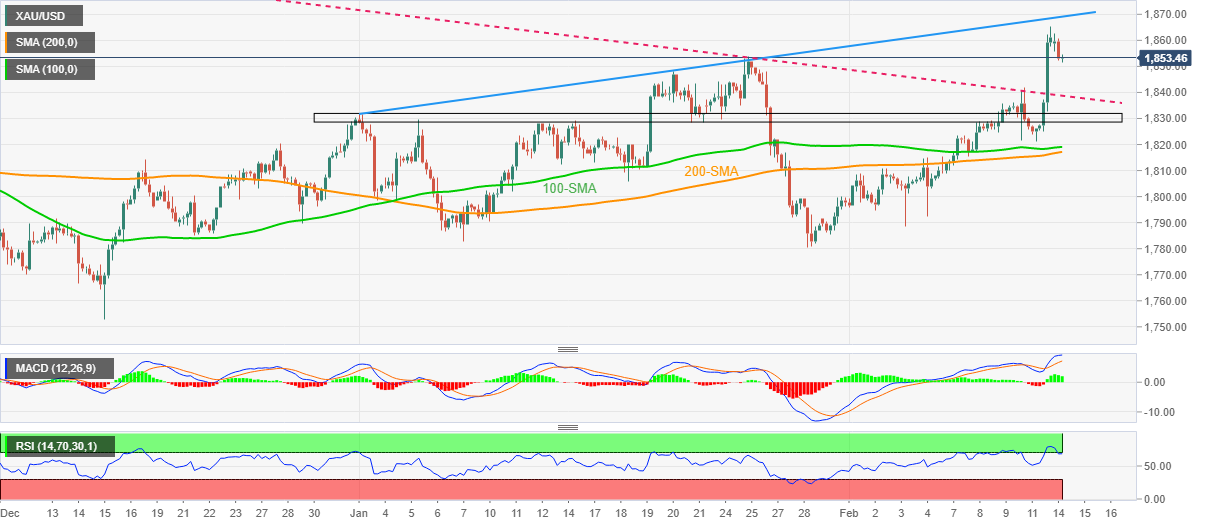
Trend: Pullback expected
Despite rising pressure for gold rate hikes, the Bank of Japan (BOJ) successfully defended its key bond yield target on Monday, maintaining its pledge for ultra-loose monetary policy.
Key takeaways
“The 10-year JGB yield fell two basis points to 0.205% in early trade, after rising to 0.230% last week.“
“The BOJ said it made no purchases of the debt, as there were no offers for sale.”
- EUR/USD treads water, mostly pressured after declining the most in two weeks the previous day.
- ECB policymakers keep taming rate-hike concerns, Fed’s 0.50% lift in March also tested.
- Risk appetite improves after Ukraine requests a meeting with Russia.
- Fed’s Bullard, ECB’s Lagarde will entertain traders, FOMC Minutes becomes the week’s key event.
EUR/USD bears take a breather around 1.1350 heading into Monday’s European session, after positing the heaviest daily fall in two weeks the previous day.
The major currency pair’s recent performance could be linked to the recent market optimism, as well as downbeat comments from the ECB policymakers, amid the sluggish Asian session.
The latest news suggesting Ukraine’s request to Russia for a meeting in the next 48 hours placates market fears of imminent war and tames the US dollar’s safe-haven demand. However, the latest comments from European Central Bank’s (ECB) Governing Council Member Olli Rehn and Gabriel Makhlouf kept pushing back the pair buyers ahead of today’s speech from ECB President Christine Lagarde.
While Irish central bank leader Makhlouf rejected June rate-hike concerns, ECB’s Rehn said, “Overreaction to inflation by the central bank could stem the economic growth,” which in turn tames the rate-hike concerns.
It’s worth noting that the US dollar index rallied on Friday despite downbeat Treasury yields after US President Joe Biden joined political leaders from the UK and EU to highlight risks of immediate Russia-Ukraine war. However, easing chatters over Fed’s 0.50% rate hike in March tamed the EUR/USD losses.
The CME FedWatch Tool suggests nearly 50-50 chances of the 50 basis points (bps) of Fed-rate-hike in March versus a 0.25% move. Previously, especially after the US Consumer Price Index (CPI) release, the market was almost certain of a higher boost to the rates. That said, the preliminary readings of the US Michigan Consumer Sentiment for February eased from 67.2 to 61.7 on Friday.
Against this backdrop, the US 10-year Treasury yields lick their wounds around 1.95%, after shedding over 11 basis points (bps) the previous day. Further, the S&P 500 Futures print mild gains by the press time.
Looking forward, comments from the ECB President Christine Lagarde and St. Louis Fed President James Bullard may offer intraday direction, not to forget geopolitical catalysts. the Federal Open Market Committee (FOMC) Meeting Minutes, up for publishing on Wednesday, will be crucial to watch.
Technical analysis
EUR/USD dropped the most in two weeks the previous day while extending Thursday’s pullback from 1.1485-90 horizontal area established since November 11, 2021.
However, a joint of the 21-DMA and 50-DMA restricts the immediate downside of the stated currency pair to around 1.1330.
- GBP/USD grinds lower as yields rebound on cautious optimism, Brexit fears stay on the table.
- Truss probed over NI deadlock, hints of easing stand in Brexit.
- UK police contacted PM Johnson over ‘Partygate’ issues, Britain observing hybrid Delta-Omicron strain.
- Ukraine requests Russia for talks, eases geopolitical pressures and favors yields ahead of UK jobs, CPI and Retail Sales data.
GBP/USD licks its wounds around 1.3540 during the early Monday morning in Europe.
In doing so, the cable pair drops the most in a week while bearing the double attack from Brexit and firmer USD ahead of the key data/events from the UK that will highlight Bank of England (BOE) rate hike concerns amid hawkish chatters of late.
UK Foreign Secretary Lizz Truss has been told she can "kiss goodbye" to her leadership hopes if she fails to stand up to the EU, per UK Express. The news also joins the looming concerns over the Northern Ireland (NI) border checks to weigh on GBP/USD prices amid no major progress in the talks.
Elsewhere, UK PM Boris Johnson was recently contacted by the UK police for his lockdown parties, which in turn could add to the political fears and weigh on GBP/USD prices.
Also weighing on the cable prices is the virus update from Fox News stating, “Health officials in the United Kingdom officially began monitoring a hybrid strain of the delta and omicron coronavirus known as "Deltacron" last week after it was identified in a patient in the country, according to the country's Health Security Agency.”
On the other hand, the US Dollar Index (DXY) tracks firmer US Treasury yields to refresh one-week high despite easing fears of the Russia-Ukraine war after Kyiv requested Moscow for a meeting in 48 hours.
Amid these plays, the US 10-year Treasury yields lick their wounds around 1.95%, after shedding over 11 basis points (bps) the previous day. Further, the S&P 500 Futures print mild gains by the press time.
It’s worth noting that Friday’s easing of the Fed’s rate-hike concerns and downbeat yields challenged GBP/USD pair traders the previous day. The CME FedWatch Tool suggests around 50-50 chances of 50 basis points (bps) of a Fed-rate-hike in March versus a 0.25% move. Previously, especially after the US Consumer Price Index (CPI) release, the market was almost certain of a higher boost to the rates. That said, the preliminary readings of the US Michigan Consumer Sentiment for February eased from 67.2 to 61.7 on Friday.
On the other hand, Reuters’ poll suggests another rate hike by the Bank of England (BOE), in March.
Moving on, top-tier UK data will decide how necessary it is for the “Old Lady” to stay hawkish, which in turn may help GBP/USD to recover some of the latest losses. Also important will be Brexit and geopolitical talks.
Also read: GBP/USD Weekly Forecast: ‘Buy the dip’? UK inflation, Fed minutes take center stage
Technical analysis
Unless providing a daily closing beyond the 200-DMA level surrounding 1.3700, GBP/USD bears keep attacking the 50-DMA support near 1.3500 with eyes on January’s low near 1.3355.
Asian shares have been under pressure at the start of the week in a jittery start in financial markets over concerns about escalating tensions surrounding Ukraine and rising global inflation headwinds. The mood was seen
The Nikkei share average posted its biggest intraday percentage drop since Jan. 27 and falling below the 27,000 level for the first time since Jan. 31. The broader Topix (TOPIX) was lower by 2.02% to 1,923.07. The moves have echoed the sentiment felt in the US on Friday over the dramatic escalation with regards to the prospects of a Russian invasion and massive military build-up near the Ukraine border.
Wall Street ended sharply lower on Friday for the second straight session. The S&P 500 was down 1.9% Friday to 4,418.64 and dropped 1.8% for the week. The Nasdaq Composite lost 2.8% to 13,791.15 and slid 2.2% for the week. The Dow Jones Industrial Average retreated 1.4% to 34,738.06, ending the week 1% lower.
US president Joe Biden and Russian president Vladimir Putin spoke on the weekend as the tensions grow to a crescendo and the call has been regarded as a last-ditch effort to fend off a Russian invasion of Ukraine. However, there was no solace found here given that there was “no fundamental change” to the worsening crisis according to a senior US official, briefing reporters. The official said told reporters that the US and Russia have agreed to stay engaged in the coming days “but Russia may decide to proceed with military action anyway.”
- USD/INR snaps four-day uptrend inside six-week-old bullish channel.
- Firmer MACD signals, sustained trading beyond the key SMAs keep buyers hopeful.
- 200-DMA becomes the key support, 75.80 guards immediate upside.
USD/INR pulls back from yearly high while snapping a four-day uptrend around 75.55 during Monday’s Asian session.
In doing so, the Indian rupee (INR) pair steps back from the resistance line of an upward sloping trend channel from early January.
However, bullish MACD signals and the quote’s successful trading above the 50-DMA and 200-DMA, respectively around 74.90 and 74.30 by the press time, keep USD/INR bulls hopeful.
That said, the pair’s weakness past 74.30 will need validation from the 74.00 threshold before directing the USD/INR bears towards the previous month’s low near 73.70.
Meanwhile, the pair’s further upside needs to defy the stated channel with an upside break of 75.75.
Following that, the 76.00 round figure and December 2021 peak near 76.60 gains the market’s attention.
Overall, USD/INR prices remain in the upward trajectory but a pullback can’t be ruled out.
USD/INR: Daily chart
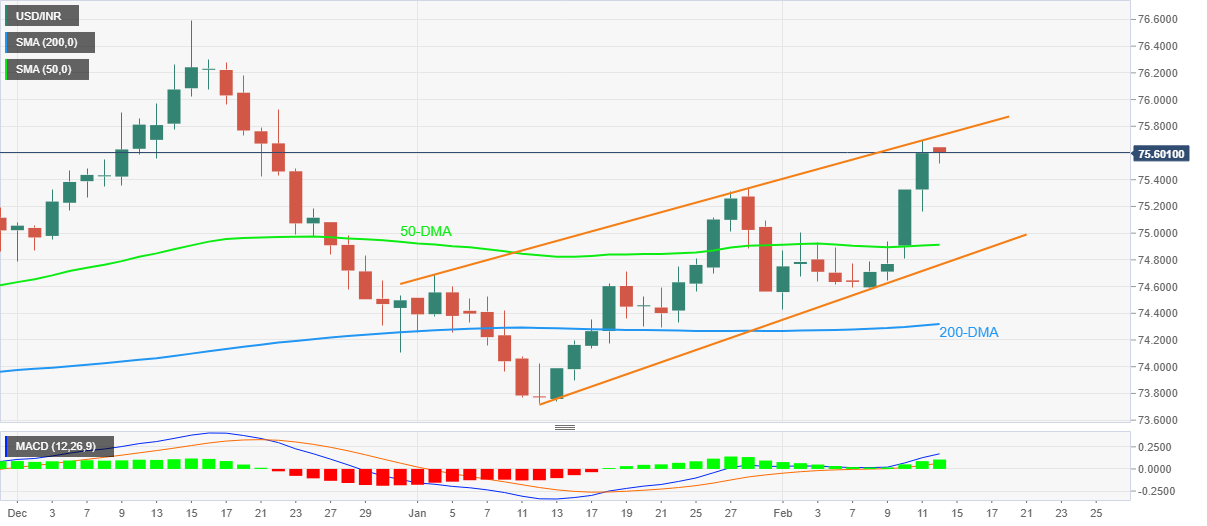
Trend: Bullish
- USD/IDR extends Friday’s losses on firmer Indonesia Retail Sales for December.
- Easing tensions over Russia-Ukraine favor US stock futures, Asia-Pacific remain downbeat.
- Yields struggle amid mixed concerns over Fed’s March rate-hike.
USD/IDR remains on the back foot around $14,335, down 0.08% intraday, as Indonesia reports strong Retail Sales figures for December during early Monday. Adding to the bearish bias could be a ray of hope concerning the Russia-Ukraine issue.
That said, Indonesia's Retail Sales for December rose past 10.8% to 13.8% YoY in December, per the Bank Indonesia (BI) Survey.
The BI left monetary policy unchanged in the last week and the recently firmer economics from Indonesia help the rupiah (IDR) pair to attack the 200-DMA. Adding to the bearish bias is the latest news suggesting Ukraine’s request to Russia for a meeting in the next 48 hours, which in turn placates market fears of imminent war and tames the US dollar’s safe-haven demand.
Additionally, the CME FedWatch Tool suggests nearly 50-50 chances of the 50 basis points (bps) of Fed-rate-hike in March versus a 0.25% move. Previously, especially after the US Consumer Price Index (CPI) release, the market was almost certain of a higher boost to the rates. That said, the preliminary readings of the US Michigan Consumer Sentiment for February eased from 67.2 to 61.7 on Friday.
Amid these plays, the US 10-year Treasury yields lick their wounds around 1.95%, after shedding over 11 basis points (bps) the previous day. Further, the S&P 500 Futures print mild gains by the press time. However, stocks in the Asia-Pacific zone remain bearish at the latest.
Moving on, risk catalysts are likely to entertain USD/IDR traders ahead of Wednesday’s Federal Open Market Committee (FOMC) Meeting Minutes.
Technical analysis
USD/IDR sellers attack the 200-DMA level surrounding $14,330 with eyes on the $14,300 threshold. It’s worth noting that the pair sellers keep reins until witnessing a clear upside break of $14,450.
- GBP/JPY's hour correction loses momentum.
- GBP/JPY bears eye hourly structure for a break of current lows.
GBP/JPY has corrected a significant portion of the Russian related risk-off bearish hourly impulse that occurred on Friday. The focus turns back to the downside given the loss of momentum in the correction. The following illustrates the bearish perspective and structures on both the hourly and 15-min charts.
GBP/JPY H1 chart

The hourly chart shows that the price is retesting the counter trendline where bears would anticipate supply guarding a break back into the rising trend. The prior lows of 156.70 held as resistance and the price has since fallen sharply into the current lows near 156.25.
GBP/JPY 15-chart

From a lower time frame perspective, the 15-min chart's structure has resistance at 156.50 and support at 156.20, a break of which would solidify the bearish bias.
- Silver retreats after refreshing 13-day high, keeps bounce off 100-DMA.
- Bullish MACD signals also underpin run-up towards 200-DMA.
- Seven-month-old resistance line acts as the key hurdle.
Silver (XAG/USD) pares intraday gains around $23.65, up 0.10% on a day during the mid-Asian session on Monday.
The bright metal refreshed multi-day low during the early Asian session before easing from $23.78.
The pullback moves, however, remain above the 100-DMA amid bullish MACD signals, which in turn keeps the buyers hopeful until the quote drops below the stated SMA support, around $23.20 by the press time.
Also acting as downside filters are 23.6% Fibonacci retracement (Fibo.) of July-September declines and a five-week-long horizontal support zone, respectively around $22.70 and $22.00.
Alternatively, XAG/USD upside eyes $24.00 threshold as the immediate resistance ahead of confronting the 50% Fibo. near $24.10.
It should be noted, though, that the quote’s upside past $24.10 will be challenged by the 200-DMA and a descending trend line from July, near $24.35 and $24.45 in that order.
Overall, silver prices are likely to advance further but the upside is seen as limited.
Silver: Daily chart
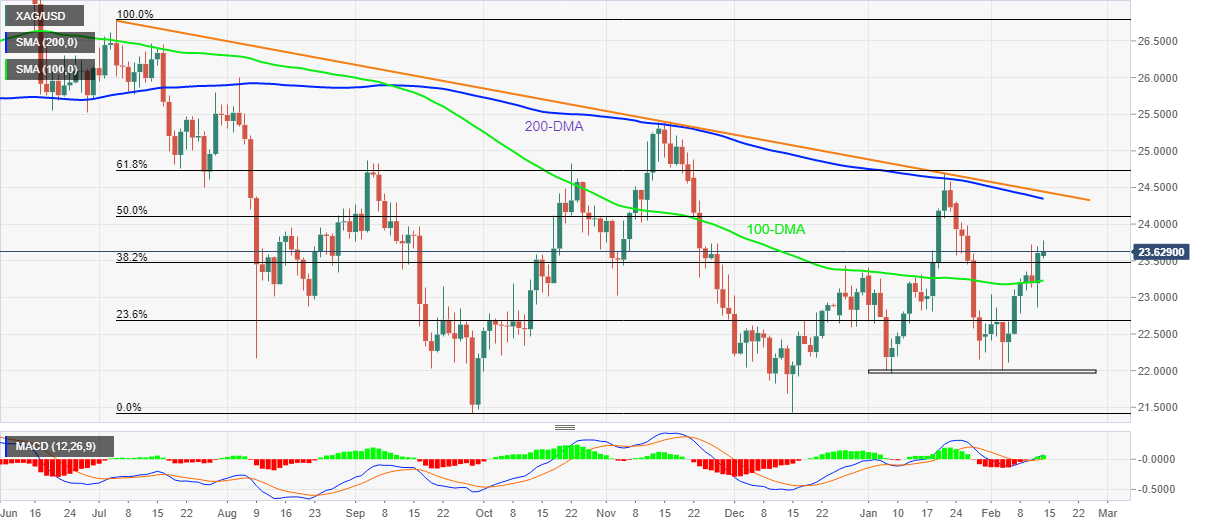
Trend: Further upside expected
European Central Bank’s (ECB) Governing Council Member Olli Rehn warned in an interview on Finland’s YLE TV1 on Saturday, overreaction to inflation by the central bank could stem the economic growth.
Key quotes
“If we reacted strongly to inflation in the short term, we would probably cause economic growth to stop,”
“It’s better to look beyond short-term inflation and look at what inflation is in 2023, 2024.”
“We will have time to react in the March meeting and in later meetings if it looks like the situation is markedly different than it now appears.”
Separately, speaking at an event in Parma on Saturday, ECB policymaker Ignazio Visco, “the monetary policy stance remains expansionary, though the gradual normalization will continue at a pace consistent with the economic recovery and changes in the outlook for prices.”
Read: EUR/USD bears are moving in with a focus on 1.1305, Russia invasion risk weighing
| Raw materials | Closed | Change, % |
|---|---|---|
| Brent | 94.87 | 4.07 |
| Silver | 23.608 | 1.79 |
| Gold | 1860.92 | 1.84 |
| Palladium | 2307.55 | 2.41 |
- EUR/USD bears are moving in from the hourly the 38.2% ratio.
- 1.1305 serves as potential support below current lows.
- Russia and central bank sentiments are the driving forces.
EUR/USD is bleeding the initial gains for the day as risk appetite drifts off with the major Asian indexes printing in the red. EUSCI's broadest index of Asia-Pacific shares outside Japan dropped 0.2%, while Japan's Nikkei lost 2.5%. At 1.1353, the euro is now flat on the day to the US dollar after correcting a significant portion of Friday's sell-off to a high in the 1.1369's.
The start of the week is jittery following alarmingly high US inflation readings last week combined with risks of a Russian invasion of Ukraine. US president Joe Biden and Russian president Vladimir Putin talked by phone for an hour on Saturday in what is widely seen as a last-ditch effort to fend off a Russian invasion of Ukraine. The call, however, brought “no fundamental change” to the worsening crisis although the US and Russia have agreed to stay engaged in the coming days according to a senior US official, briefing reporters. The official also told reporters that ''Russia may decide to proceed with military action anyway.''
Meanwhile, there is speculation that the Federal Reserve might raise rates by a full 50 basis points in March with chatter about an emergency inter-meeting hike. That was spurred in part by the timing of a closed Fed Board meeting for Monday, though the event has been presumed routine.
However, not all Fed members are singing from the same hymn sheet. While hawk and St. Louis Fed James Bullard advocated for a 50bps hike at the March meeting, San Francisco Fed President Mary Daly played down the need for a half-point move in an interview on Sunday. Daly argued that being too "abrupt and aggressive" on policy could be counter-productive. Fed President James Bullard will be in focus later on Monday, given his recent calls for a more aggressive stance at the Fed, signifying 100 basis points of tightening by June.
US FOMC minutes / Retail Sales in focus
As for other events in the week, the Federal Open Market Committee meeting minutes will be released and traders will be on the lookout for discussions regarding near-term policy plans. Analysts at TD Securities explained that the market will be paying particular attention to plans for balance sheet normalization steps, following the release of the normalization "principles" in Jan.
''The minutes might seem stale, however, given the recent strength in macro data,'' the analysts added. Markets will then look to US Retail Sales where an improvement on December's sharp decline could be supportive to the US dollar.
EUR/USD technical analysis
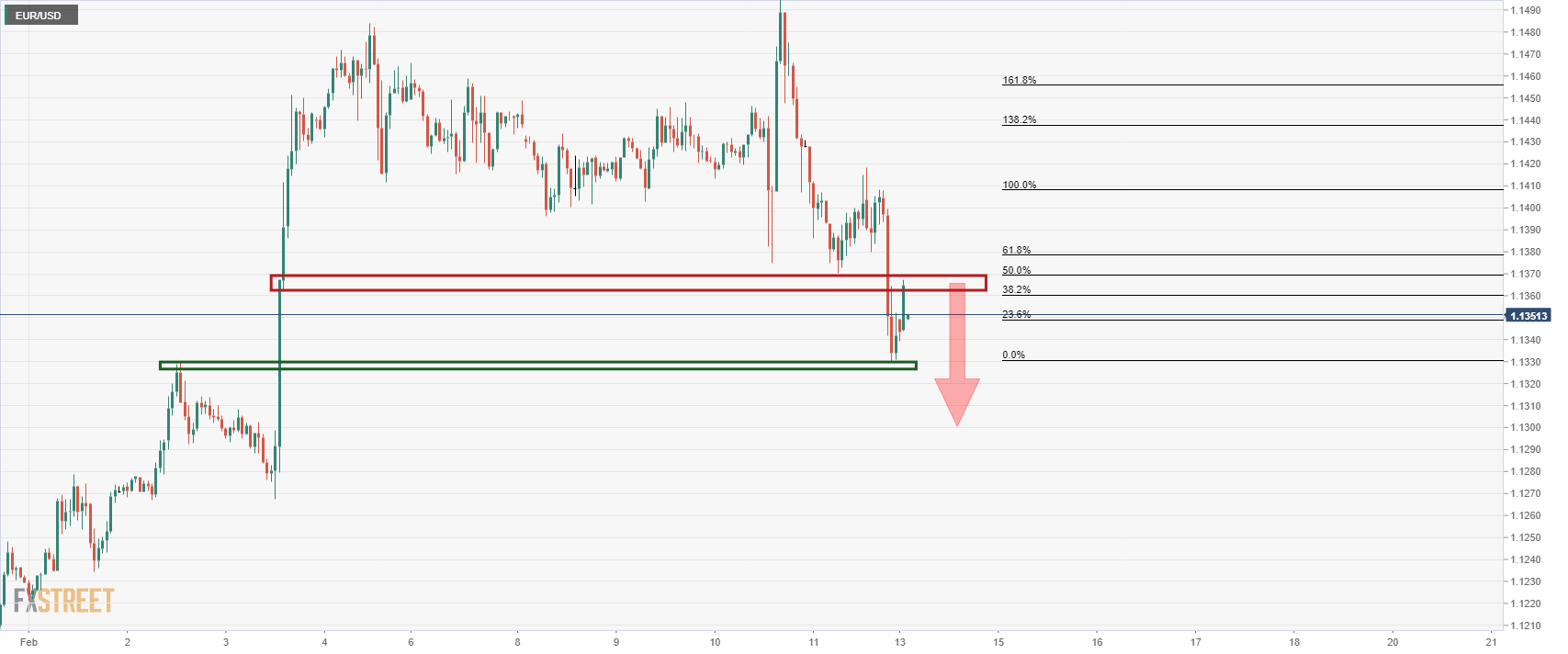
As illustrated, the euro is on the back foot again, capped through the 38.2% ratio, so far, which leaves the emphasis on the downside and prospects of a bearish extension of the broader trend. 1.1305 serves as potential support below current lows.
Markets are pretty quiet starting out a fresh week on Monday, having witnessed volatile trades late Friday after the US was reportedly seen signaling a Russian invasion into Ukraine beginning this week.
The risk sentiment is somewhat in Asia but traders remain cautious, watching over the geopolitical developments, concerning Russia and Ukraine. It’s a potentially decisive week for the markets.
Earlier on, the US said the standoff with Moscow over Ukraine can still be resolved diplomatically.
Meanwhile, Ukraine has called for a meeting with Russia and other members of a key European security group, requesting a meeting within the next 48 hours for "transparency" about Russia's plans, BBC News reported.
On the other side, a tweet from the Russian Embassy for the UK cited, “FM #Lavrov: After Russian troops finish drills and return to barracks, West will declare 'diplomatic victory' by having 'secured' Russian 'de-escalation'. Predictable scenario and cheap domestic political points.”
This tweet was seen as “a ray of hope" by a senior UK government security source.
“The UK Boris Johnson has urged his Russian counterpart Vladimir Putin to “step back from the brink” as he insisted there was still a “window of opportunity” to avoid war in Ukraine,” per The Telegraph.
The Prime Minister is expected to speak to world leaders from Monday and travel to countries in Europe later this week, as he seeks to unite Western allies against the threat of Russian invasion.
This comes after Downing Street reported Sunday, “the UK believes Moscow could invade Ukraine at any moment.”
Market implications
Despite a glimmer of hope for diplomacy and de-escalation, the high-beta currencies such as AUD/USD is trading on thin ice, pressurizing lows near 0.7125, as of writing. The aussie is down 0.13% so far.
The S&P 500 futures are losing 0.08% on the day while gold price is consolidating Friday’s massive surge near $1,860, as bulls take a breather before the next push higher.
Related reads
- US pursues ‘diplomacy and deterrence’ in Ukraine / Russian crisis
- The call between Biden and Putin has ended, markets on high alert with finger over the panic button
- NZD/USD drops to one-week low during three-day downtrend.
- Clear break of two-week-old support line, U-turn from key SMAs keep sellers hopeful.
- 200-SMA, February’s top adds to the upside filters.
NZD/USD extends the previous two-day downtrend towards 0.6600 during Monday’s Asian session.
That said, the Kiwi pair takes offers to refresh one-week low around 0.6625, down 0.25% intraday, by the press time.
The quote broke an ascending trend line from January 28 the previous day while extending the February 10 pullback from 200-SMA.
The corrective pullback portrayed during the early Asian session failed to cross the 100-SMA level, needless to mention the support-turned-resistance and 200-SMA, which in turn joins bearish MACD signals to keep NZD/USD sellers hopeful.
During the pair’s further weakness the 0.6600 threshold may act as short-term support before the monthly low of 0.6589.
In a case where NZD/USD bears keep reins past 0.6589, January’s bottom surrounding 0.6530 will be in focus.
Alternatively, the 100-SMA and previous support line, respectively around 0.6645 and 0.6660, will restrict the short-term recovery moves of the pair.
Following that, the 200-SMA and the monthly high, near 0.6720 and 0.6735 in that order, will be crucial to watch for NZD/USD bulls.
NZD/USD: Four-hour chart
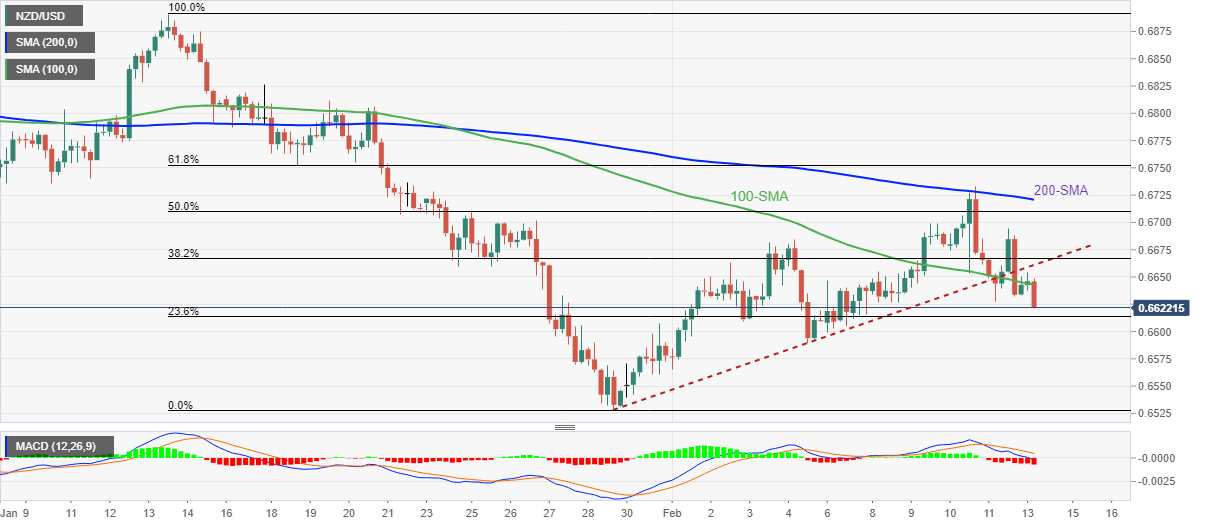
Trend: Further weakness expected
- US Treasury yields struggle for clear direction after declining the most in 10 weeks.
- Softer yields, absence of major negative from Russia allow equities to pare the recent losses.
- FOMC Minutes, Russia-Ukraine story become the key catalysts for the week.
After a volatile Friday, global markets remain sluggish during the early hours of Monday’s Asian trading session. While an absence of major data/events can be cited as the main reason for the latest inactive market performance, mixed updates concerning Russia’s invasion of Ukraine and the Fed’s rate-hike also challenge the momentum traders.
To portray the mood, the US 10-year Treasury yields lick their wounds around 1.95%, after shedding over 11 basis points (bps) the previous day. Further, the S&P 500 Futures print mild gains by the press time.
Market sentiment soured on Friday after US President Joe Biden raised concerns about an imminent military attack by Russia over Ukraine. Not only US President Biden but the UK and Eurozone leaders also flashed worrisome signals for the much-debated geopolitical event.
The risk-off mood weighed on the US Treasury yields and equities while helping the US Dollar Index (DXY) and gold prices.
Also contributing to the yields’ weakness were the concerns over the Fed’s rate hike in March. The CME FedWatch Tool suggests around 50-50 chances of 50 basis points (bps) of a Fed-rate-hike in March versus a 0.25% move. Previously, especially after the US Consumer Price Index (CPI) release, the market was almost certain of a higher boost to the rates. That said, the preliminary readings of the US Michigan Consumer Sentiment for February eased from 67.2 to 61.7 on Friday.
It’s worth noting, however, that Russian President Vladimir Putin termed any such claims as ‘provocative speculation’, per AFP News. However, market players seemed to not believe in Putin’s comments as Bloomberg said, “Standoff with Russia over Ukraine heads into most tense week yet.”
Looking forward, a light calendar and cautious mood may restrict market moves during the early days of the week. However, the Federal Open Market Committee (FOMC) Meeting Minutes, up for publishing on Wednesday, will be crucial to watch for near-term direction. Also important will be Russia-Ukraine headlines.
Read: Week Ahead on Wall Street (SPY) (QQQ): CPI sets equities up for more losses and 50bps hike
- DXY grinds higher past key moving averages, stays below three-week-old resistance area.
- Firmer RSI keeps buyers hopeful to overcome immediate hurdle, monthly support line adds to the downside filters.
US Dollar Index (DXY) bulls flirt with the 96.00 threshold during an inactive Asian session on Monday.
The greenback gauge rose during the last two days to poke the highest levels since February 03 the previous day.
The upside momentum also gains support from the sustained break of 200-SMA and 100-SMA.
Given the firmer RSI adding to the bullish bias, the DXY is up for challenging a horizontal area established since January 25, near 96.30.
Following that, the upward trajectory will aim for the 97.00 threshold before January’s top of 97.44.
Meanwhile, pullback moves may initially battle the 100-SMA level of 96.00 before testing the 200-SMA level surrounding 95.85.
Even if the quote drops below 95.85 support, an upward sloping trend line from January 14, near 95.35 at the latest, will challenge the US Dollar Index bears.
DXY: Four-hour chart
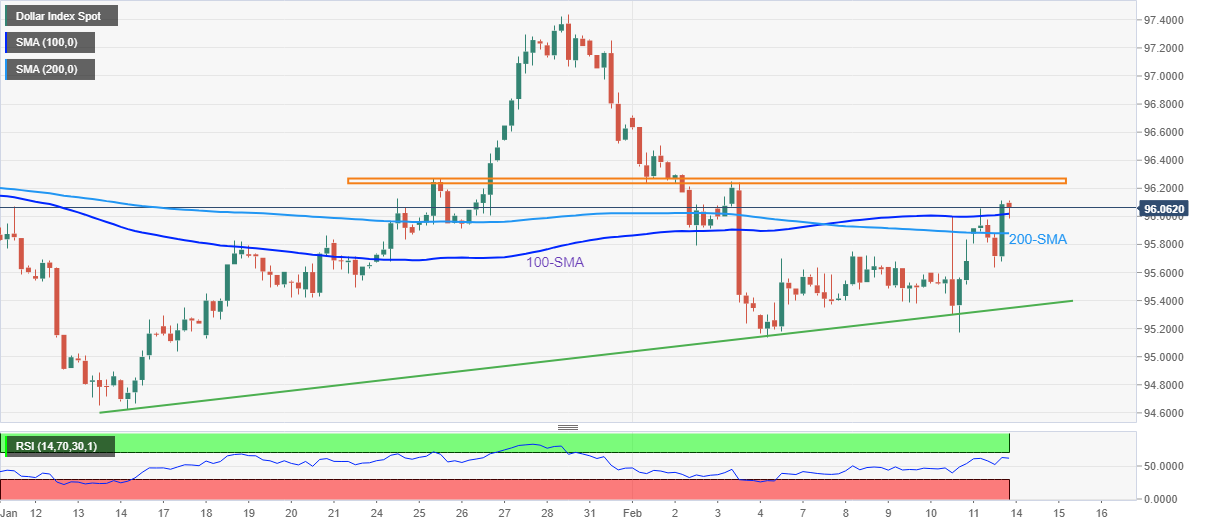
Trend: Further upside expected
| Time | Country | Event | Period | Previous value | Forecast |
|---|---|---|---|---|---|
| 07:30 (GMT) | Switzerland | Producer & Import Prices, y/y | January | 5.1% | |
| 16:15 (GMT) | Eurozone | ECB President Lagarde Speaks | |||
| 21:45 (GMT) | New Zealand | Visitor Arrivals | December | 3.8% | |
| 23:50 (GMT) | Japan | GDP, q/q | Quarter IV | -0.9% | 1.4% |
| 23:50 (GMT) | Japan | GDP, y/y | Quarter IV | -3.6% | 5.8% |
In recent trade today, the People’s Bank of China (PBOC) set the yuan (CNY) at 6.3664 vs. the last close of 6.3542.
About the fix
China maintains strict control of the yuan’s rate on the mainland.
The onshore yuan (CNY) differs from the offshore one (CNH) in trading restrictions, this last one is not as tightly controlled.
Each morning, the People’s Bank of China (PBOC) sets a so-called daily midpoint fix, based on the yuan’s previous day closing level and quotations taken from the inter-bank dealer.
“The Bank of England (BOE) will raise interest rates faster than previously thought to tame surging inflation,” per the latest survey of economists by Reuters. The surveyed also “significantly upgraded their forecasts for consumer price rises,” said the poll.
Key findings
Nearly two-thirds of respondents in the Feb. 7-11 poll, or 25 of 40, expected a 25 basis points increase in Bank Rate to 0.75% at the conclusion of the next MPC meeting on March 17. That would mark the first time the Bank has raised rates at three meetings in a row since 1997.
A slim majority, 21 of 41, forecast a further increase to 1.00% next quarter. That is well behind financial markets, which are pricing in the bank to make a cumulative 75 basis points of increases at its March and May meetings.
In a poll taken last month, only one further increase was expected this year - in the third quarter - showing how quickly rate expectations are changing.
More than 80% of respondents to an extra question, 15 of 18, said it was more likely the BoE increases rates more than they expect rather than less.
Amidst calls from BoE officials for wage restraint 85% of respondents, 17 of 20, did not see pay rises keeping up with inflation over the next 12 months.
Also read: GBP/USD bulls take the lead at the start of the week
- USD/JPY licks its wounds after declining the most in a month the previous day.
- US Treasury yields struggle for clear direction, stock futures print mild gains.
- Chatters over Russian invasion of Ukraine, Fed’s rate-hike gain major attention amid light calendar.
- FOMC Minutes, Japan’s Q4 Preliminary GDP will be key data/events to watch for fresh impulse.
USD/JPY remains on the back foot around 115.40 during an initial hour of Tokyo open on Monday.
The yen pair dropped the most since mid-January on Friday as yields plunged on easing Fed-rate-hike concerns and rising fears over the Russian invasion of Ukraine. That said, the latest moves could be linked to the market’s inaction and a light calendar ahead of the key releases.
On Friday, US President Joe Biden raised concerns about an imminent military attack by Russia over Ukraine. Not only US President Biden but the UK and Eurozone leaders also flashed worrisome signals for the much-debated geopolitical event.
It’s worth noting, however, that Russian President Vladimir Putin termed any such claims as ‘provocative speculation’, per AFP News. However, market players seemed to not believe in Putin’s comments as Bloomberg said, “Standoff with Russia over Ukraine heads into most tense week yet.”
Elsewhere, Japan’s covid woes seem to ease with the latest 7-day backward moving average of infections being around 204,368 versus the all-time high of 228,847 flashed on February 03. This adds to Japan’s ability to ease entry barriers for non-residents. “Japan is considering easing the entry ban on nonresident foreigners to prevent the spread of the Omicron variant of the coronavirus in March, amid growing criticism from academic and business circles, a source familiar with the matter said Saturday,” per Kyodo News.
Furthermore, the CME FedWatch Tool suggests around 50-50 chances of 50 basis points (bps) of a Fed-rate-hike in March versus a 0.25% move. Previously, especially after the US Consumer Price Index (CPI) release, the market was almost certain of a higher boost to the rates. That said, the preliminary readings of the US Michigan Consumer Sentiment for February eased from 67.2 to 61.7 on Friday.
Additionally, news that the Bank of Japan (BOJ) opens Japanese Government Bond (JGB) buying window, to buy unlimited 10-yr bonds at 0.25% also favor USD/JPY prices to remain mildly bid around 115.50.
Amid these plays, the US 10-year Treasury yields lick their wounds around 1.95%, after shedding over 11 basis points (bps) the previous day. Further, the S&P 500 Futures print mild gains by the press time.
Looking forward, headlines concerning Russia and inflation may entertain USD/JPY traders with a light calendar on Monday. However, Tuesday’s Preliminary Q4 GDP and Wednesday’s FOMC Minutes will be important for the pair traders to watch for clear direction.
Technical analysis
Although double tops around 116.35 restrict the short-term upside of USD/JPY prices, the pair bears remain cautious until witnessing a clear downside break of the three-week-old support line, near 114.95 by the press time.
The United States says the standoff with Moscow over Ukraine can still be resolved diplomatically and risk appetite is recovering at the start of the week enabling pairs, such as AUD/USD, to correct from Friday's bearish closing prices.
However, while the US was prepared to engage in diplomacy, “we are equally prepared for other scenarios”, US president Joe Biden said. Should there be a Russian invasion of Ukraine, it risks the largest military operation on land in Europe since 1945.
In this regard, both Biden and Russian president Vladimir Putin talked by phone for an hour on Saturday in what is widely seen as a last-ditch effort to fend off a Russian invasion of Ukraine. The call, however, brought “no fundamental change” to the worsening crisis according to a senior US official, briefing reporters. The official said told reporters that the US and Russia have agreed to stay engaged in the coming days “but Russia may decide to proceed with military action anyway.”
President Biden also spoke with his Ukrainian counterpart Volodymyr Zelenskyy, with the pair agreeing on the need to pursue “diplomacy and deterrence,” the White House said. A readout of the call states that “the two leaders agreed on the importance of continuing to pursue diplomacy and deterrence in response to Russia’s military build-up on Ukraine’s borders.”
Meanwhile, AUD/USD, a pair that trades as a proxy to equity markets, is attempting to correct on the hourly chart, buoyed by prospects of diplomacy, retesting the W-formation's neckline as follows:
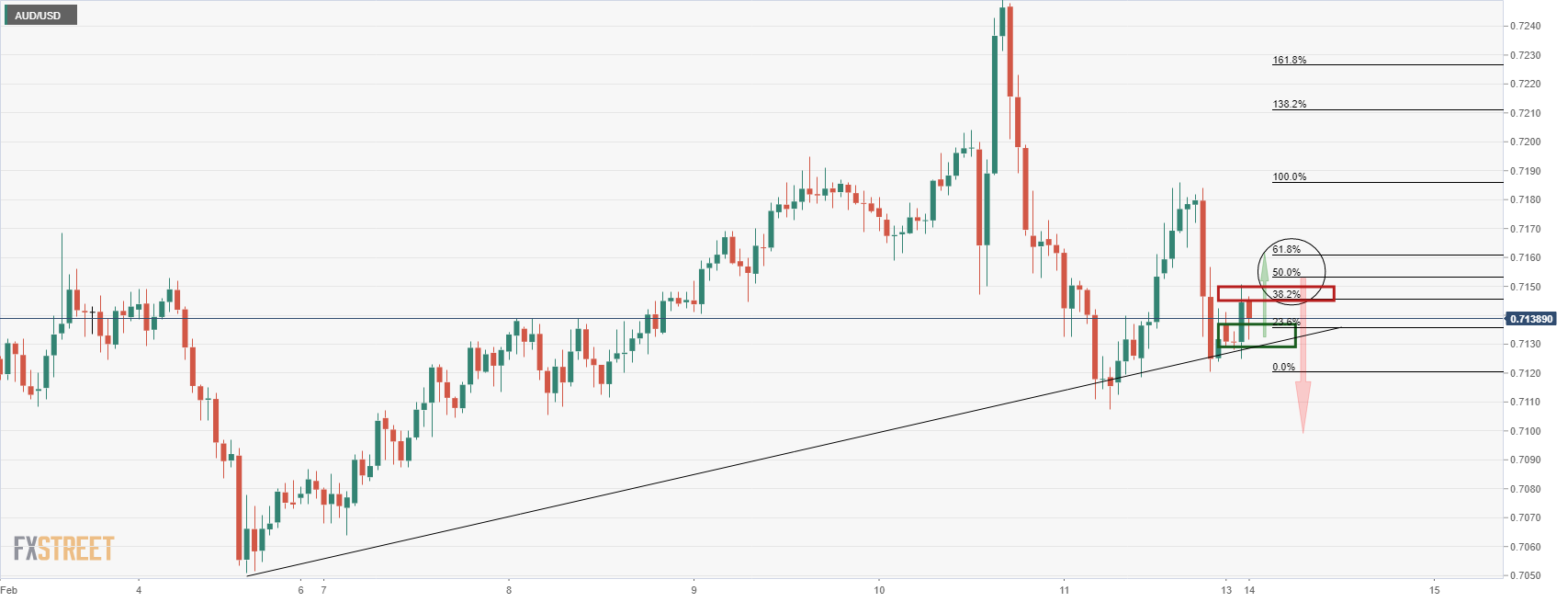
However, the situation over Russia is fluid and markets will be on a knife's edge in anticipation of meetings between leaders of all nations involved. Meanwhile, Ukraine has been reported to have requested a meeting within the next 48 hours with Russia and other members of a key European security group.
- AUD/USD pares the first daily gain in three, retreats from intraday high.
- Market sentiment dwindles as yields remain pressured, stock futures print mild gains.
- Putin terms claims of imminent Ukraine invasion as ‘provocative speculation’, bearish bets again Aussie rose to the highest since November.
- CME FedWatch hints at receding probabilities for 0.50% rate-hike in March, Aussie jobs report will be key.
AUD/USD eases from the intraday top towards 0.7100 by portraying the tensed markets during Monday’s Asian session. Even so, the Aussie pair snaps a two-day downtrend by flashing mild gains around 0.7130-35 by the press time.
That said, the risk barometer pair’s early Asian gains could be linked to the consolidation of previous losses amid mildly bid US stock futures. However, escalating fears over Russia’s invasion of Ukraine and bearish signals from the latest data from the Commodity Futures Trading Commission (CFTC) seem to weigh on the AUD/USD prices of late.
“A dovish Reserve Bank of Australia is driving hedge funds to ramp up bets against the nation’s currency as the policy stance increasingly diverges from a hawkish Federal Reserve,” said Bloomberg. The news adds, “Leveraged funds have boosted net Australian dollar shorts to the most since November.”
Comments from US President Joe Biden raised concerns of an imminent military attack by Russia over Ukraine. Not only the US but the UK and Eurozone leaders also flashed worrisome signals for the much-debated geopolitical event.
It’s worth noting, however, that Russian President Vladimir Putin termed any such claims as ‘provocative speculation’, per AFP News. However, market players seemed to not believe in Putin’s comments as Bloomberg said, “Standoff with Russia over Ukraine heads into most tense week yet.”
Amid these plays, the US 10-year Treasury yields lick their wounds around 1.95%, after shedding over 11 basis points (bps) the previous day. Further, the S&P 500 Futures print mild gains by the press time.
Moving on, market players will be more interested in Thursday’s Australia jobs report for January after the Reserve Bank of Australia’s (RBA) recently bearish rhetoric. Also important will be Tuesday’s RBA Minutes and FOMC Minutes, up for publishing on Wednesday. Above all, concerns over the Fed’s rate-hike and the Russian invasion of Ukraine will be crucial.
Read: AUD/USD Weekly Forecast: Bulls hesitate as Lowe pours cold water on tightening speculation
Technical analysis
AUD/USD bears need validation from 10-DMA level surrounding 0.7130 to extend the previous day’s downside break of a fortnight-old support line, now resistance around 0.7145. The recovery moves, however, remain elusive until crossing the 100-DMA, near 0.7245 by the press time.
- WTI rises to a fresh high since September 2014.
- Markets remain panicked as Western leaders signal immediate fears of Russia invasion of Ukraine, Putting terms it ‘provocative speculation'.
- Rebound in yields, stock futures test buyers amid a quiet session, light calendar.
WTI crude oil prices remain firmer around $93.00, up 0.85% intraday after refreshing the multi-day peak during Monday’s Asian session. That said, the black gold rose to the fresh high since September 2021 while flashing a $93.17 level before a few minutes.
Comments from US President Joe Biden raised concerns of an imminent military attack by Russia over Ukraine. Not only the US but the UK and Eurozone leaders also flashed worrisome signals for the much-debated geopolitical event.
It’s worth noting, however, that Russian President Vladimir Putin termed any such claims as ‘provocative speculation’, per AFP News. However, market players seemed to not believe in Putin’s comments as Bloomberg said, “Standoff with Russia over Ukraine heads into most tense week yet.”
Amid these plays, the US 10-year Treasury yields lick their wounds around 1.95%, after shedding over 11 basis points (bps) the previous day. Further, the S&P 500 Futures print mild gains by the press time.
It’s worth noting that the recent indecision over the Fed’s rate hike and cautious optimism also underpins oil prices. Additionally, the OPEC+ members’ inability to match the production hike targets amid geopolitical concerns also favors the oil buyers.
Looking forward, WTI crude oil prices are likely depending upon heading concerning Russia invasion and Fed-rate-hike with weekly inventories and FOMC minutes will be the key data/events to watch for intermediate moves.
Technical analysis
An upward sloping trend line from July 2021, near $93.60, guards the immediate upside of WTI crude oil prices amid overbought RSI conditions. The pullback moves, however, remain elusive until staying beyond a six-week-old support line near $89.70.
| Pare | Closed | Change, % |
|---|---|---|
| AUDUSD | 0.71322 | -0.42 |
| EURJPY | 130.765 | -1.36 |
| EURUSD | 1.1341 | -0.77 |
| GBPJPY | 156.265 | -0.62 |
| GBPUSD | 1.35526 | -0.03 |
| NZDUSD | 0.66443 | -0.35 |
| USDCAD | 1.27419 | 0.18 |
| USDCHF | 0.92501 | 0.02 |
| USDJPY | 115.302 | -0.6 |
- GBP/USD catches an opening bid in Asia digging into the 1.3570's.
- A busy week of both US events and UK data is ahead for cable.
- Growing tensions over Ukraine and the possibility of a Russian invasion is the main geopolitical driver.
Risk remains At 1.3566, GBP/USD is 0.14% higher in the open this week as markets find solace in the absence of any weekend escalation with regards to Russia and the US warning that an invasion of Ukraine could begin any day. The announcements roiled markets on Friday and GBP/USD fell almost 70 pips to a low of 1.3545.
Meanwhile, Russia has more than 100,000 troops massed near Ukraine and the US has repeatedly said an invasion is imminent. However, Moscow denies any such plans and has accused the West of “hysteria” and markets are of the mind that diplomacy will prevail, at least for the start of the week, helping risk to recover early doors.
Meanwhile, the pound's strength against the dollar of late has been down to the expectations of the Bank of England. There are as many as another 150 bps in increases are priced in for the remainder of the year by the Old Lady compared to nearly 170 bps by the US Federal Reserve. However, there are economic headwinds that could weigh on the pound down to surging inflation.
''Uncertainty around the January Consumer Price Index release is high, in part because of the CPI basket re-weighting, but also due to significant surprises in other countries' January CPI prints,'' analysts at TD Securities explained. ''In the UK, fuel prices likely fell slightly while food prices continued to accelerate, leaving inflation little changed from Dec. But look for inflation to rise from here, peaking above 7% in April.'' The data will be out on Wednesday 16 February.
In other events for the week, the Federal Open Market Committee meeting minutes will be released and traders will be on the lookout for discussions regarding near-term policy plans. The analysts at TDS explained market ill be paying particular attention to plans for balance sheet normalization steps, following the release of the normalization "principles" in Jan. ''The minutes might seem stale, however, given the recent strength in macro data,'' the analysts added. The focus will then turn to US Retail Sales where an improvement on December's sharp decline could be supportive to the US dollar.
Domestically, the UK's labour force will be put under the spotlight as well this week in the labour market report. ''The MPC will be closely watching labour market tightness. We expect the unemployment rate to remain unchanged, with some softening in wage growth (driven by base effects, not short-term dynamics)m; the analysts at TDS said. ''Flash Jan PAYE data will provide further insights on Omicron-period hiring; firms hired at their fastest pace on record in Dec.''
© 2000-2024. All rights reserved.
This site is managed by Teletrade D.J. LLC 2351 LLC 2022 (Euro House, Richmond Hill Road, Kingstown, VC0100, St. Vincent and the Grenadines).
The information on this website is for informational purposes only and does not constitute any investment advice.
The company does not serve or provide services to customers who are residents of the US, Canada, Iran, The Democratic People's Republic of Korea, Yemen and FATF blacklisted countries.
Making transactions on financial markets with marginal financial instruments opens up wide possibilities and allows investors who are willing to take risks to earn high profits, carrying a potentially high risk of losses at the same time. Therefore you should responsibly approach the issue of choosing the appropriate investment strategy, taking the available resources into account, before starting trading.
Use of the information: full or partial use of materials from this website must always be referenced to TeleTrade as the source of information. Use of the materials on the Internet must be accompanied by a hyperlink to teletrade.org. Automatic import of materials and information from this website is prohibited.
Please contact our PR department if you have any questions or need assistance at pr@teletrade.global.















